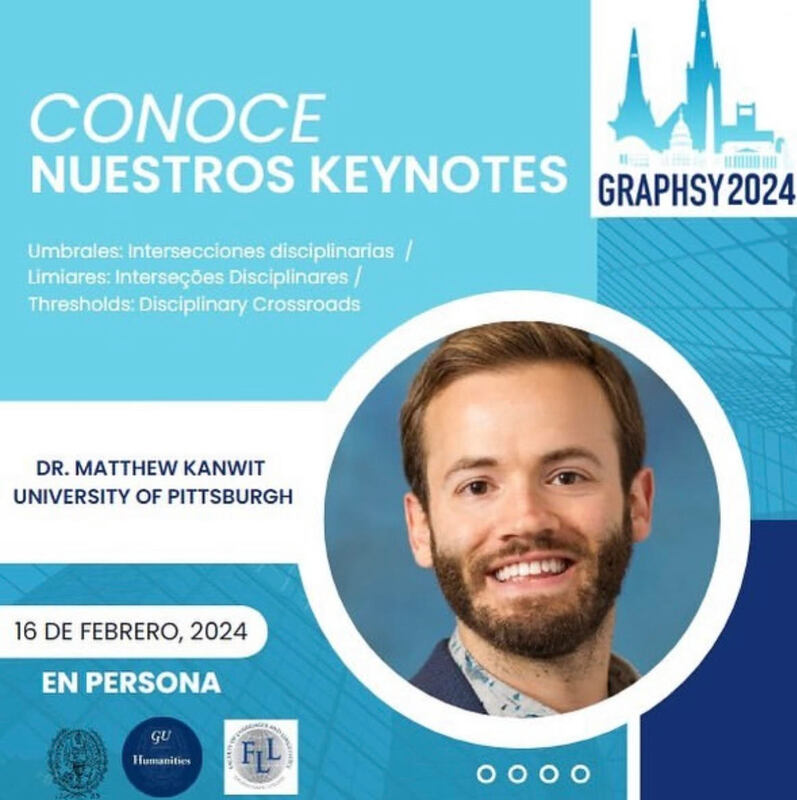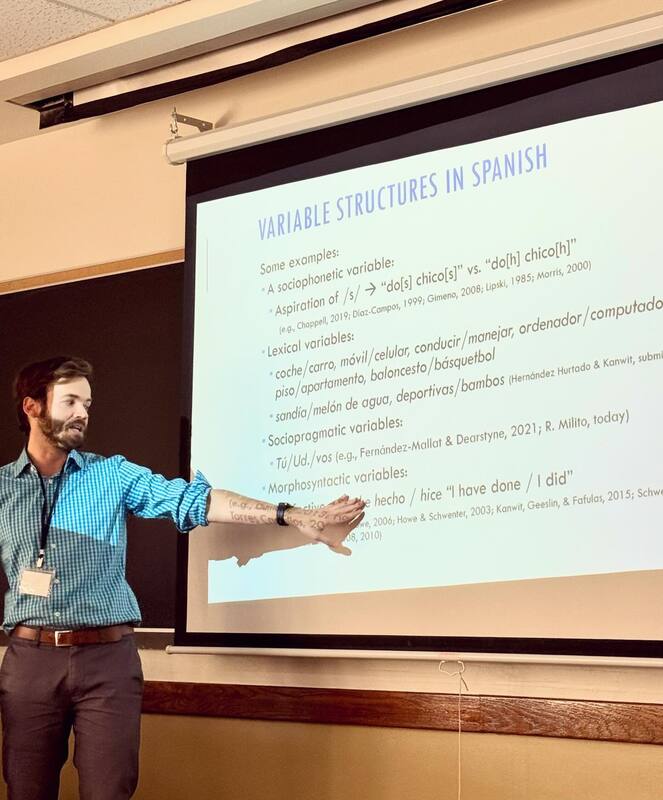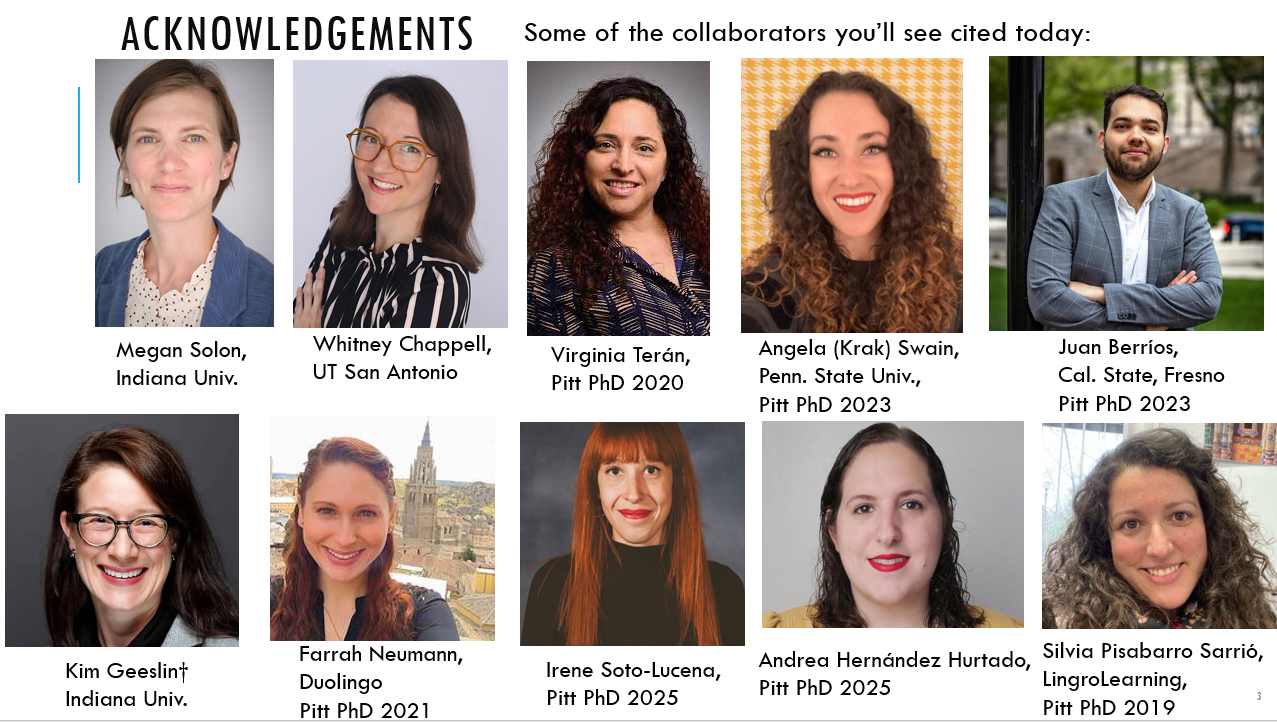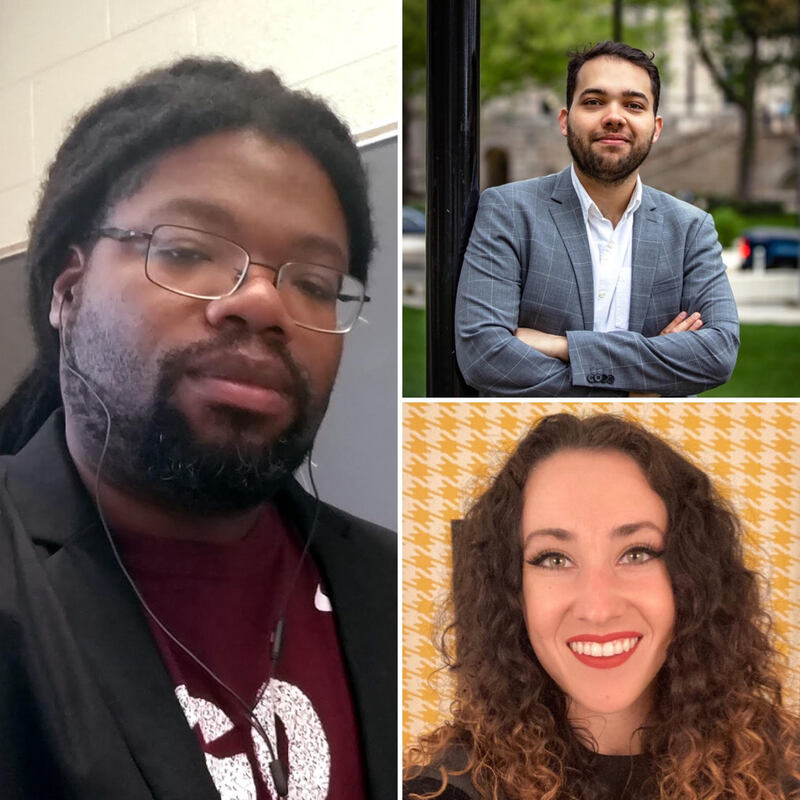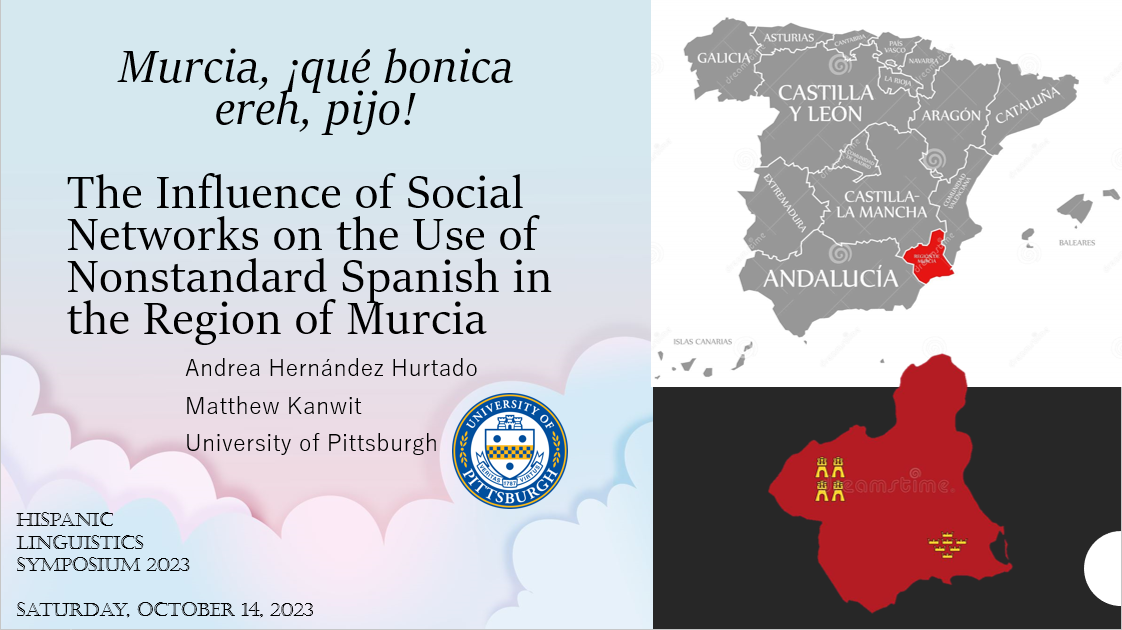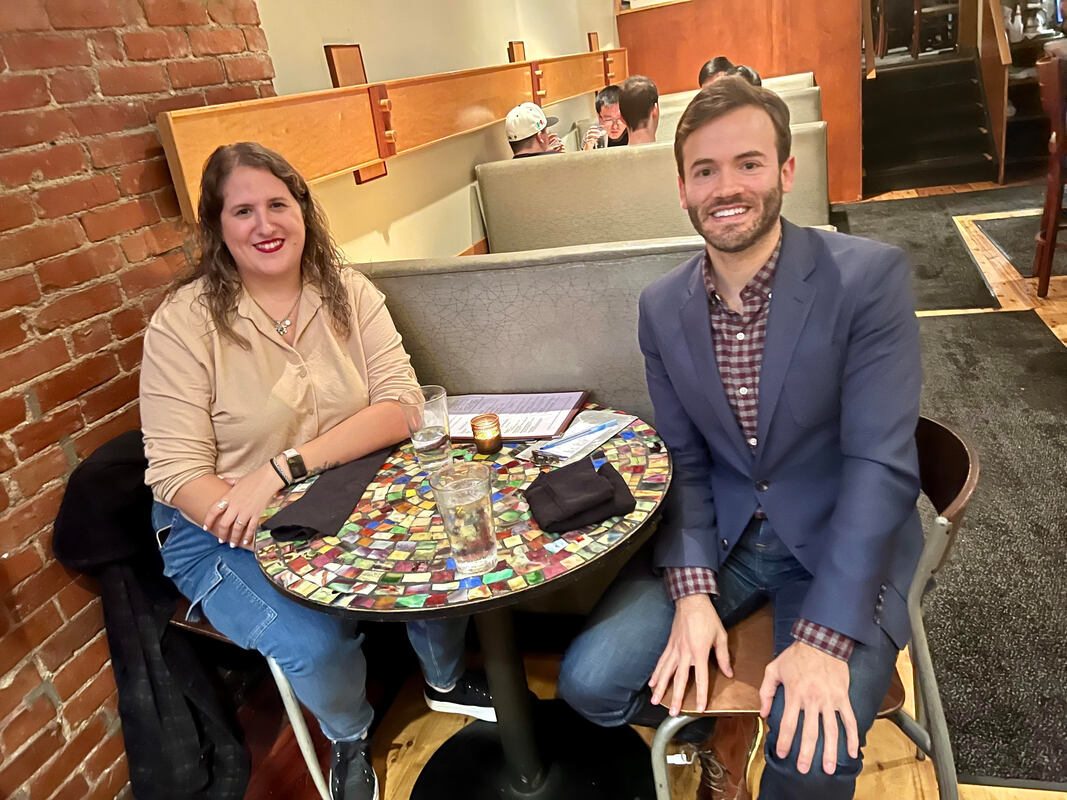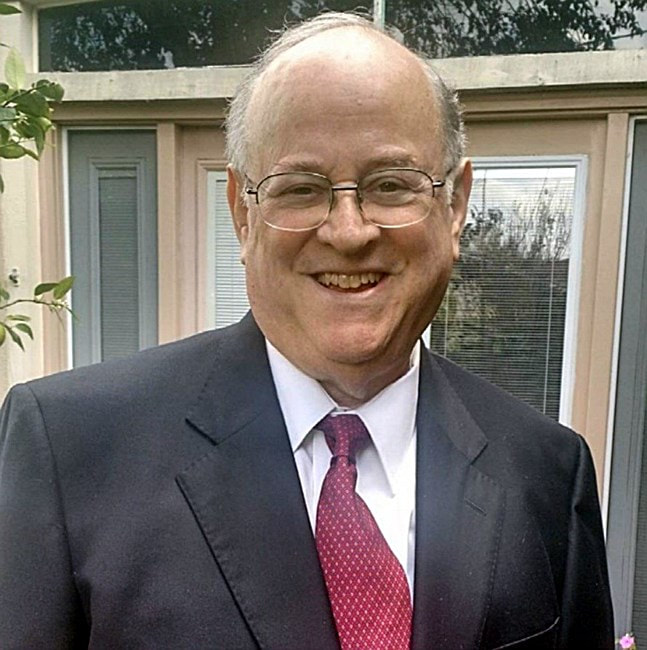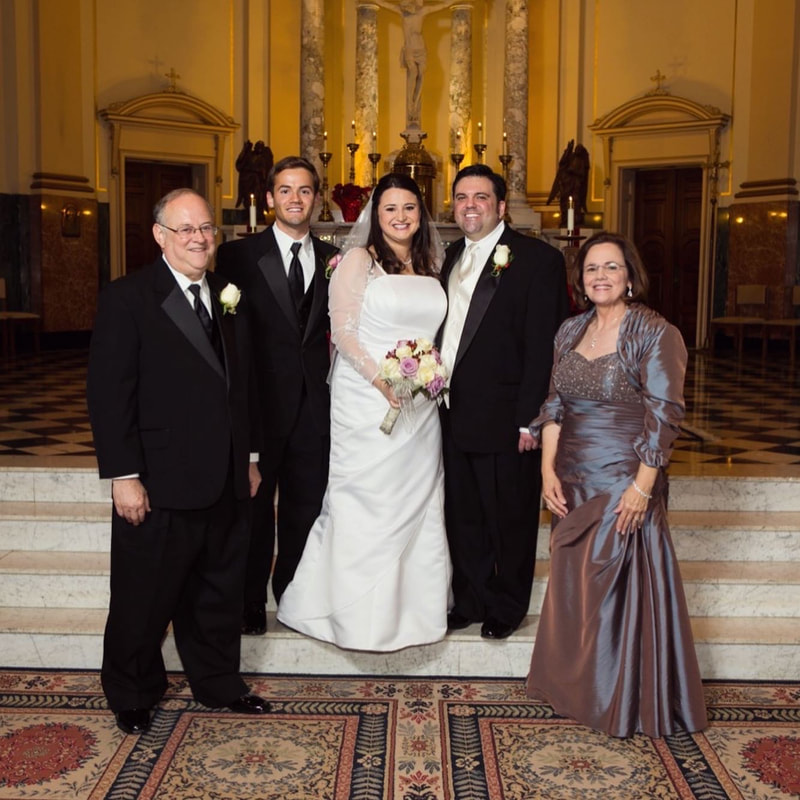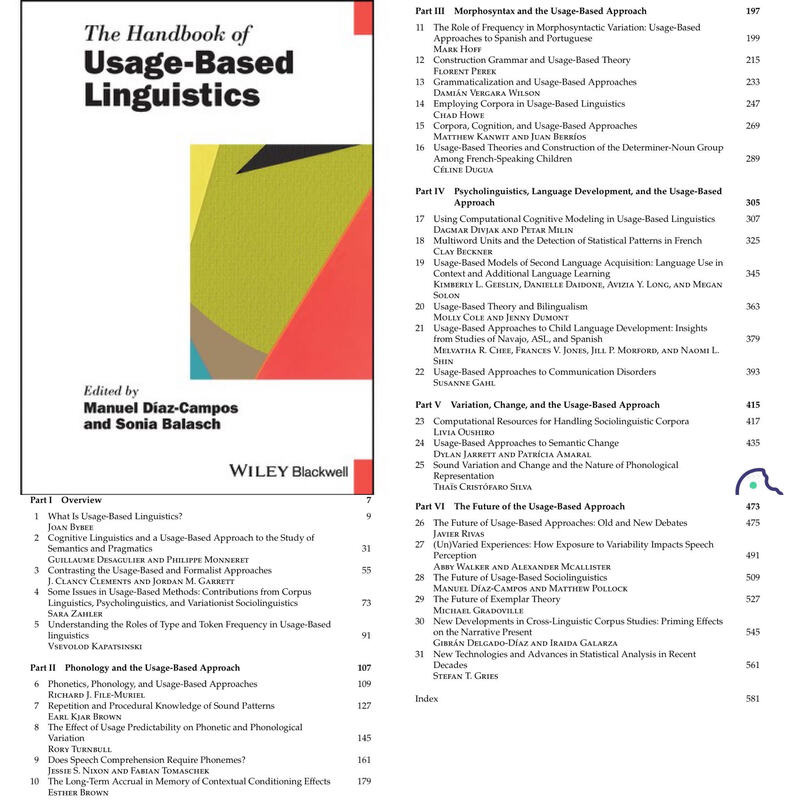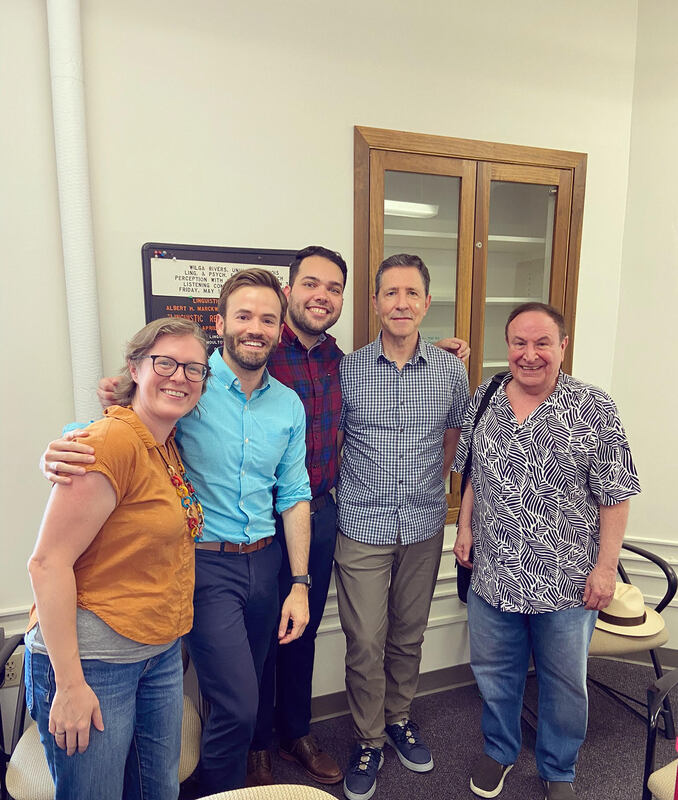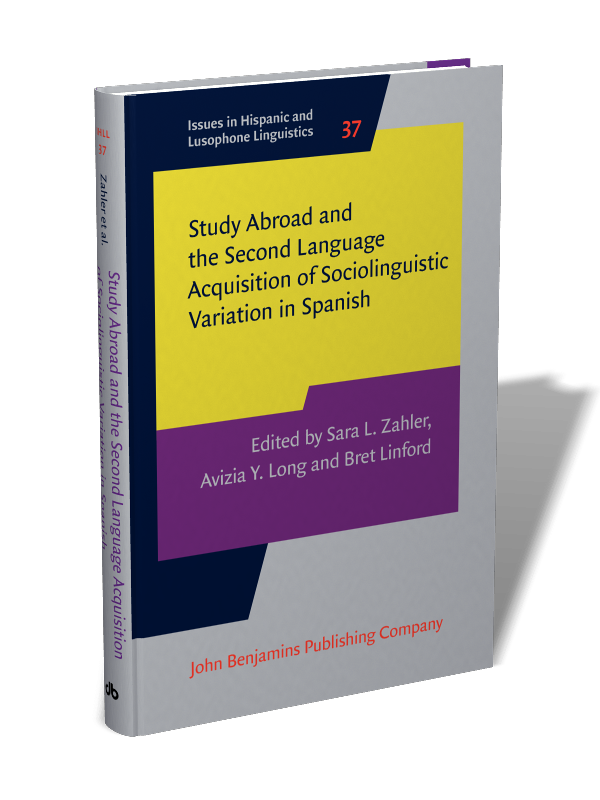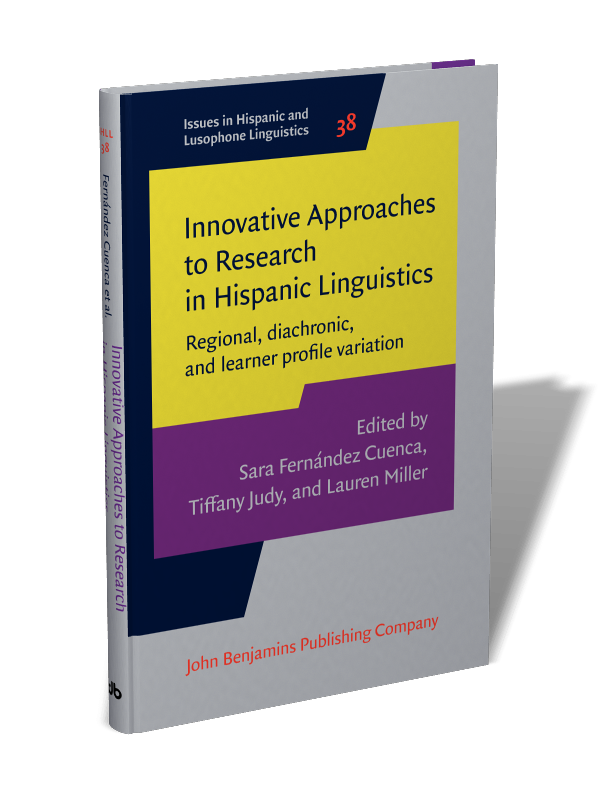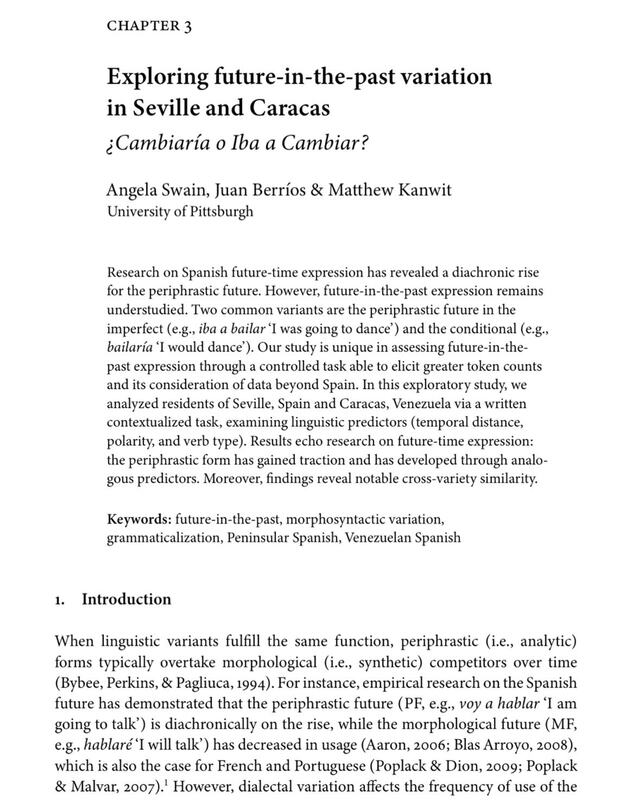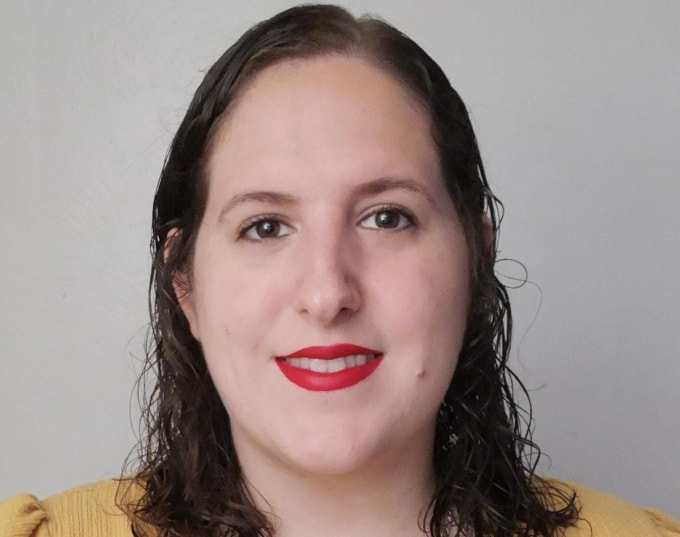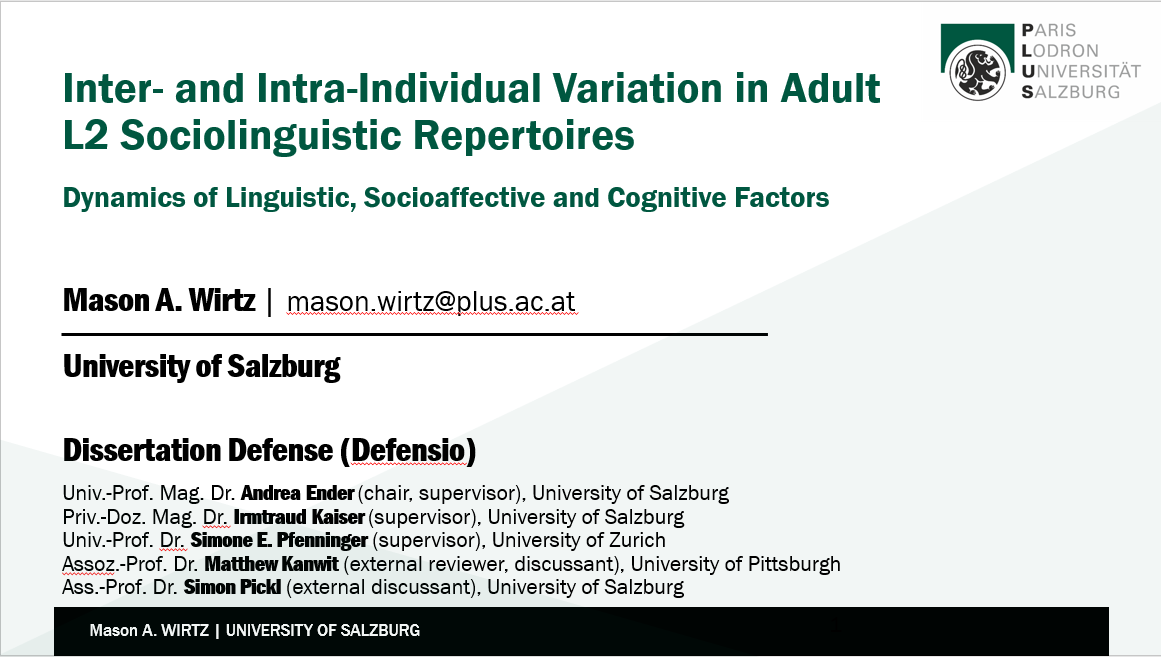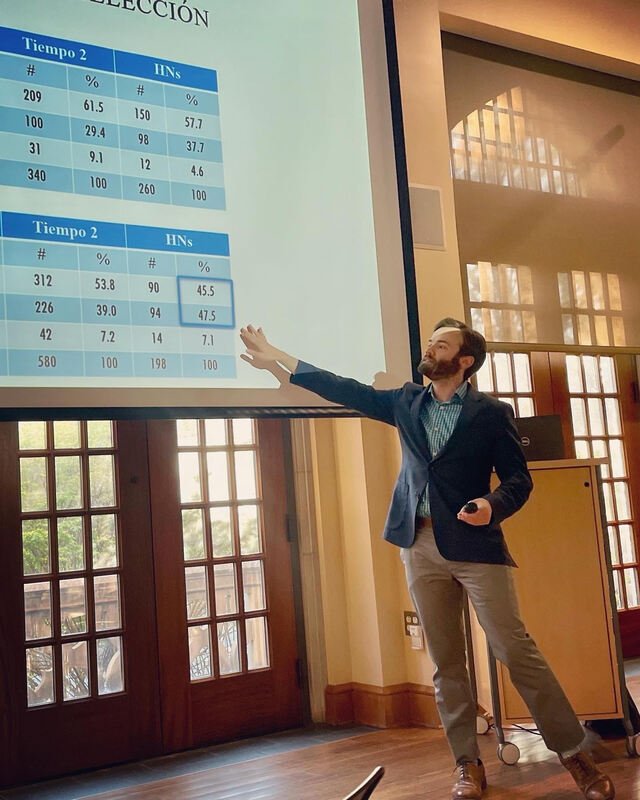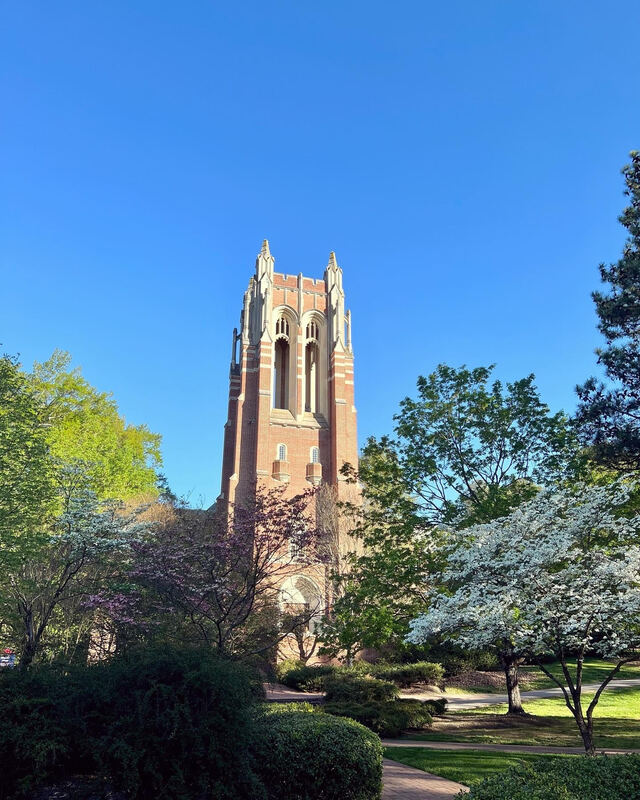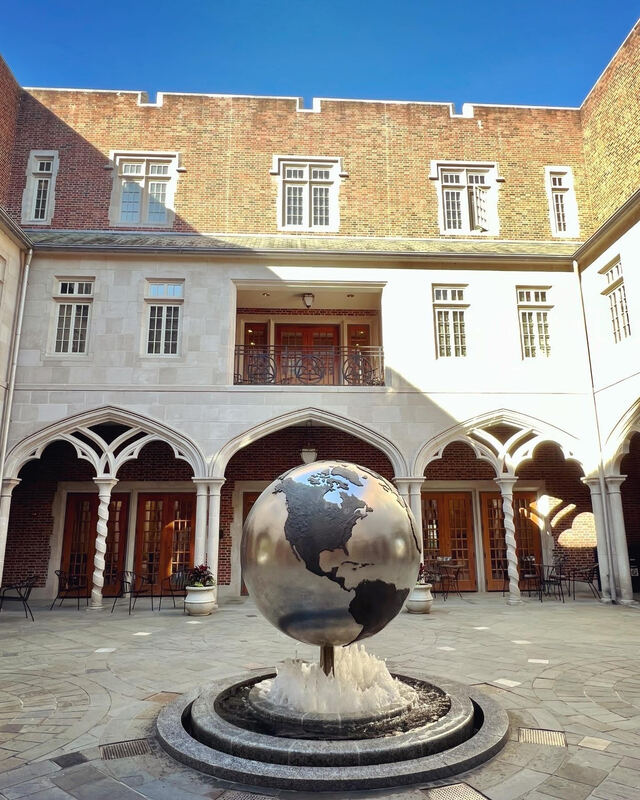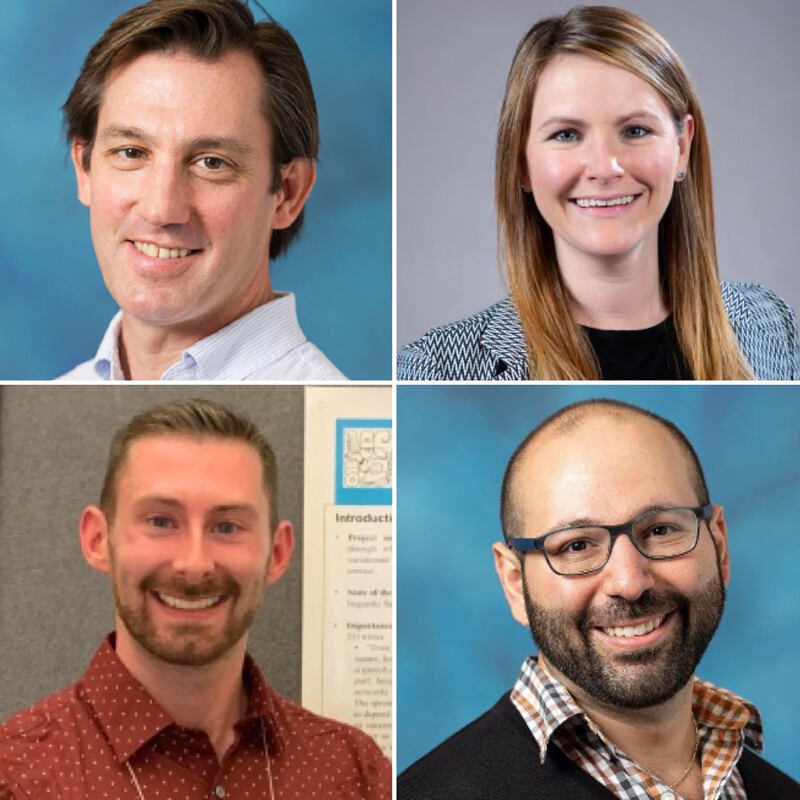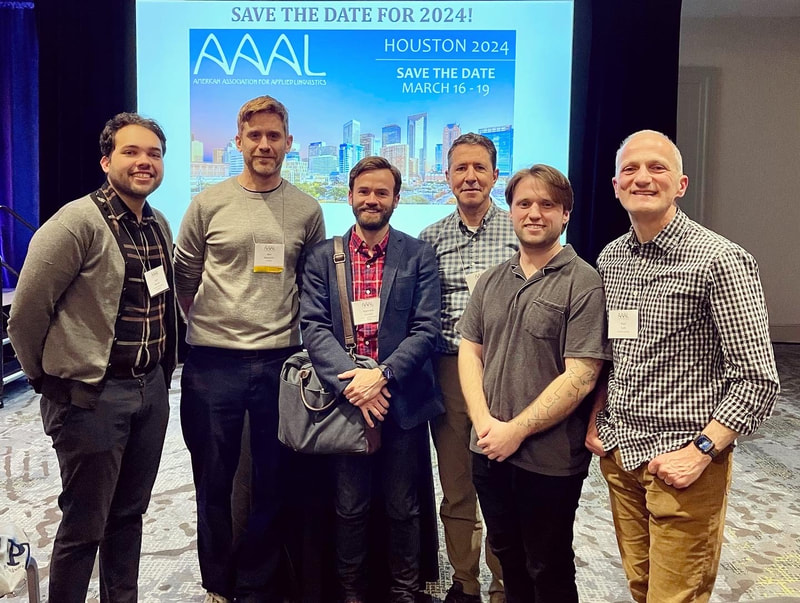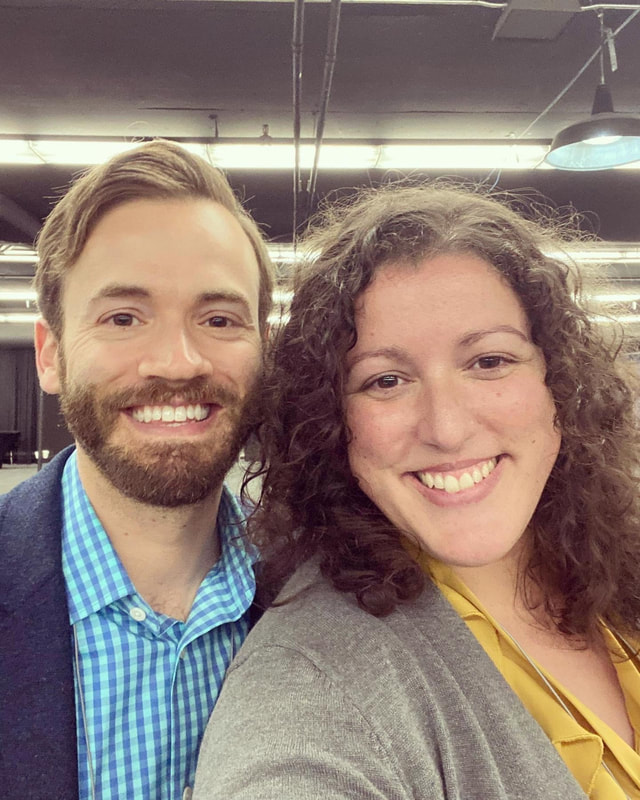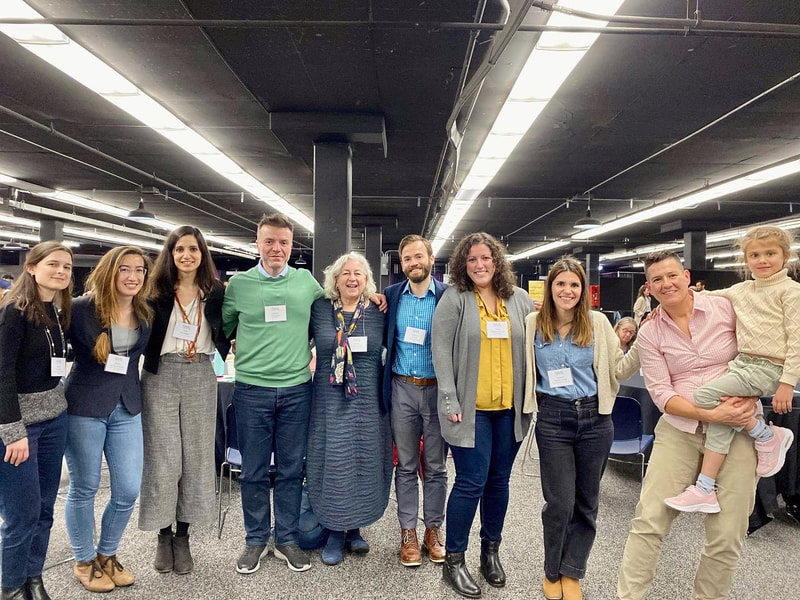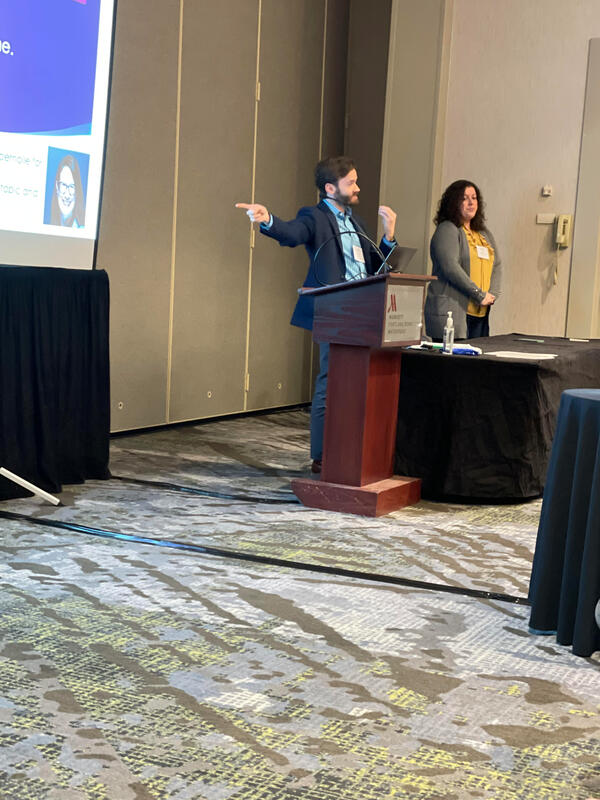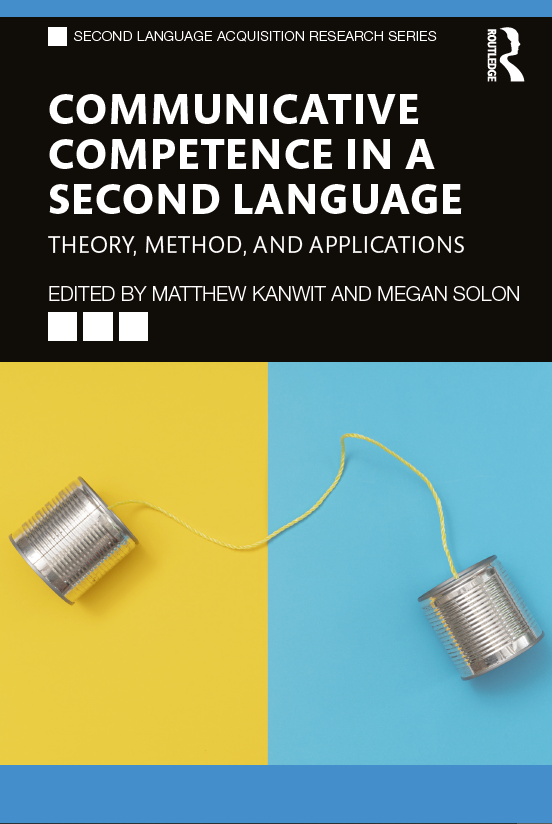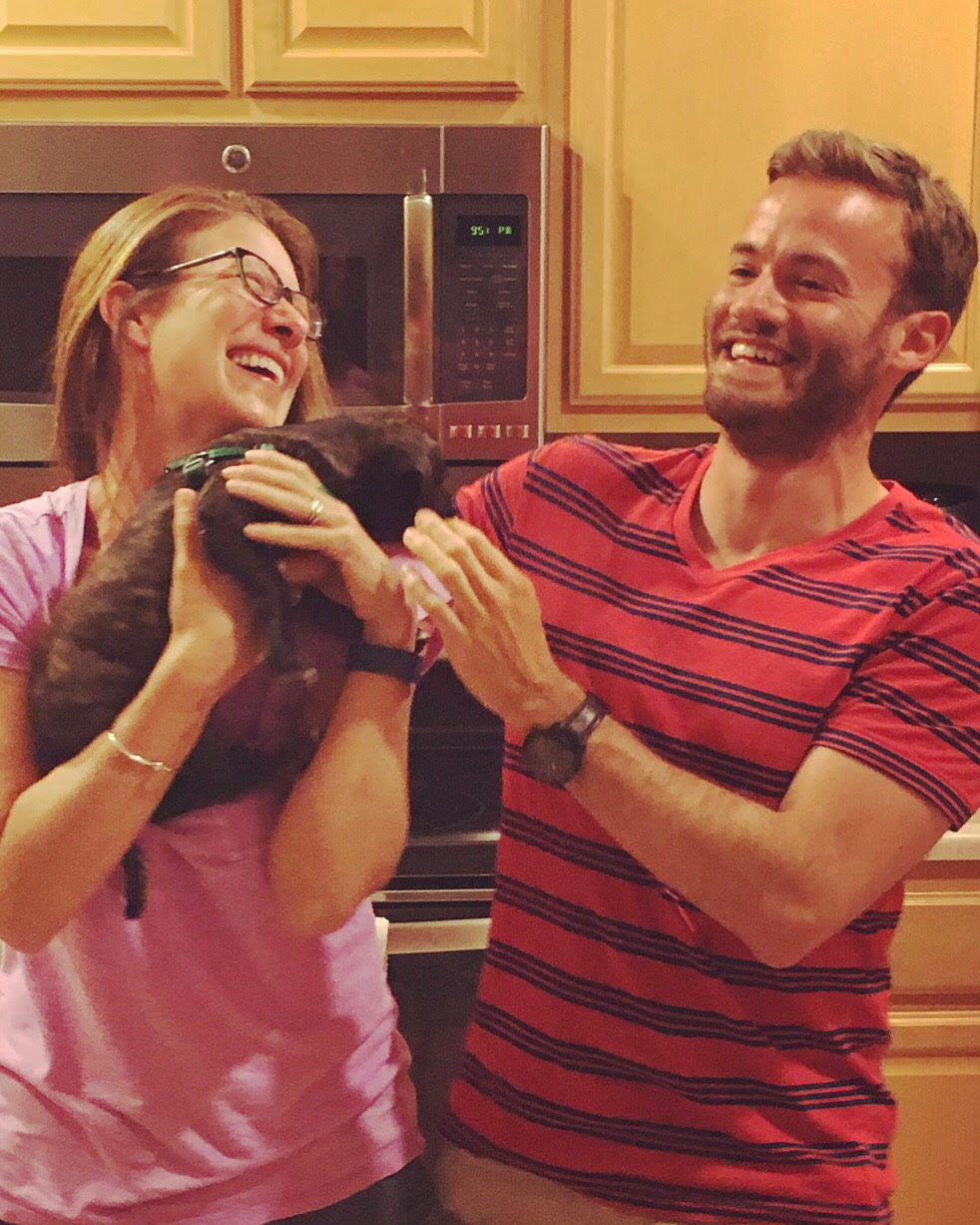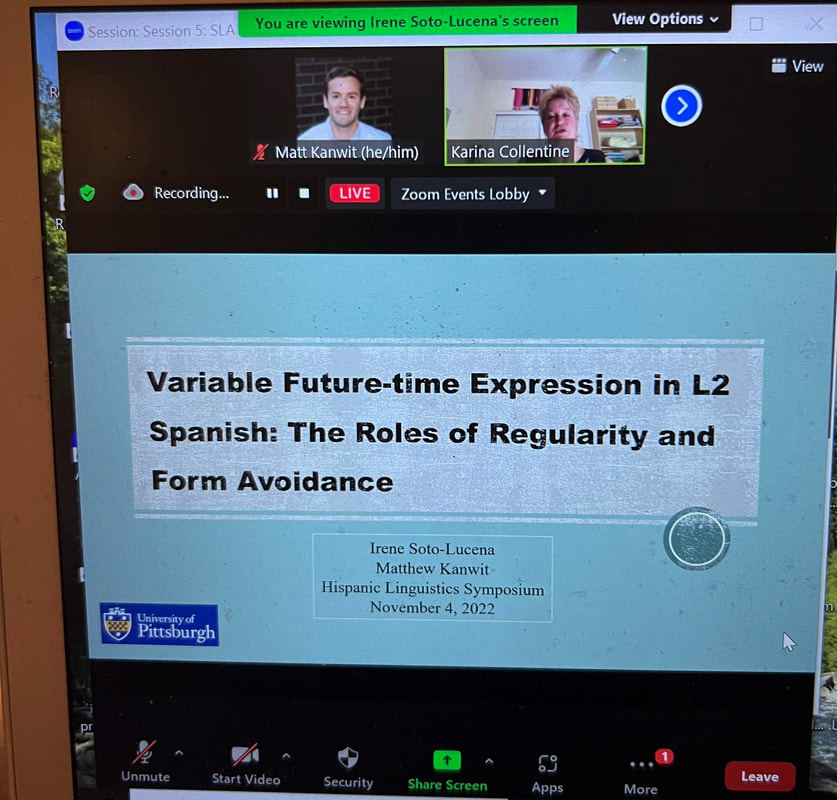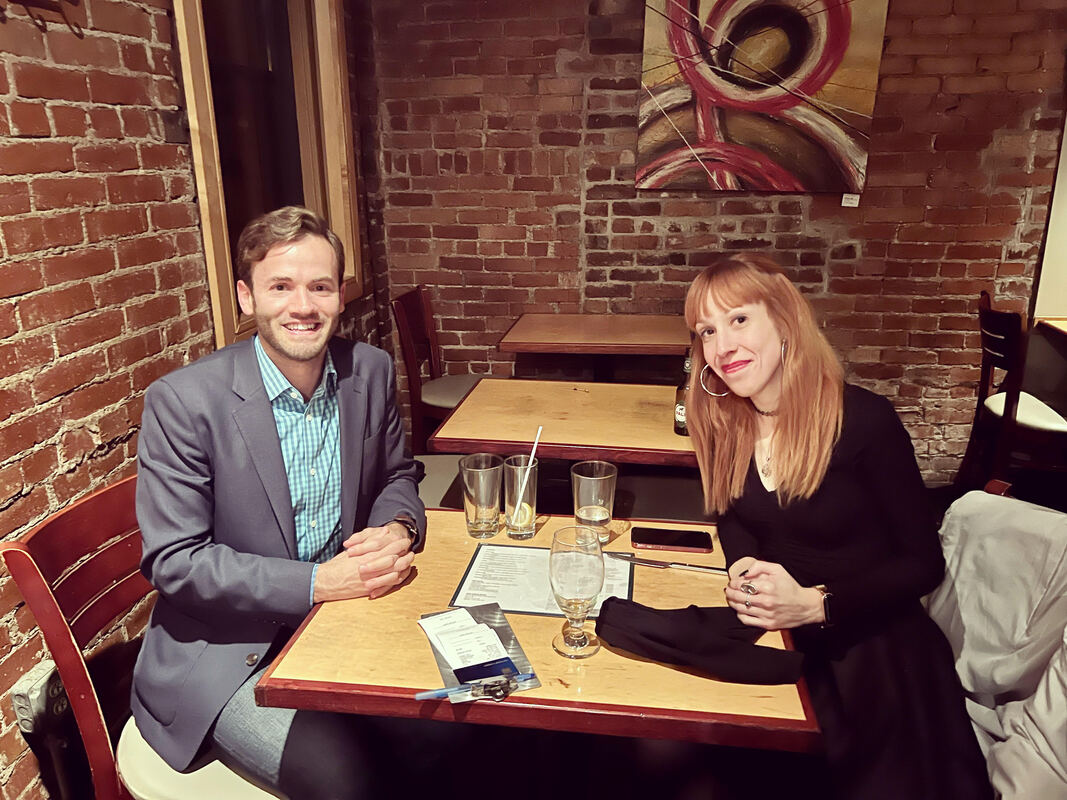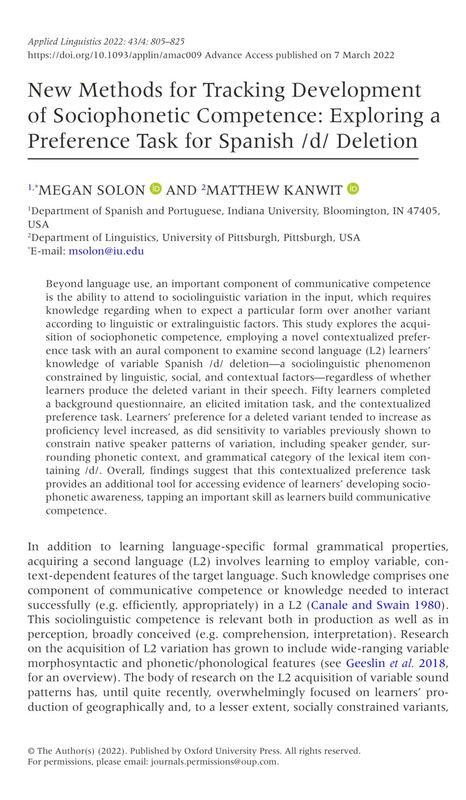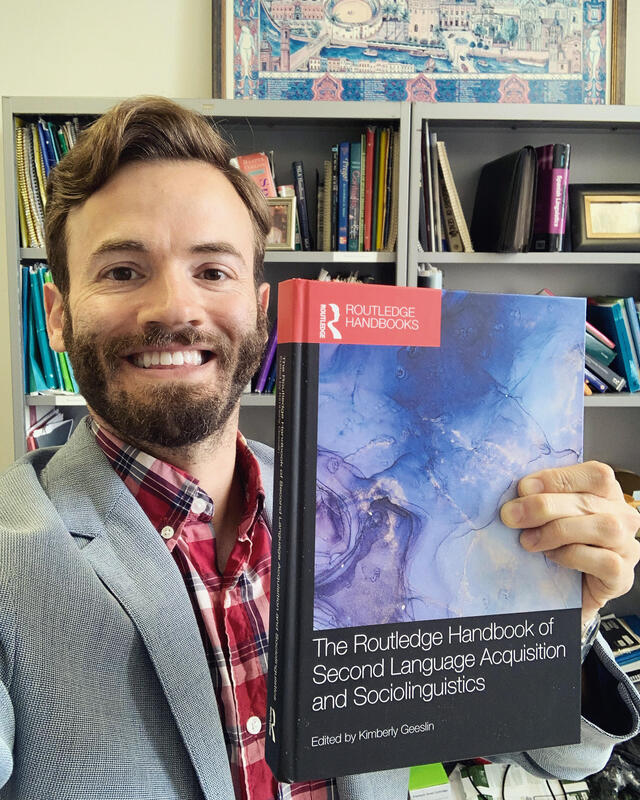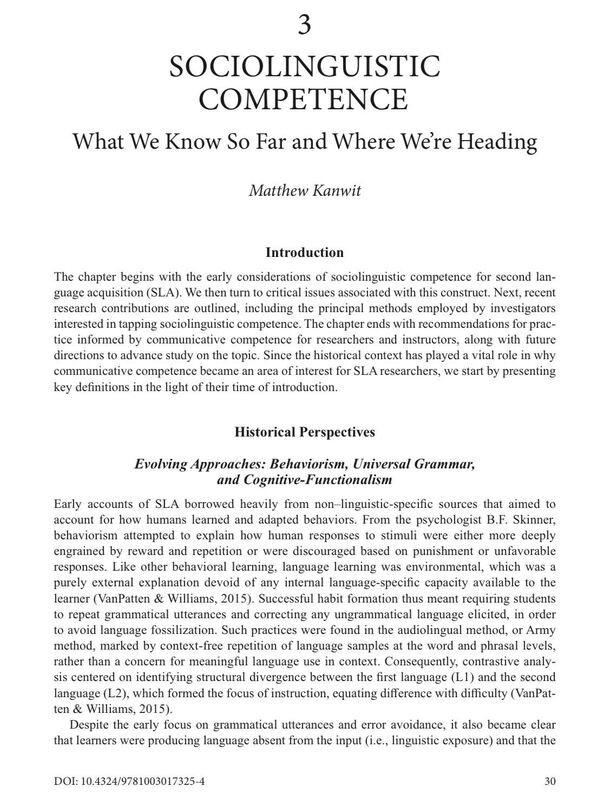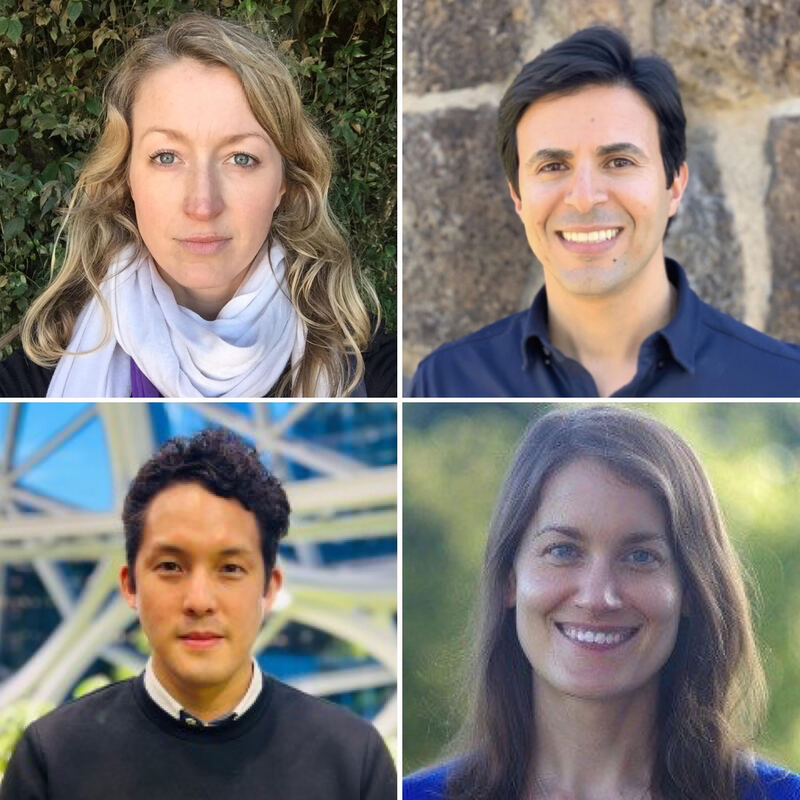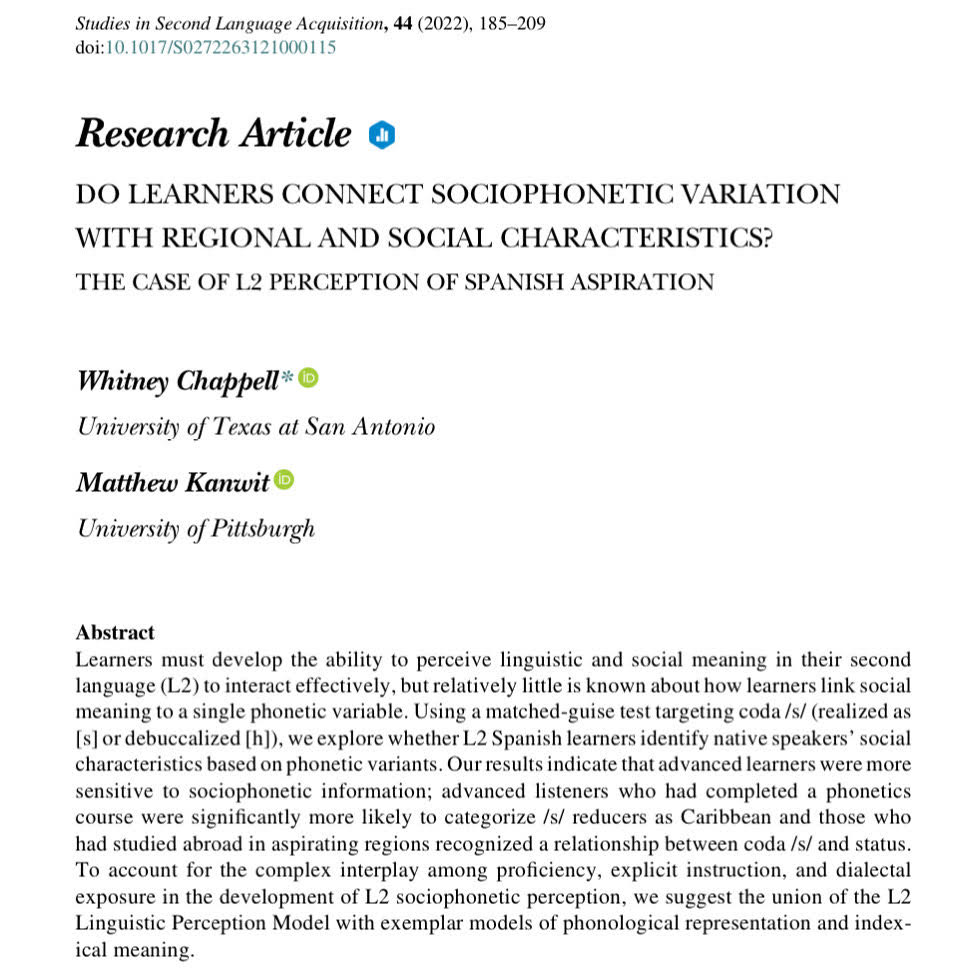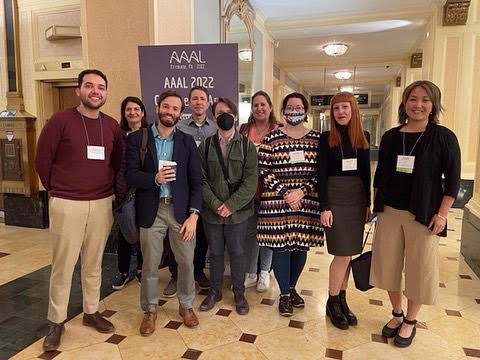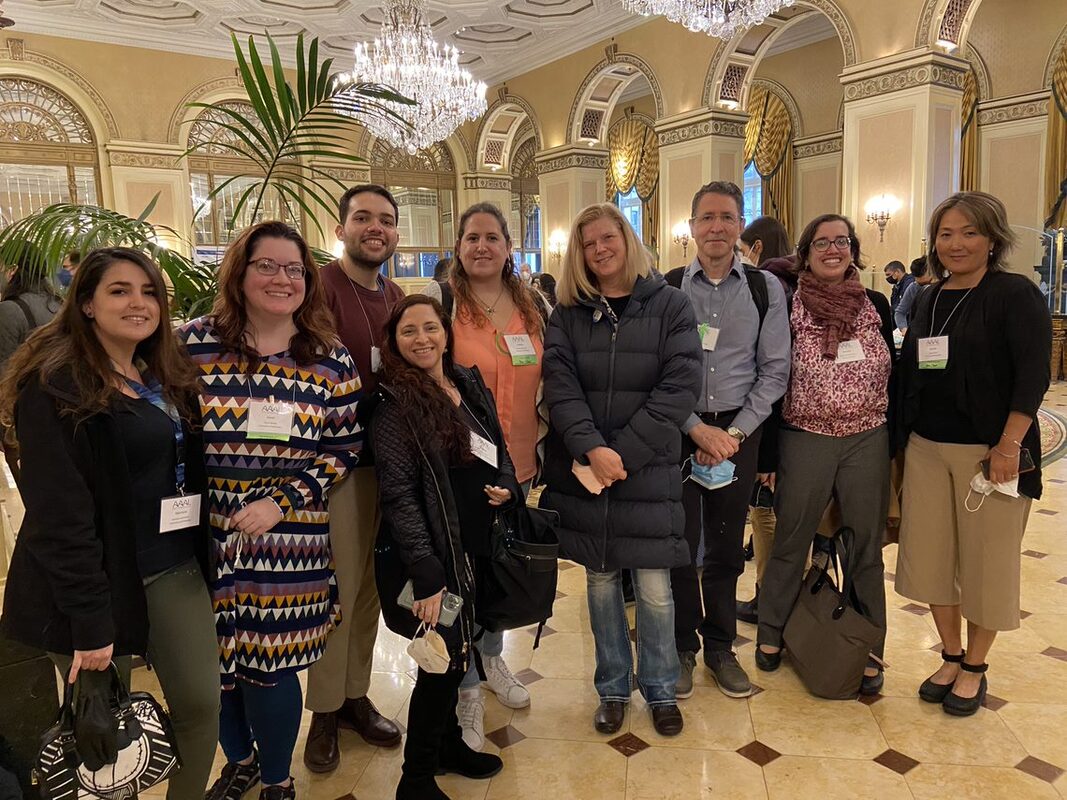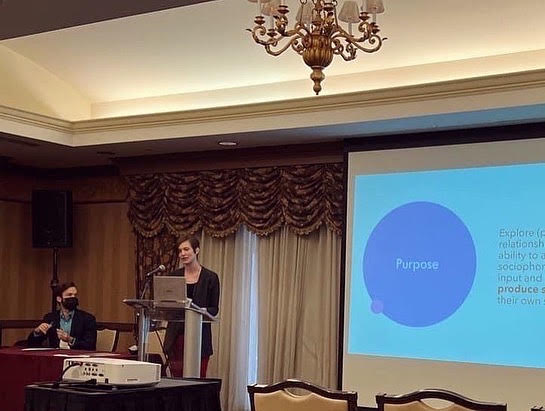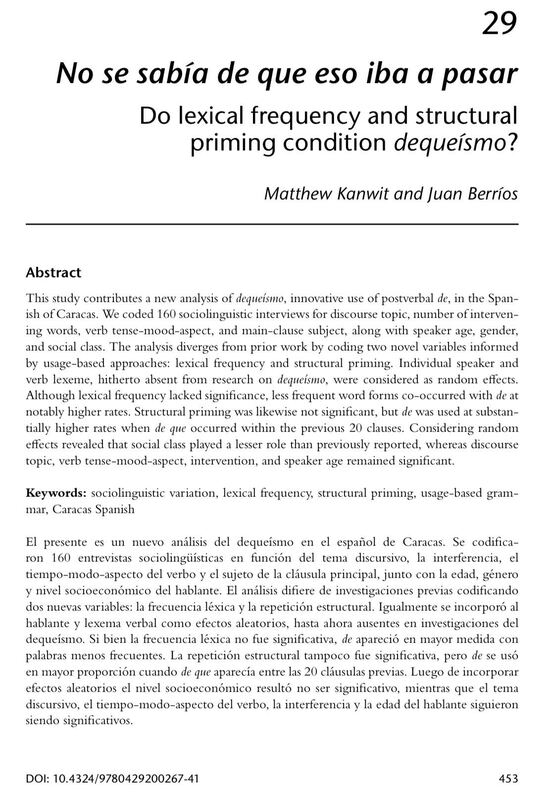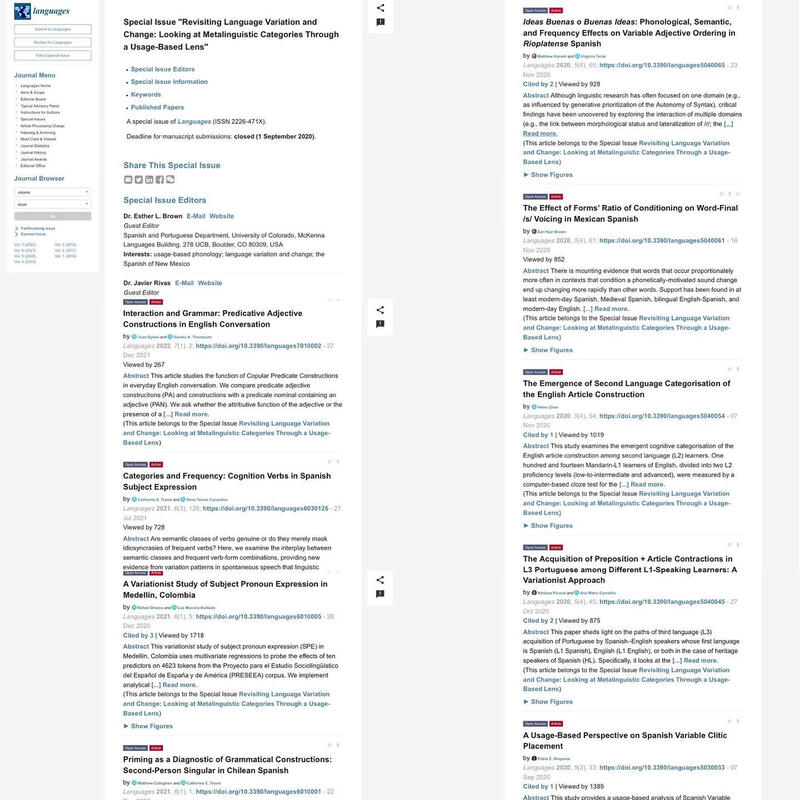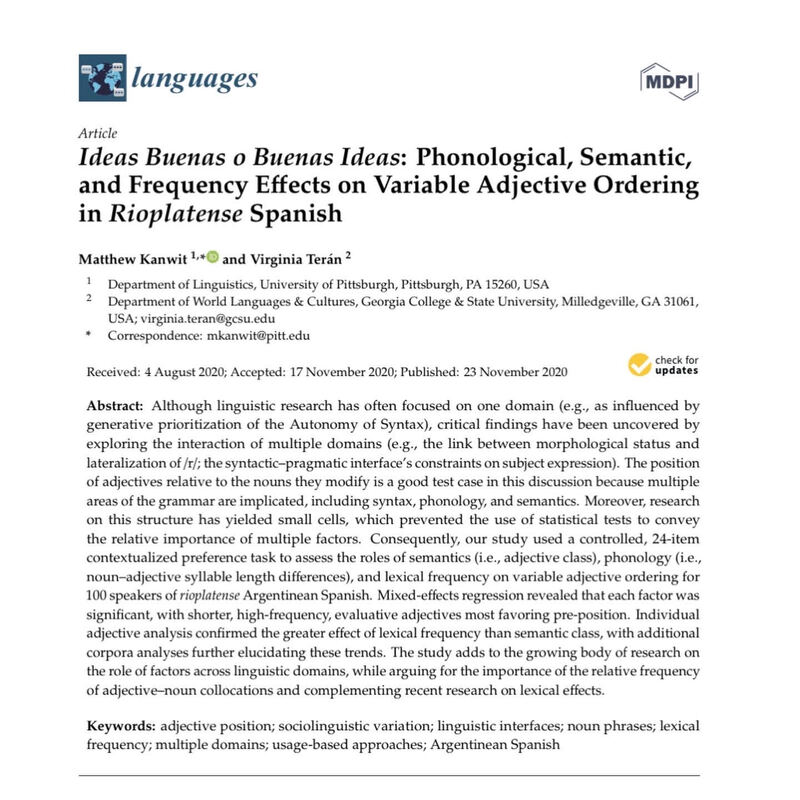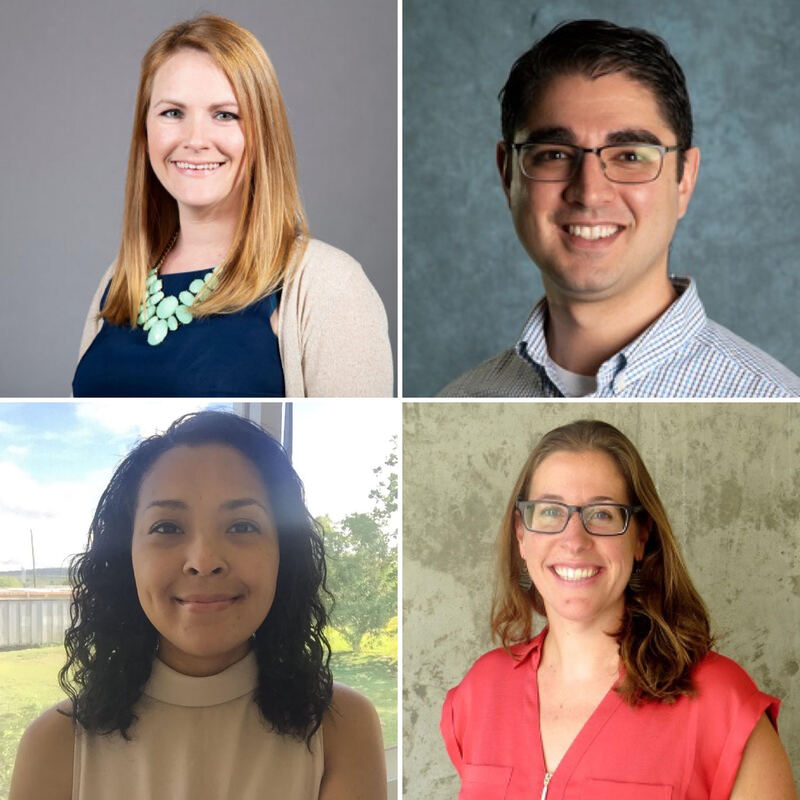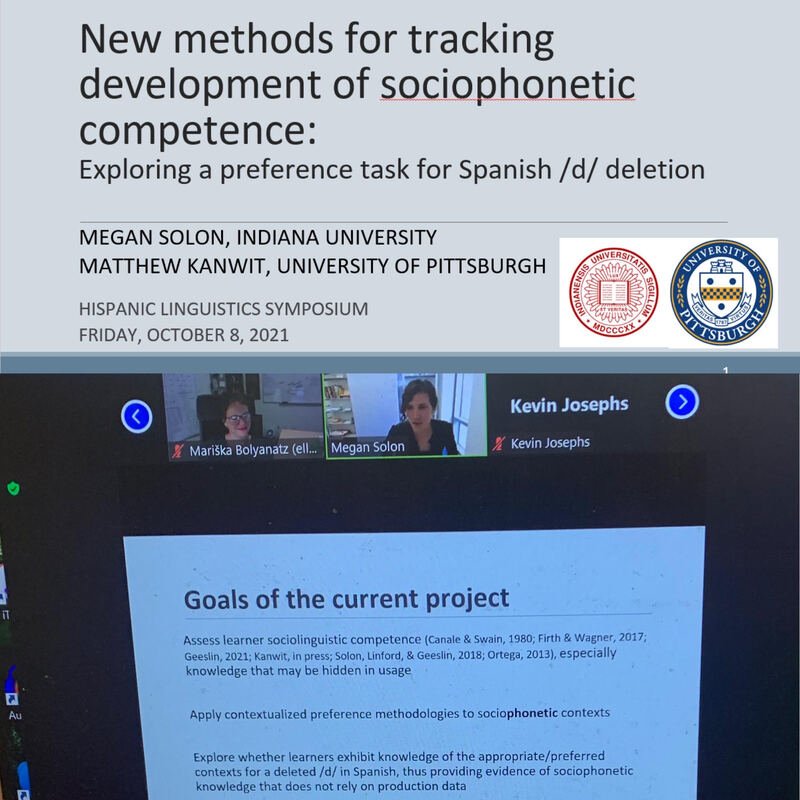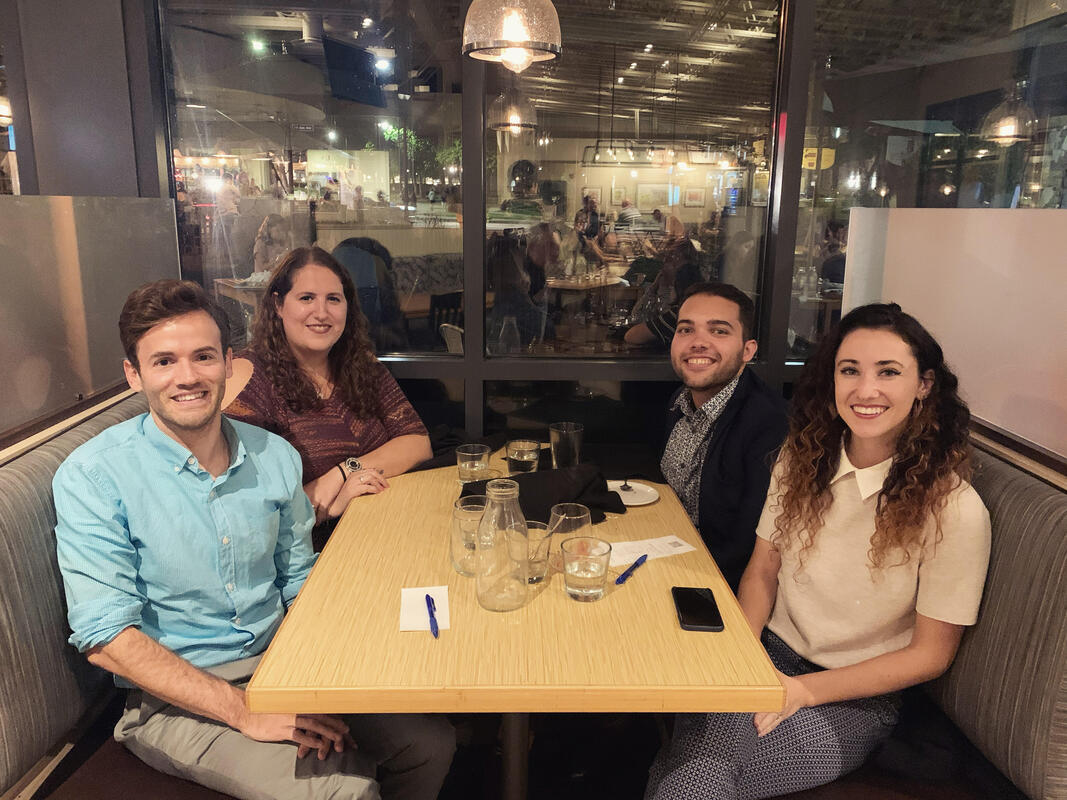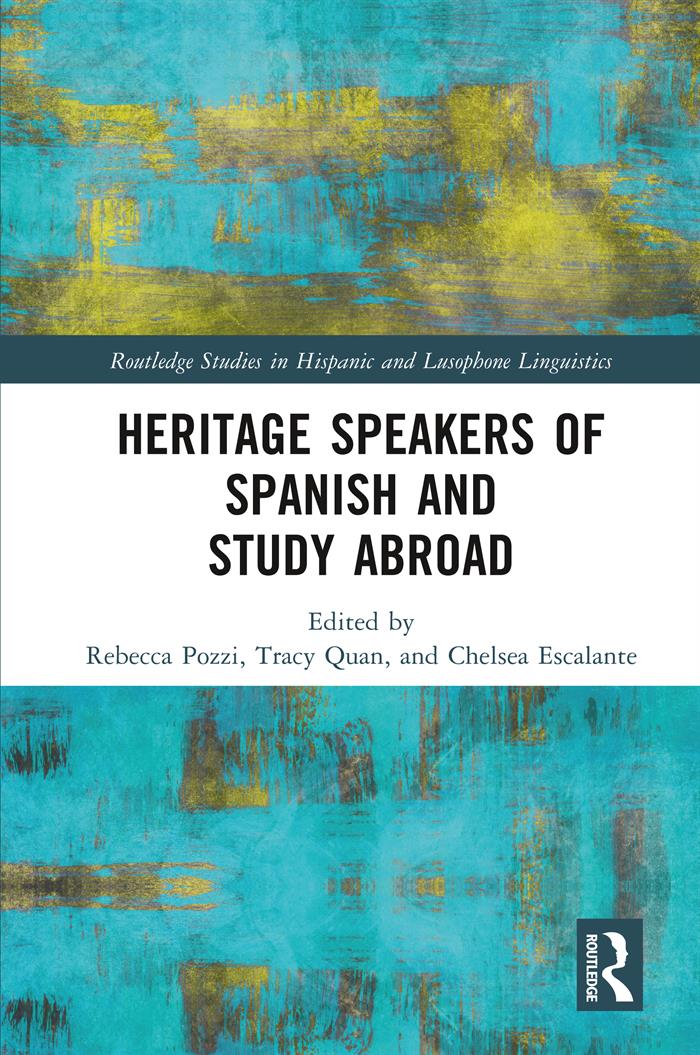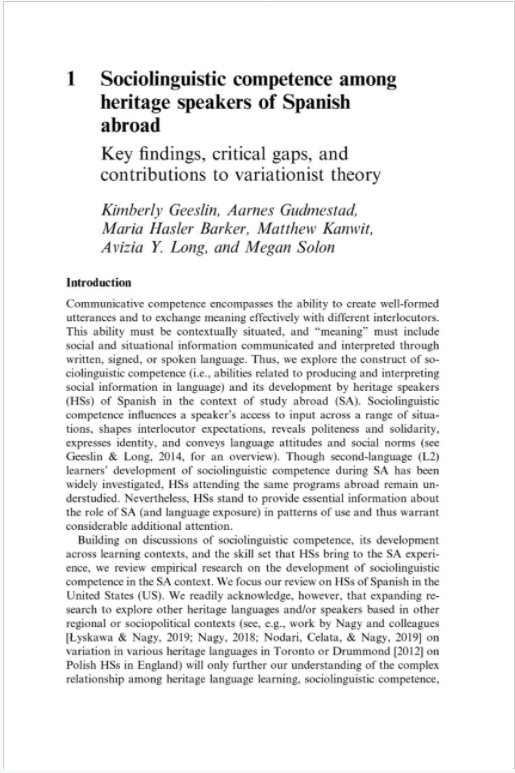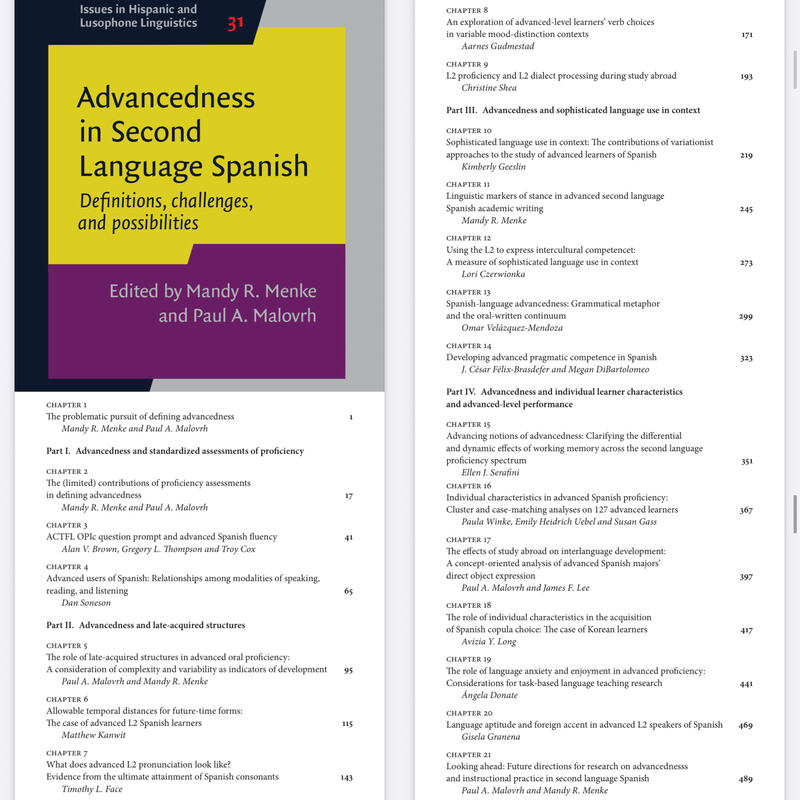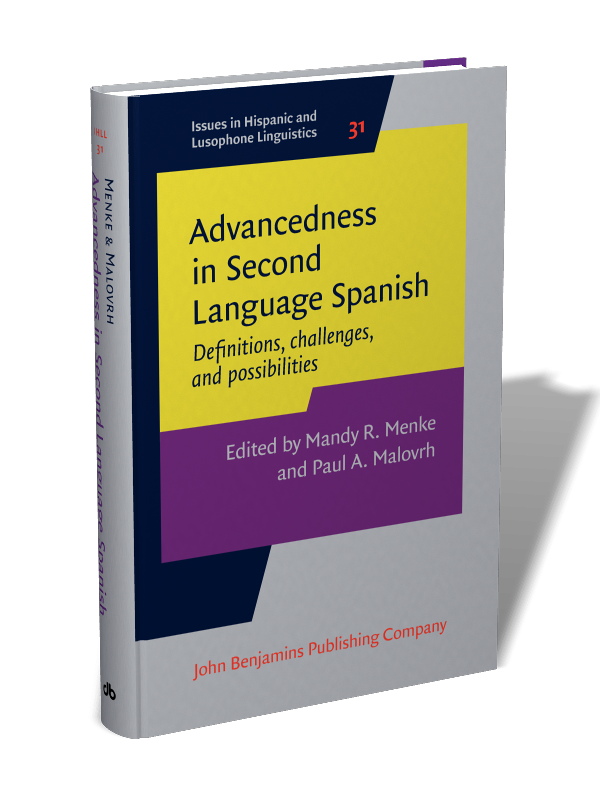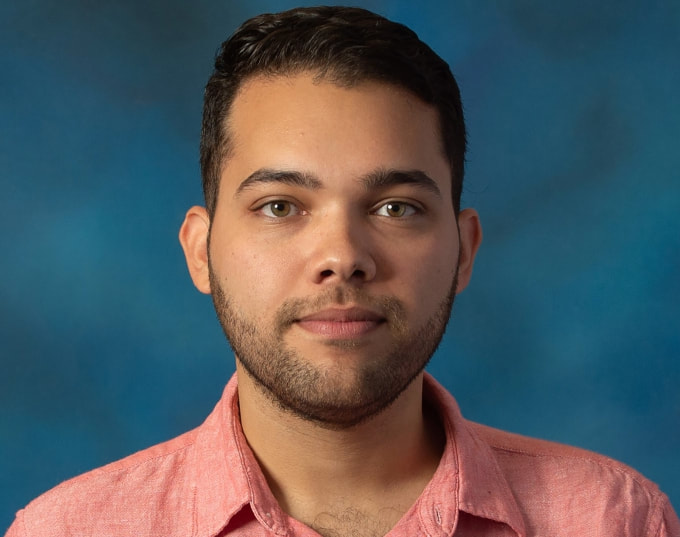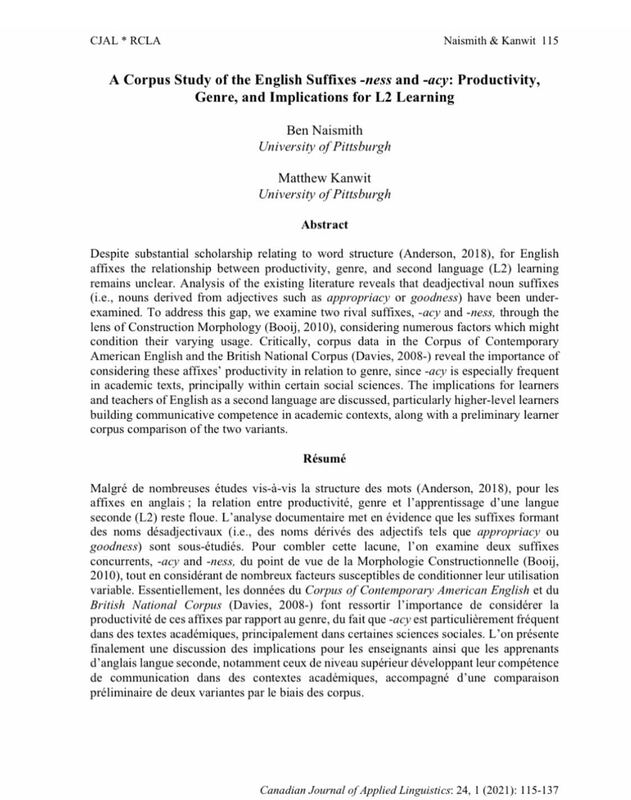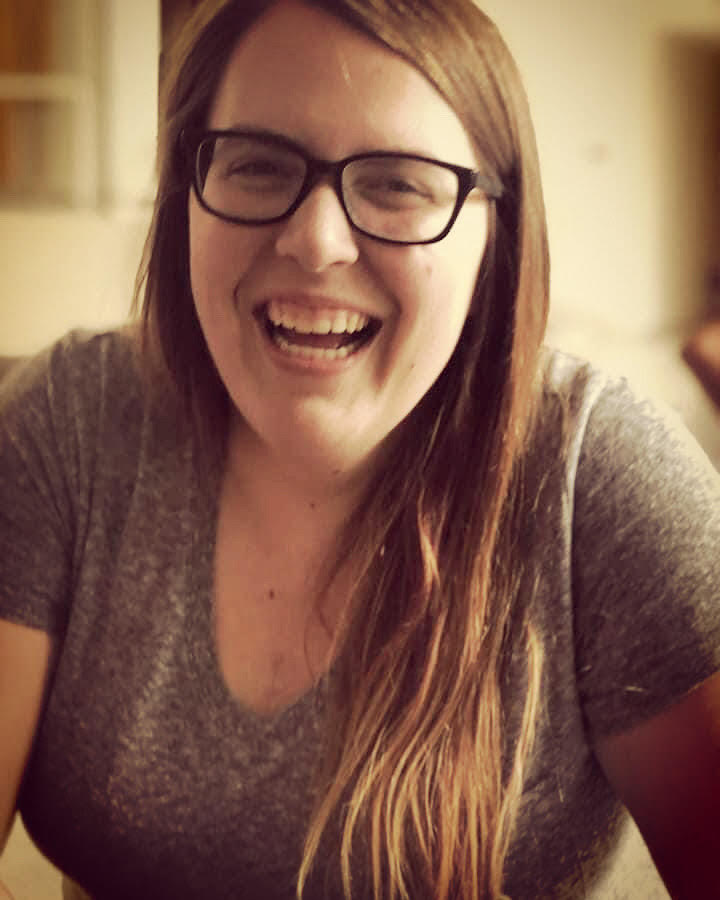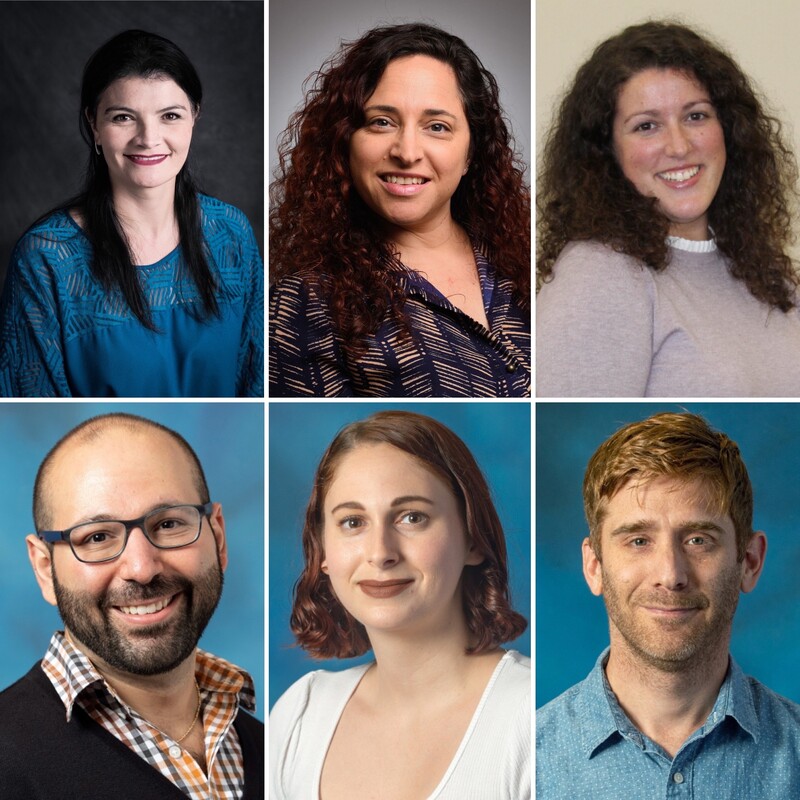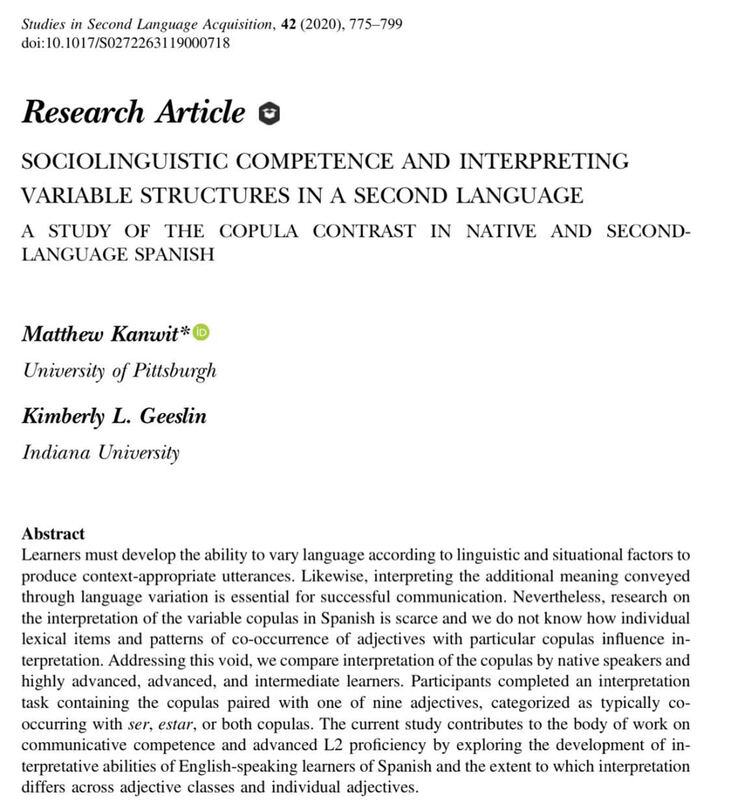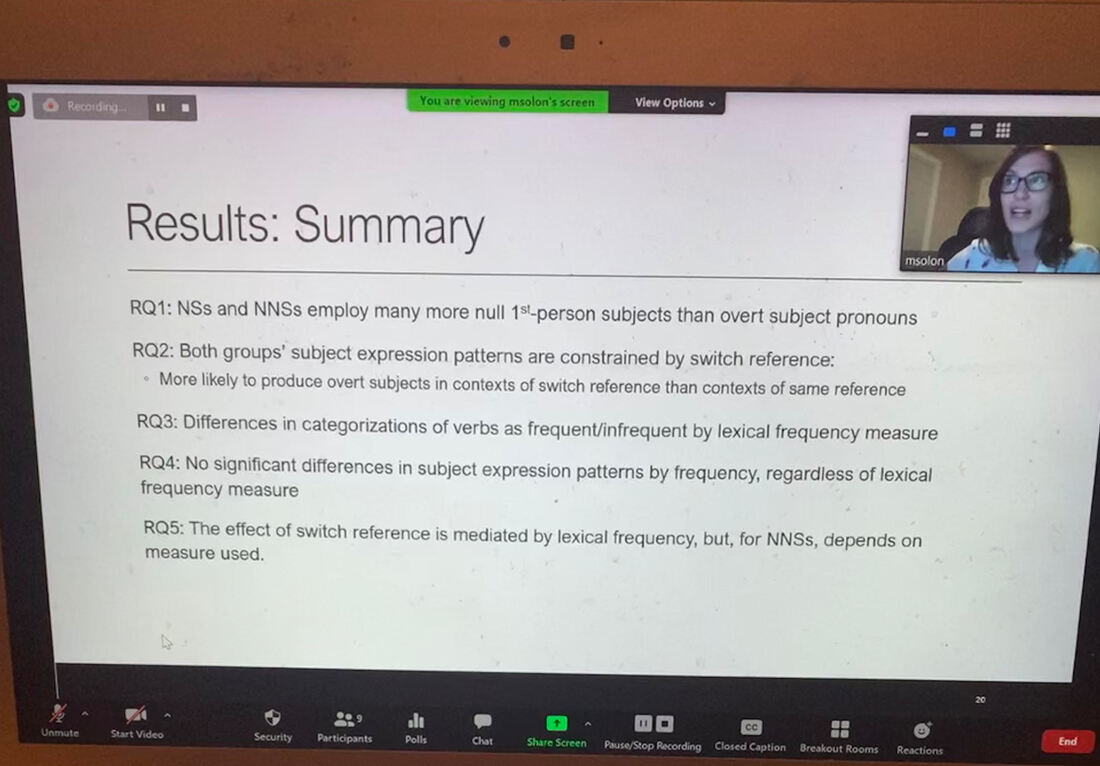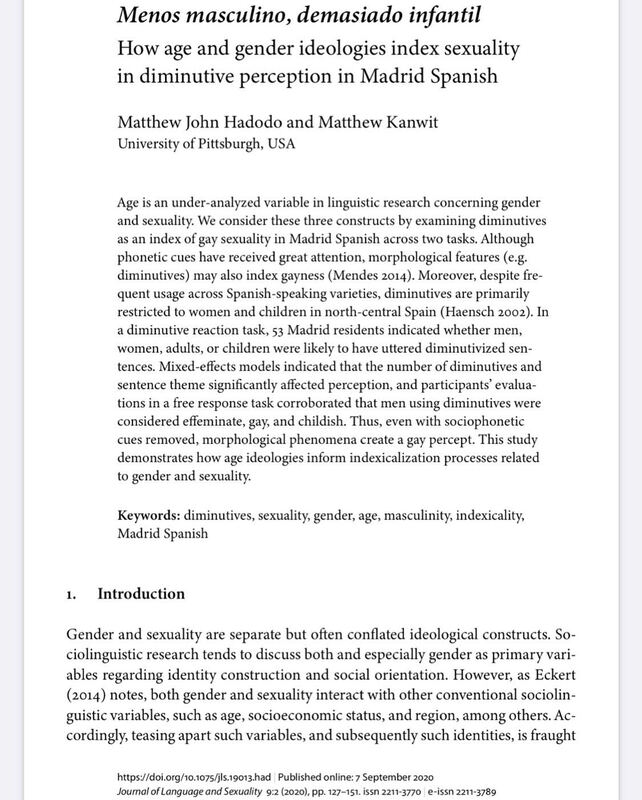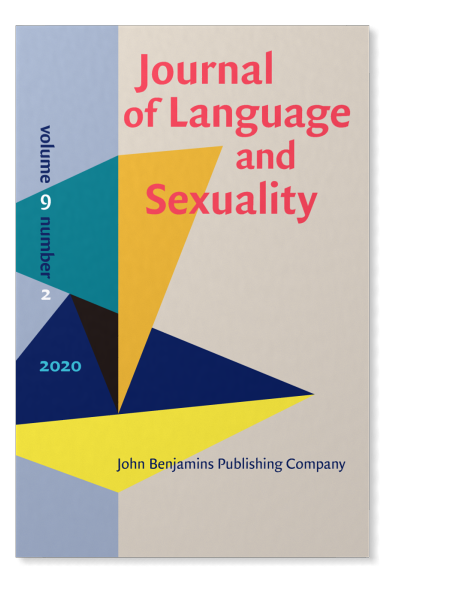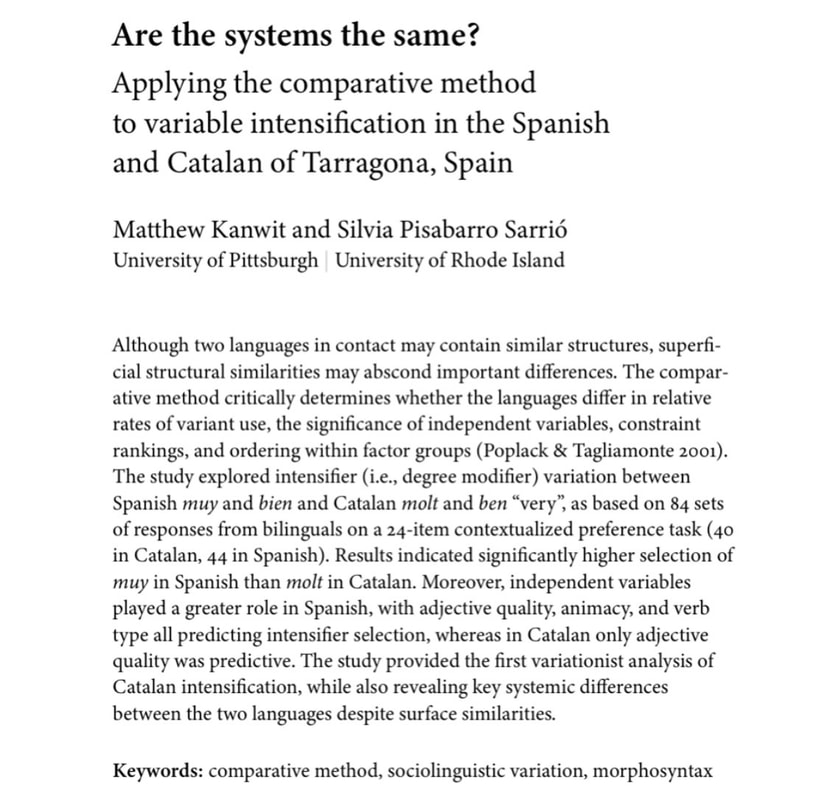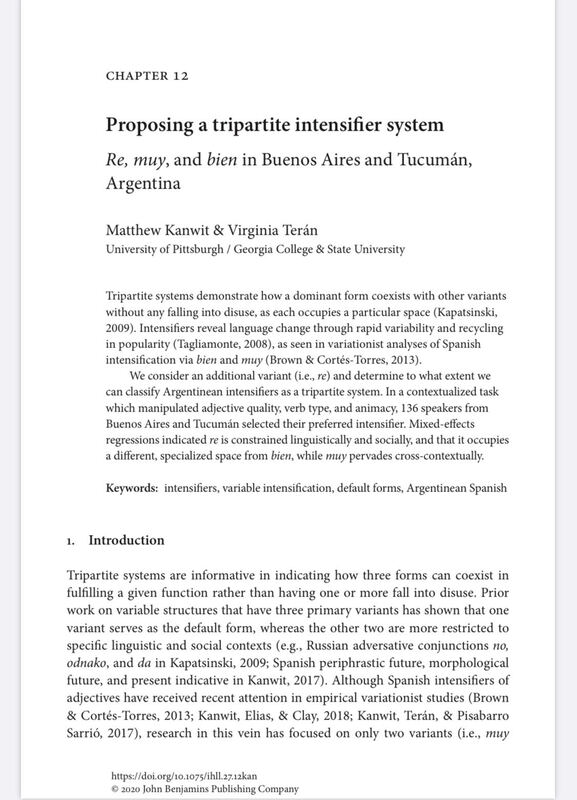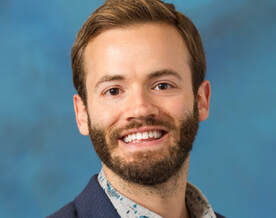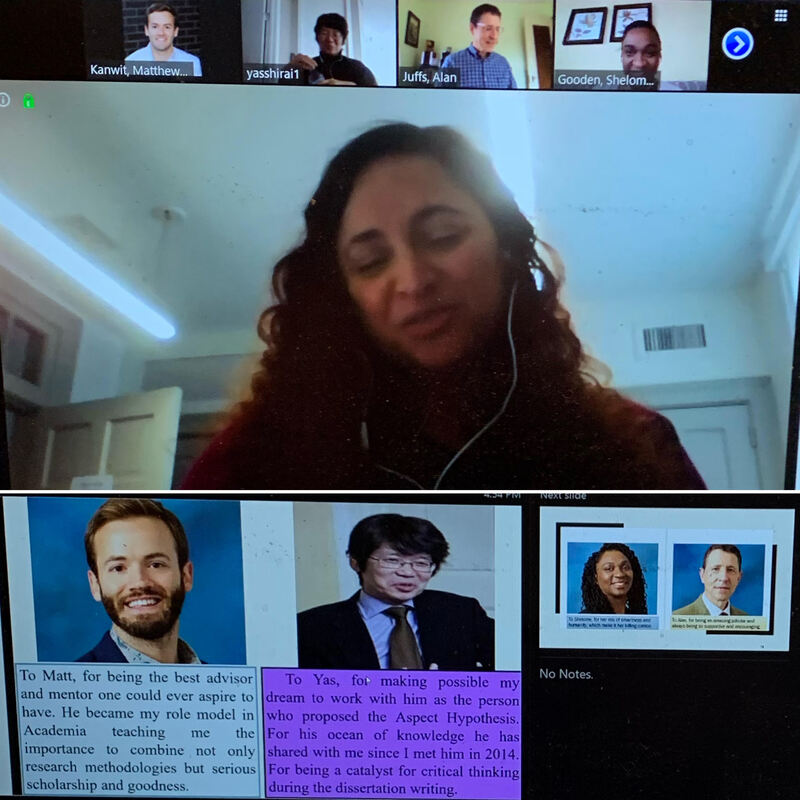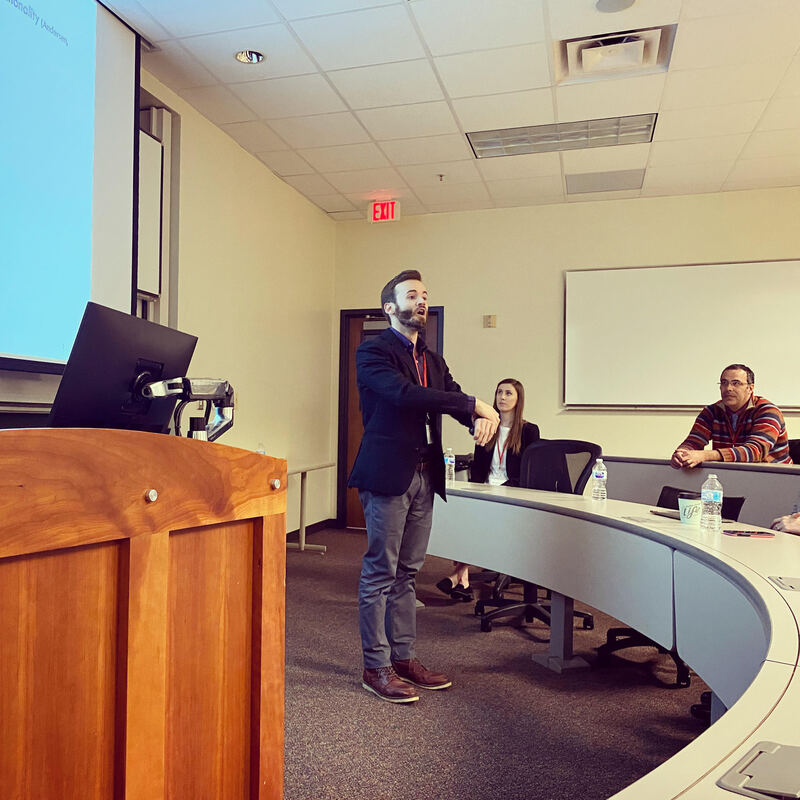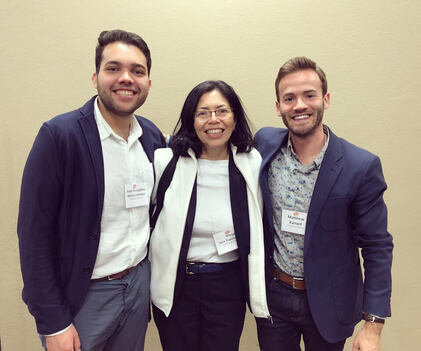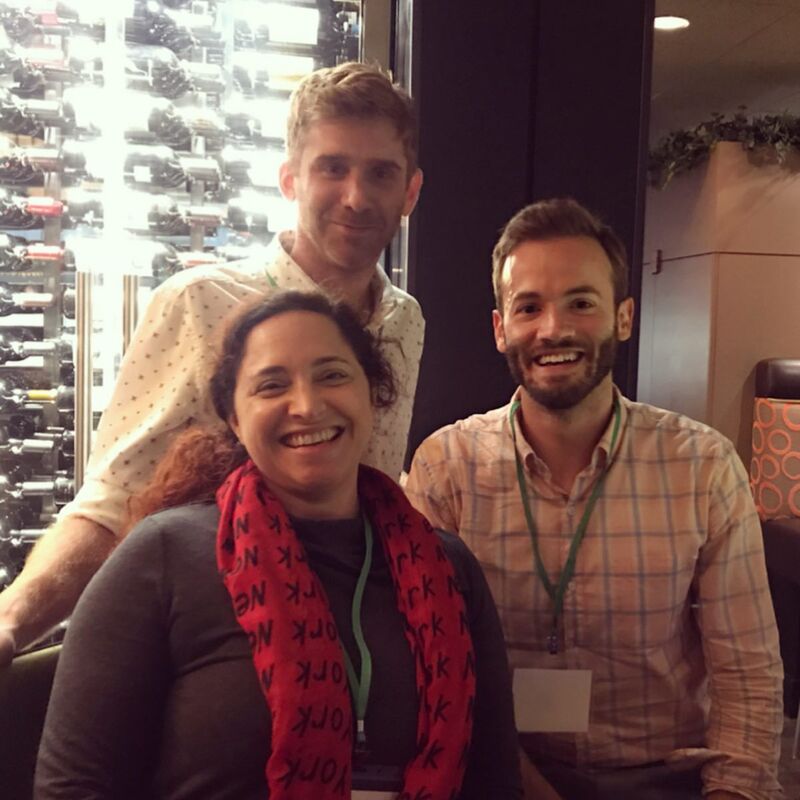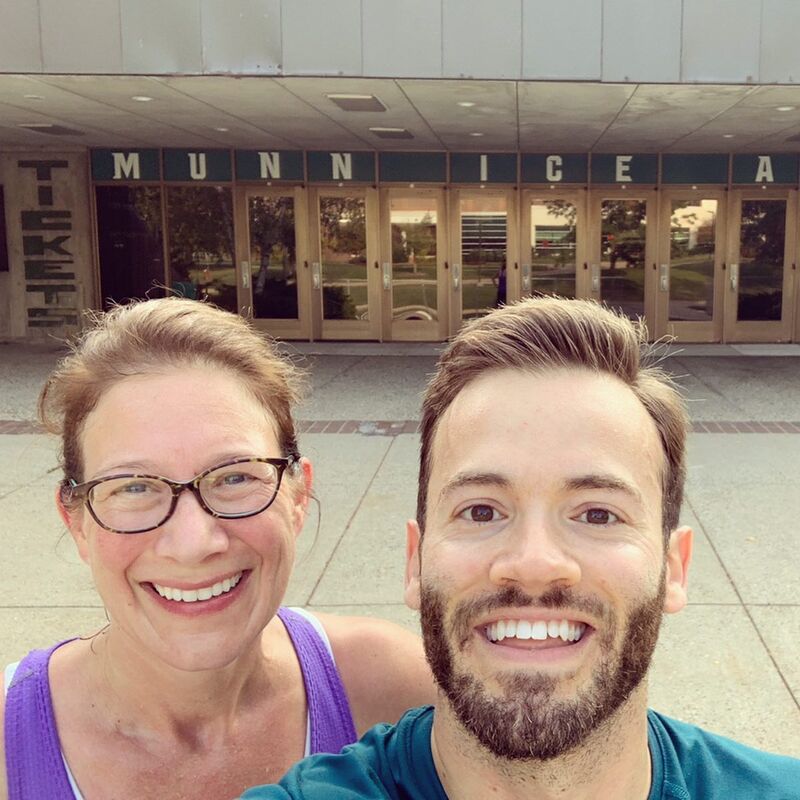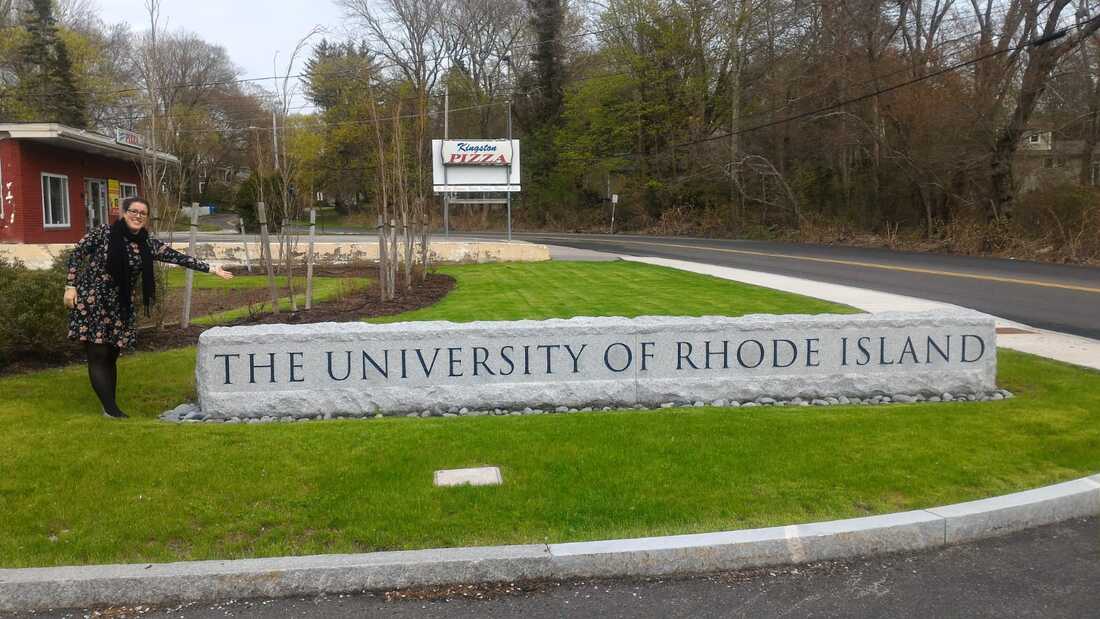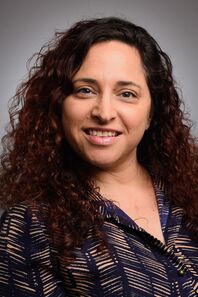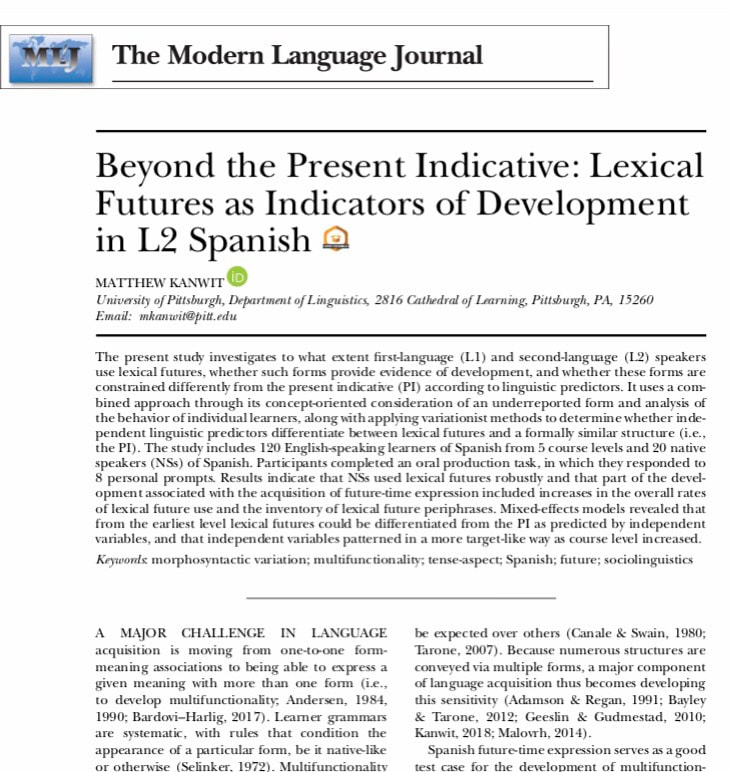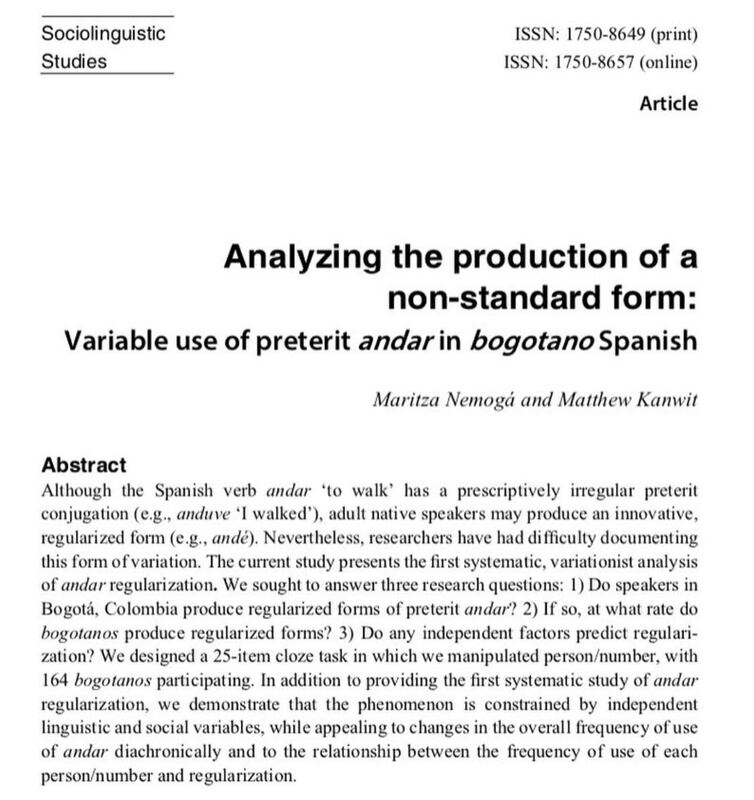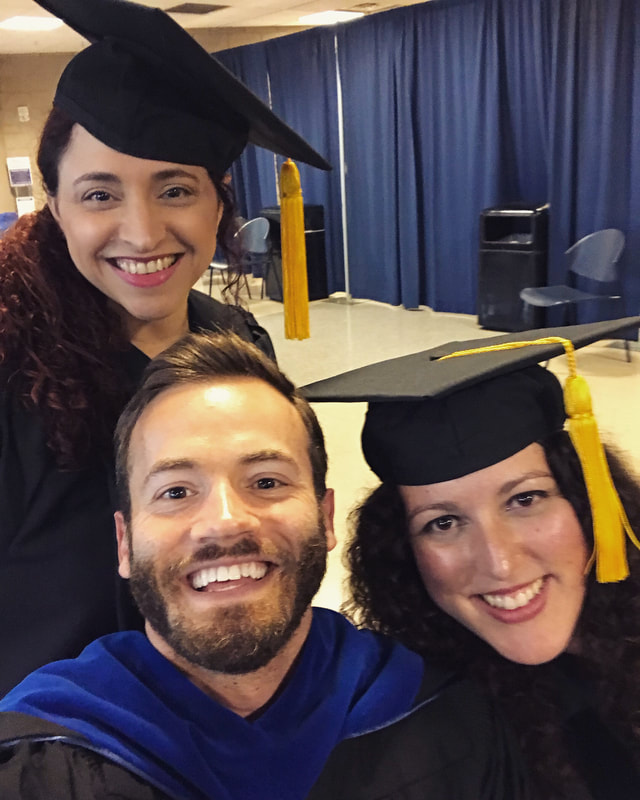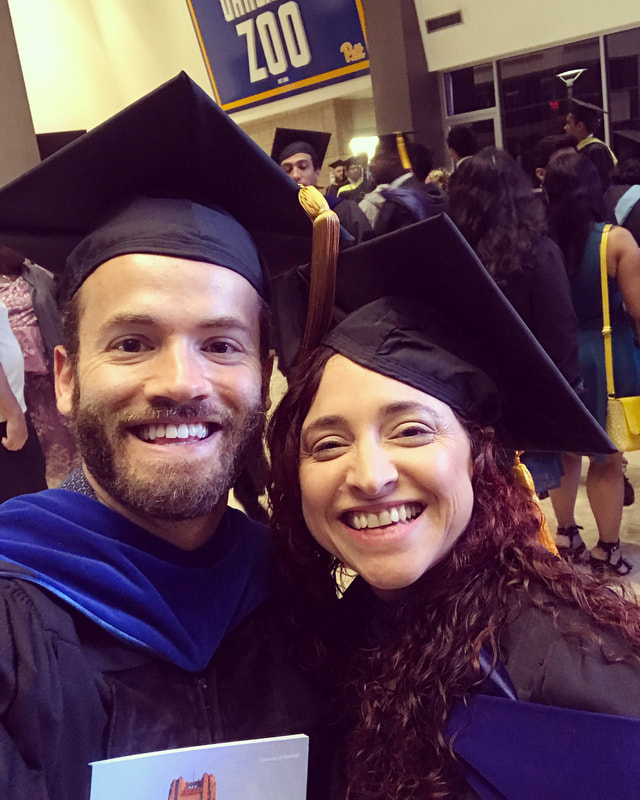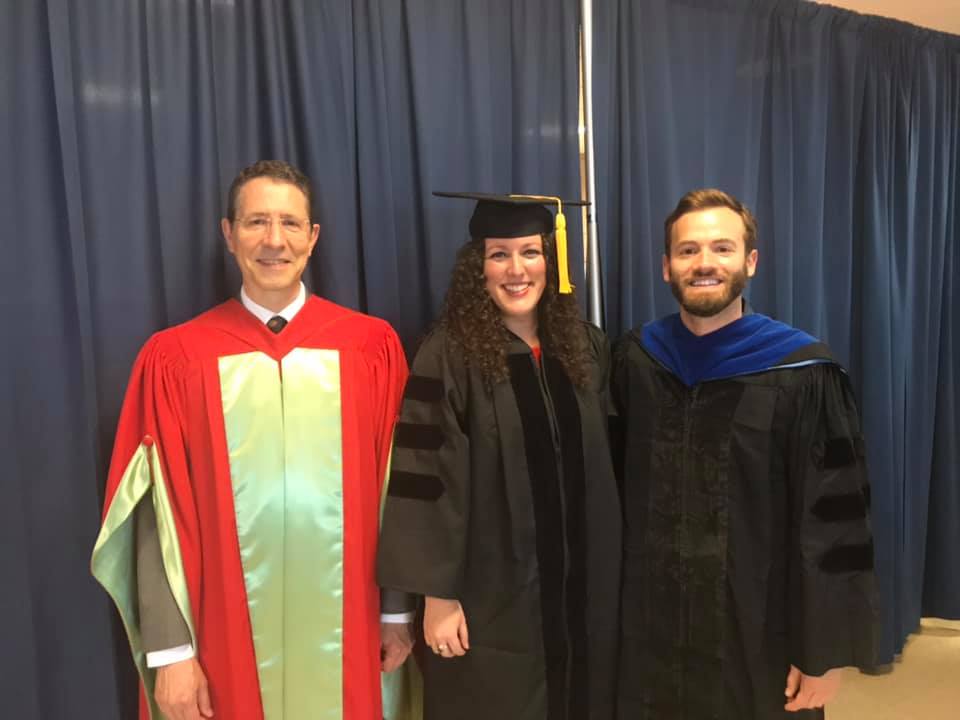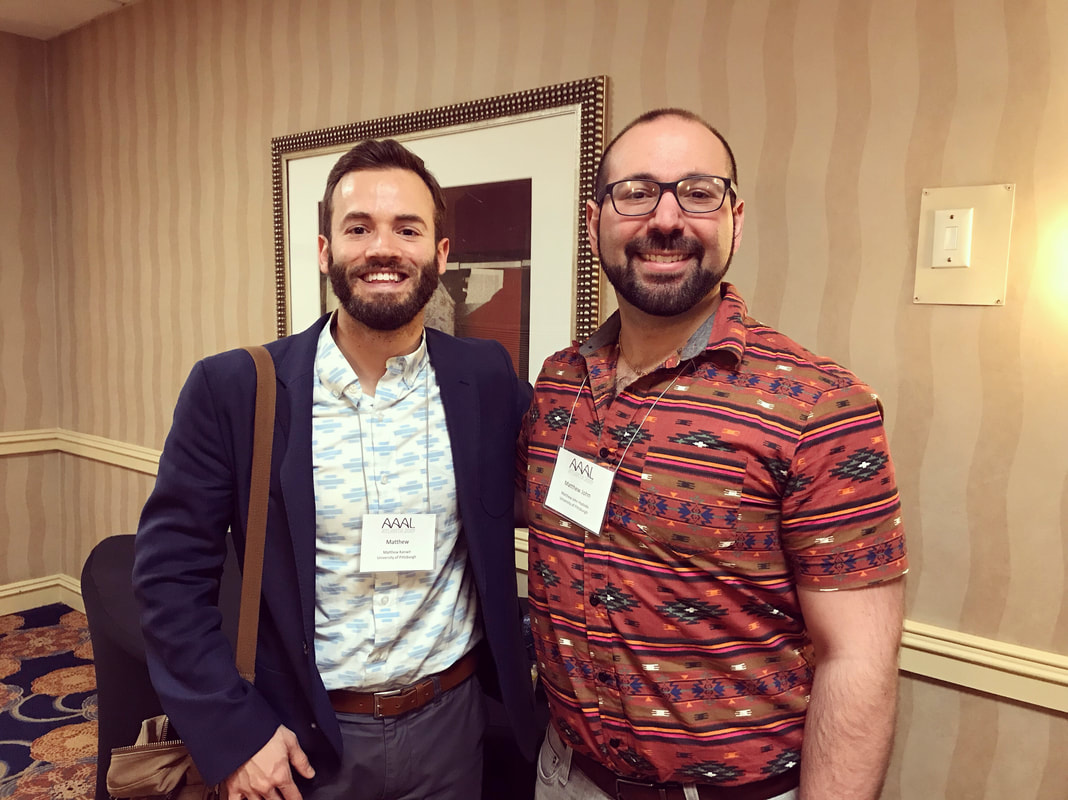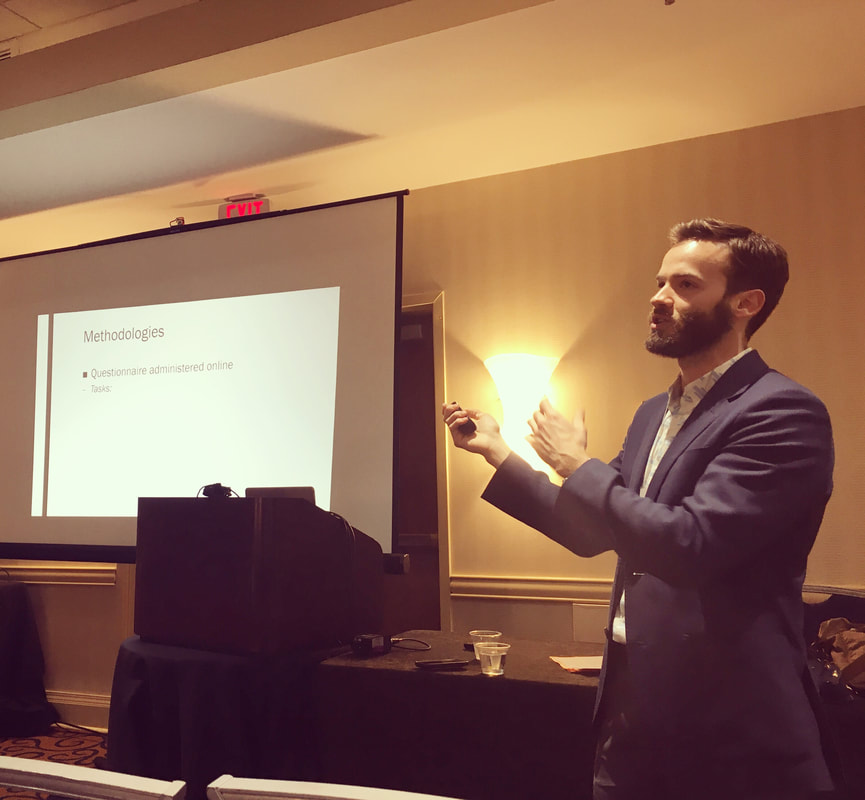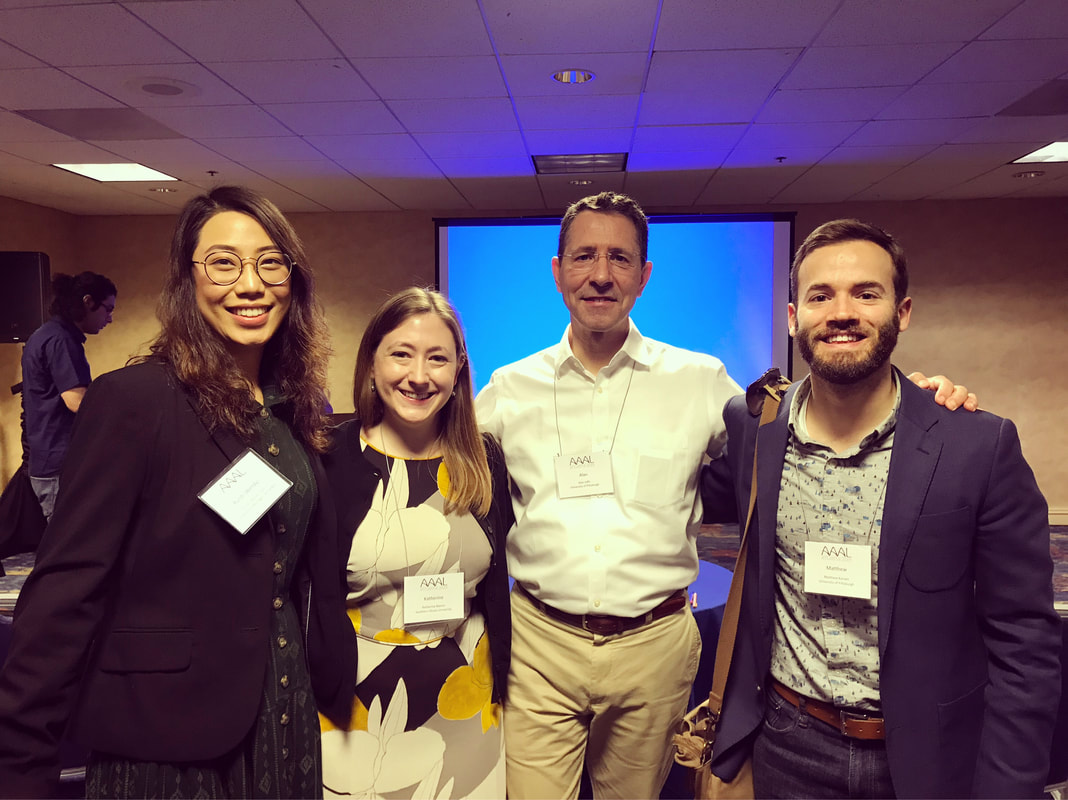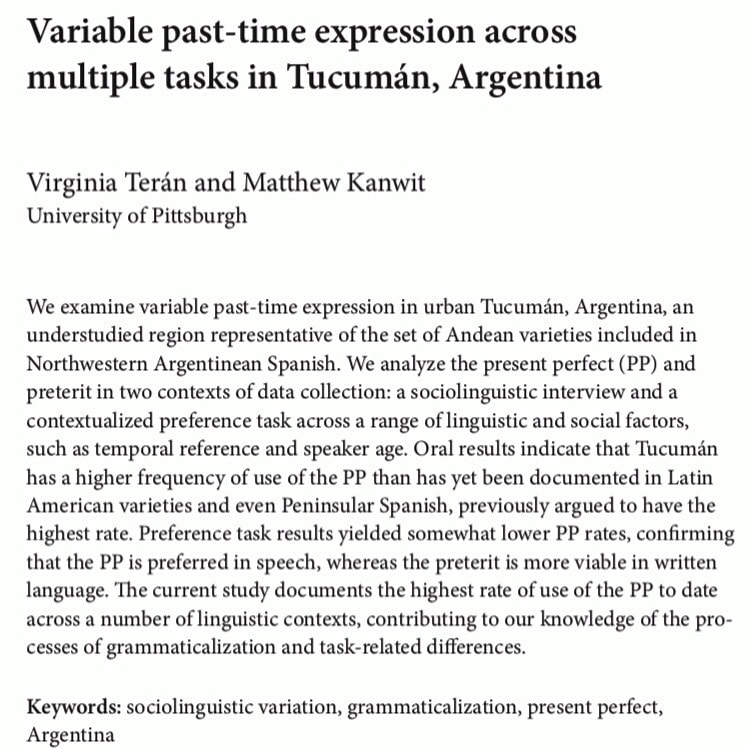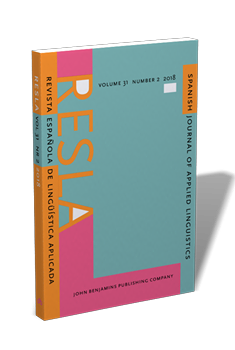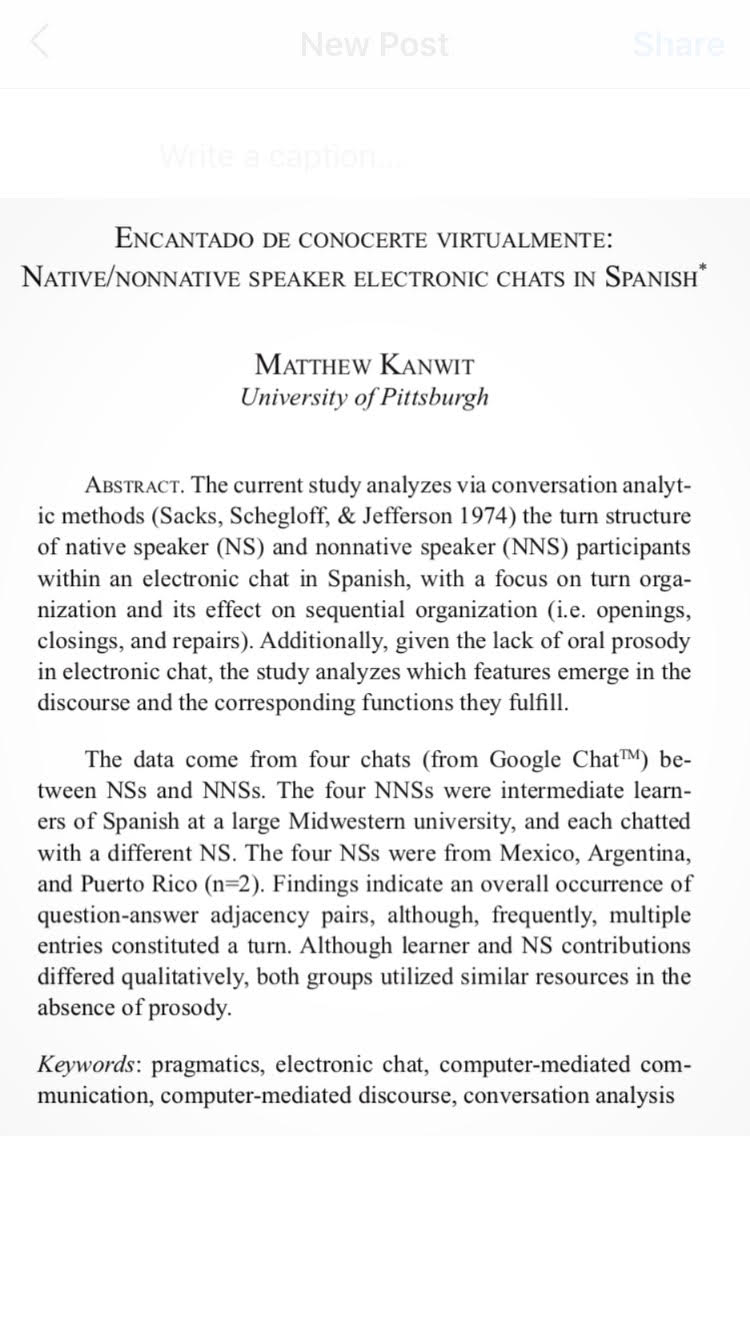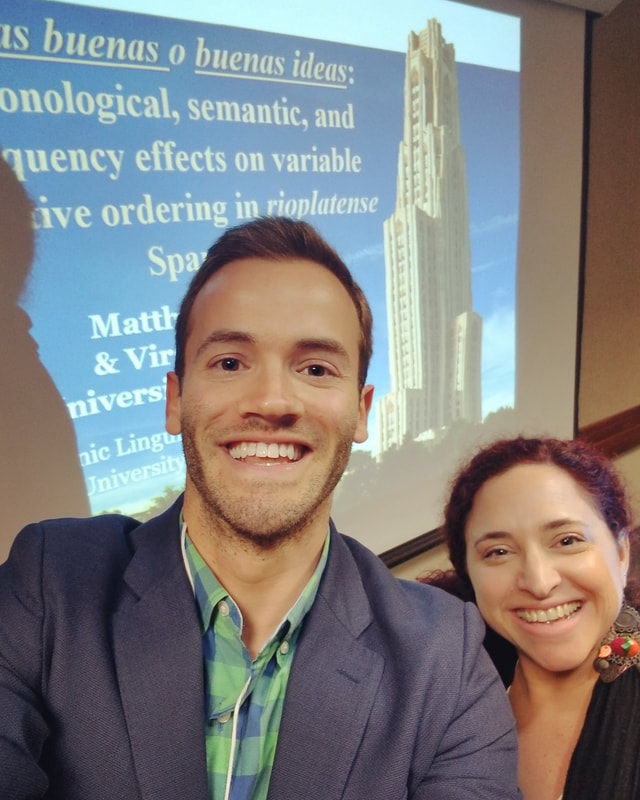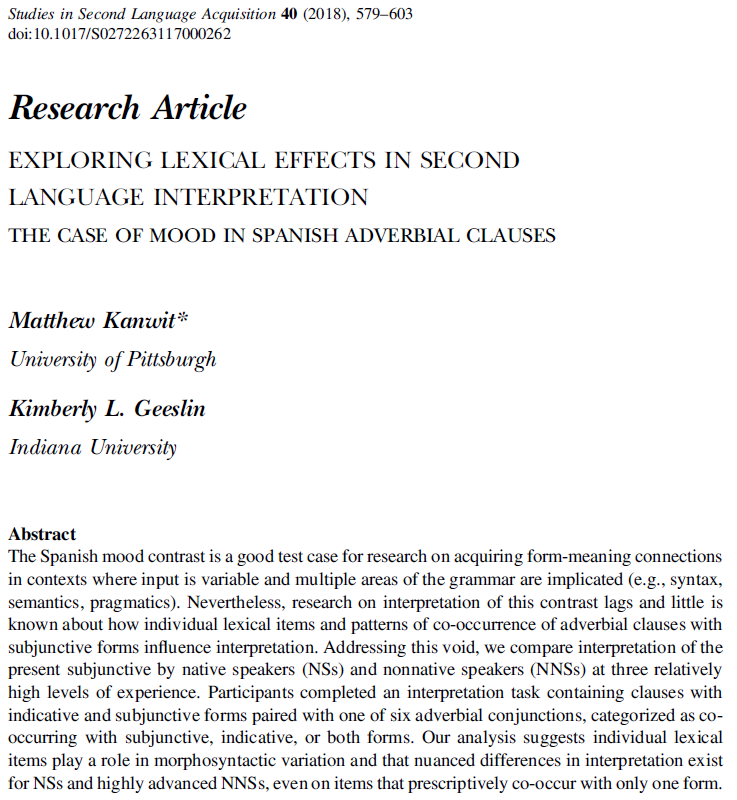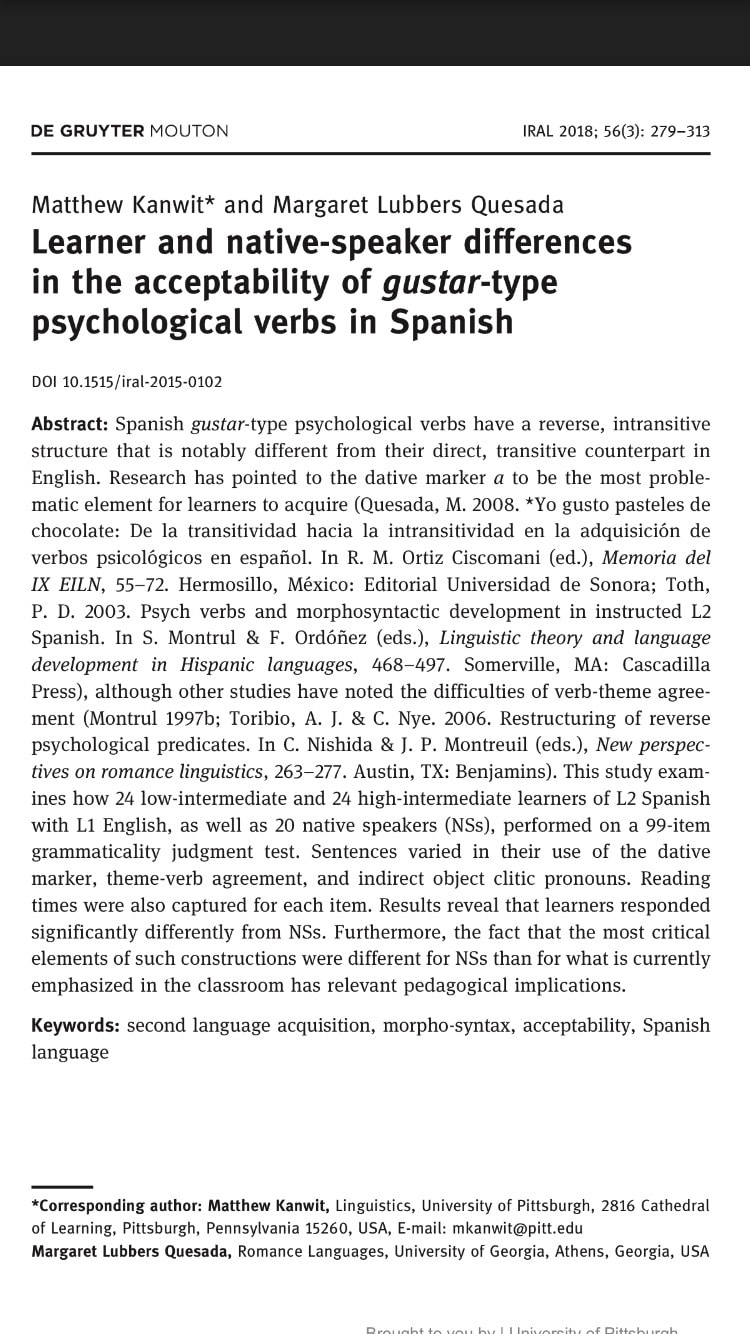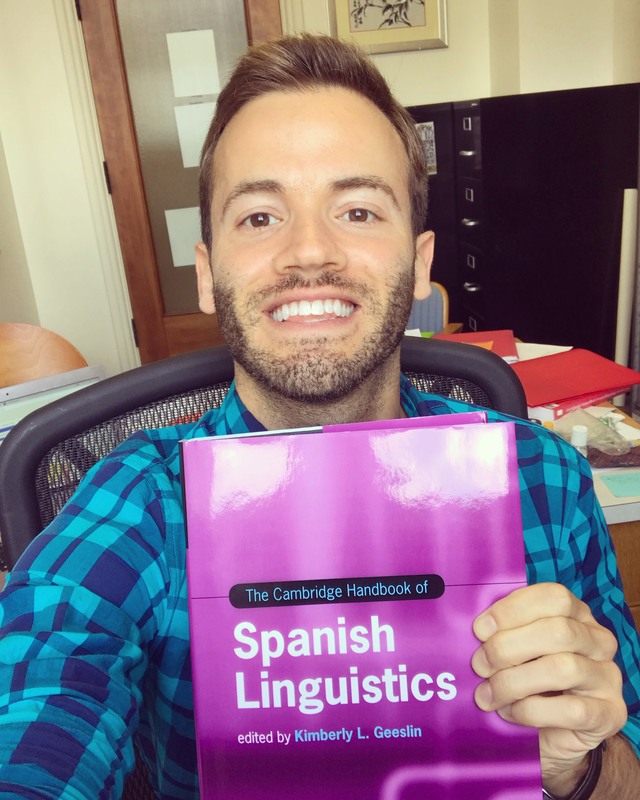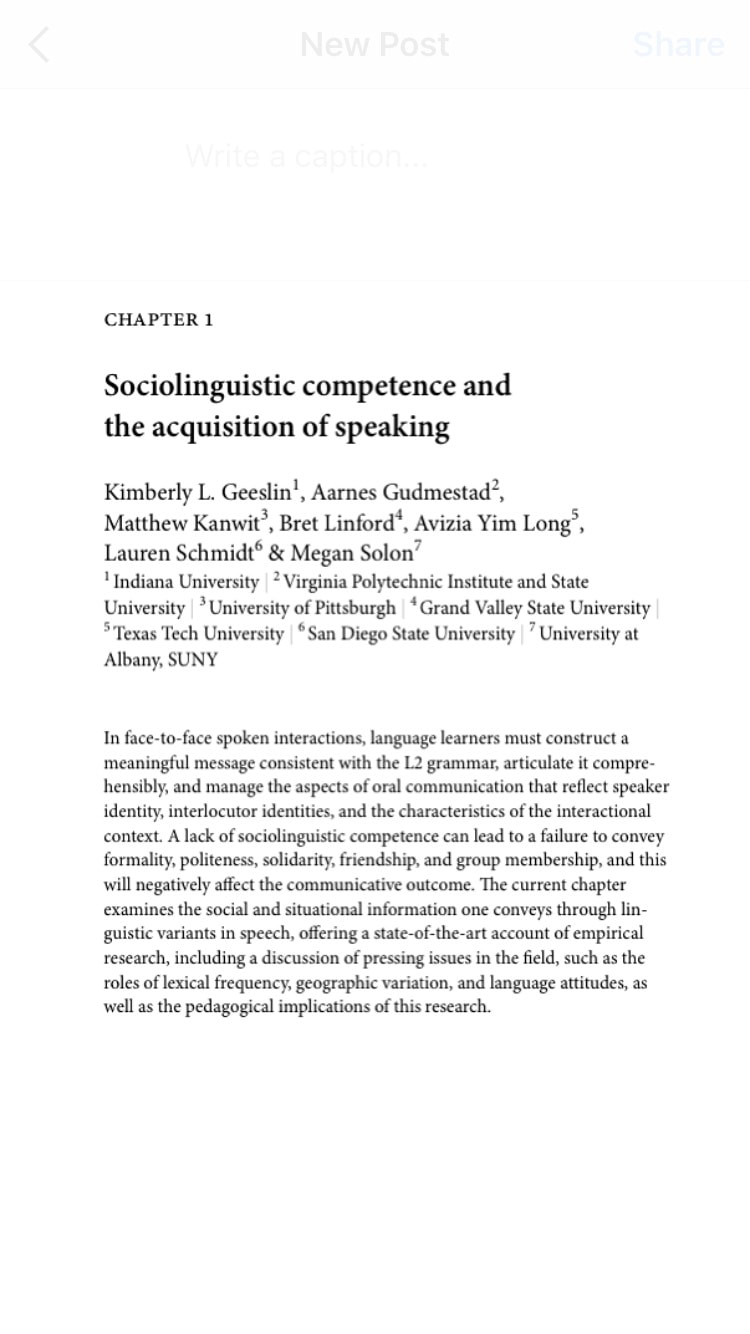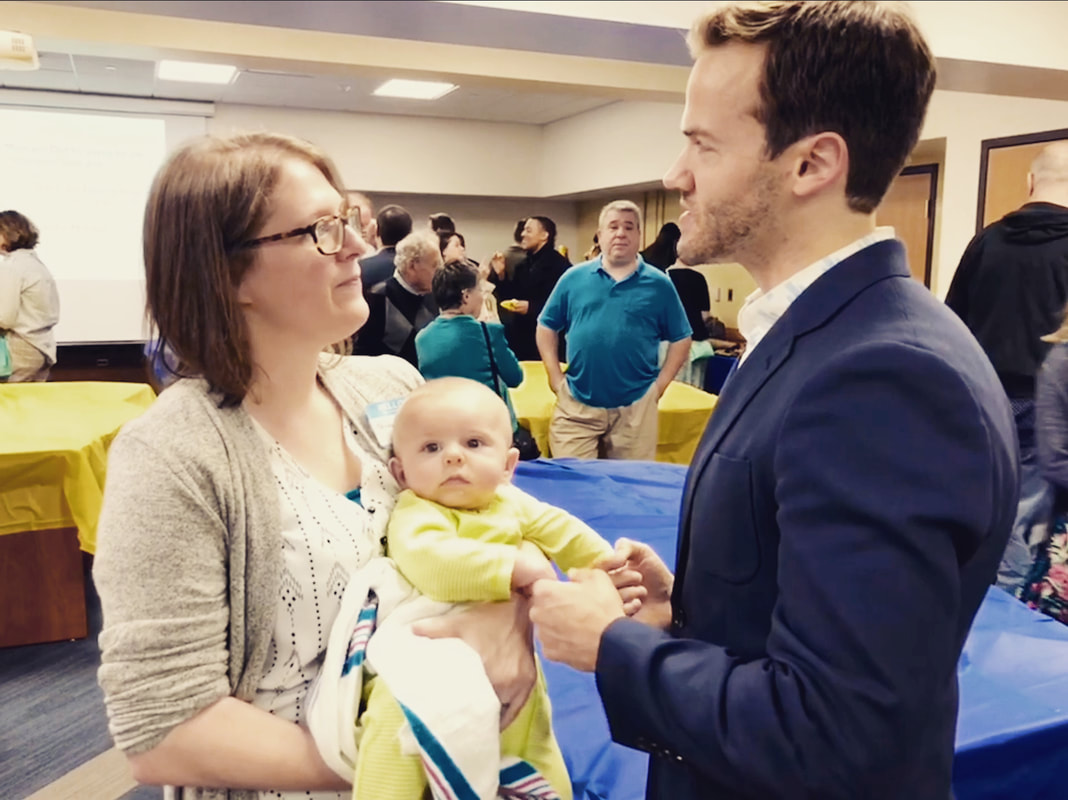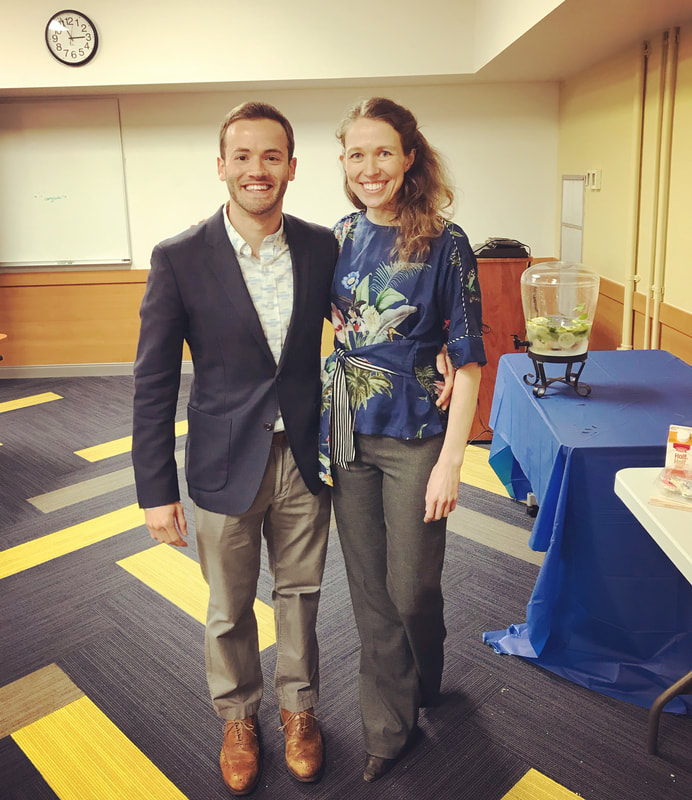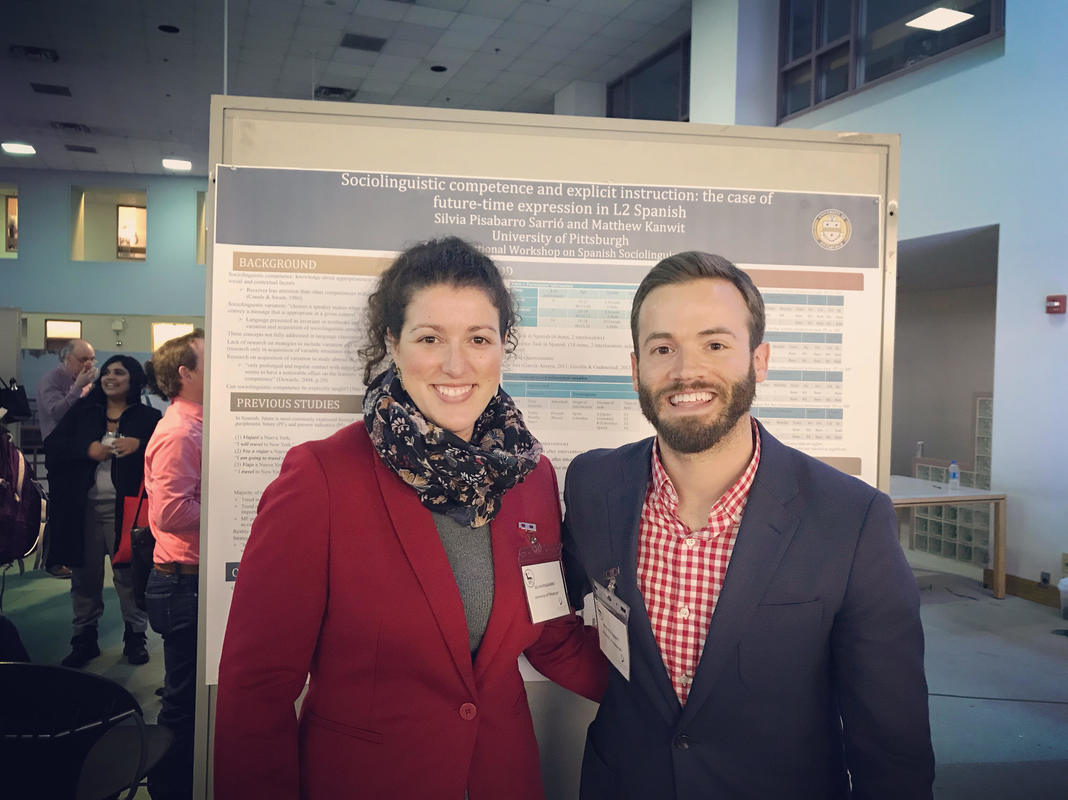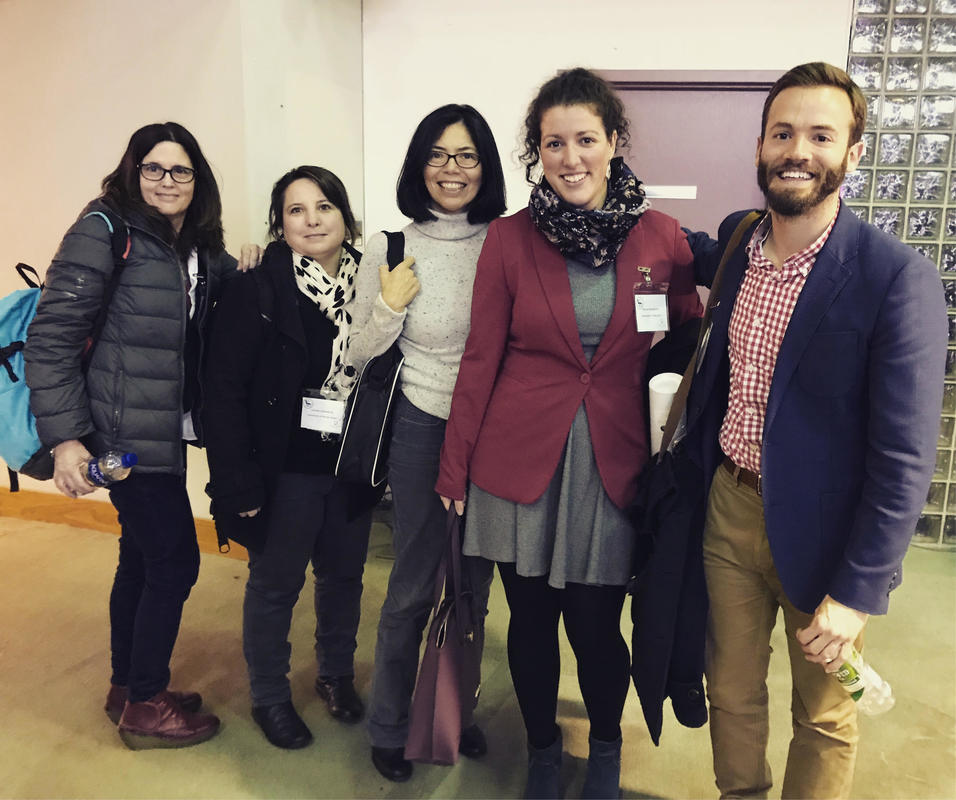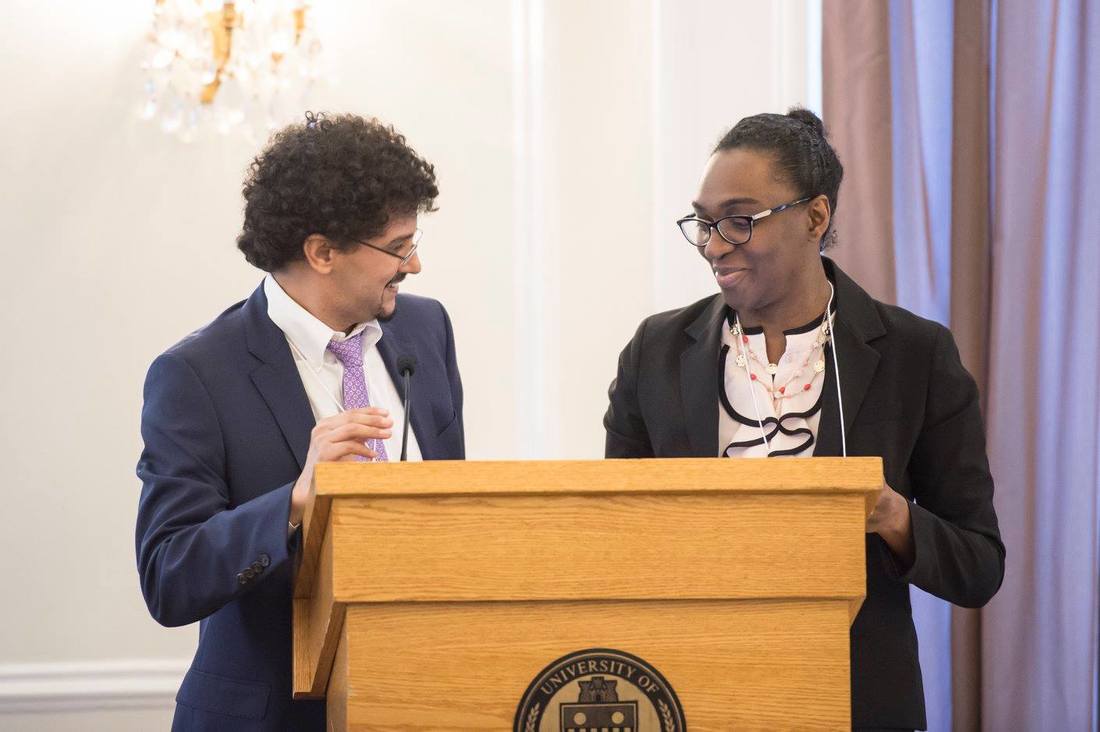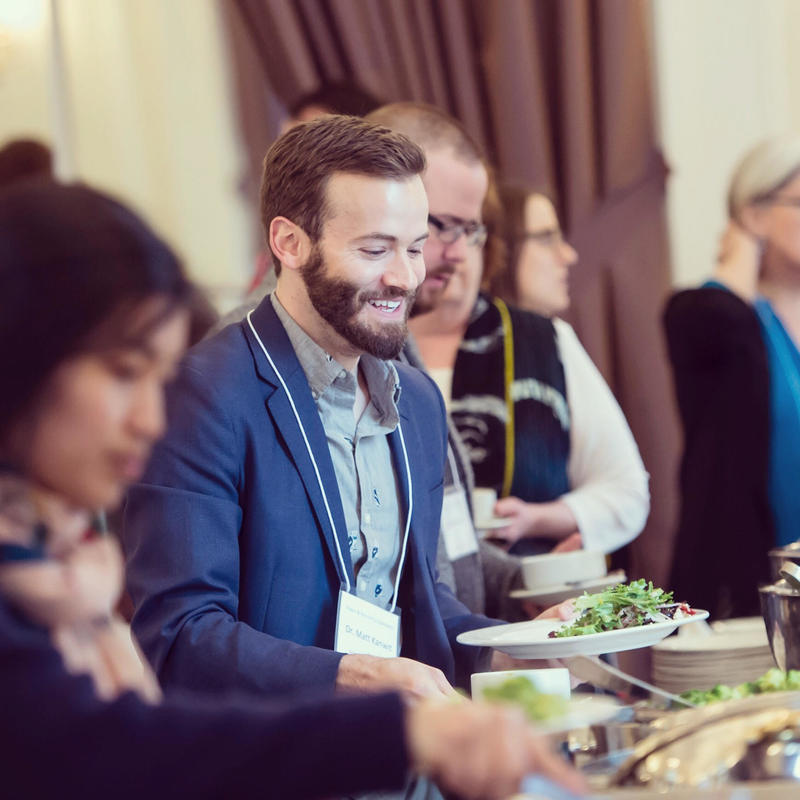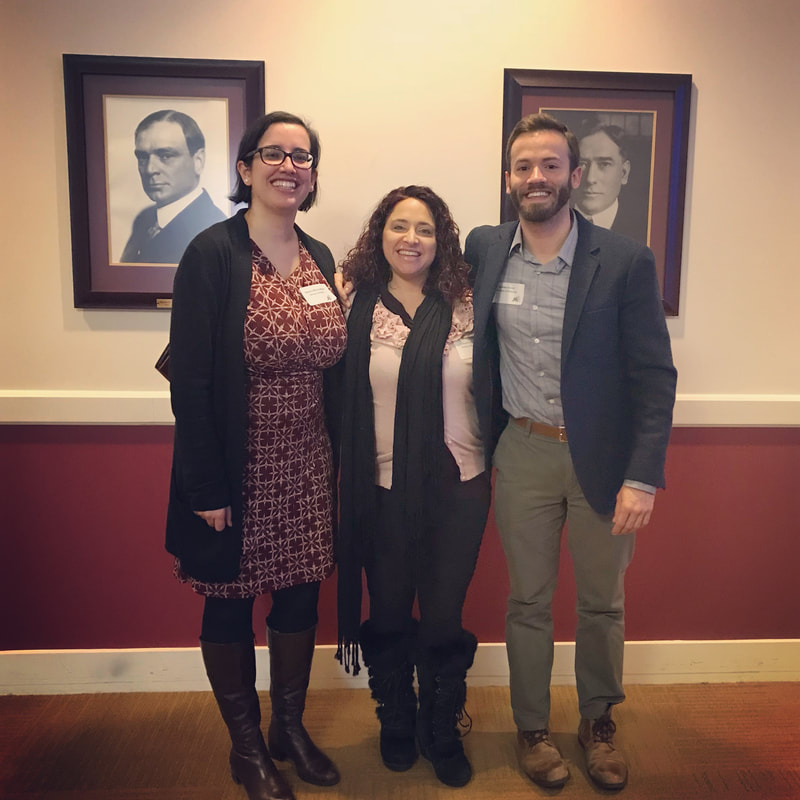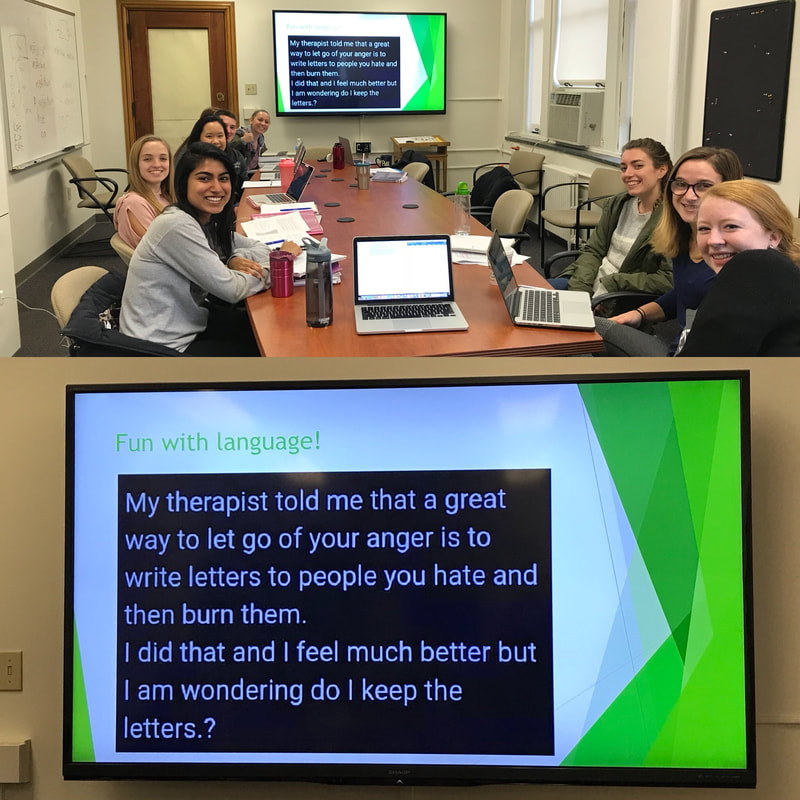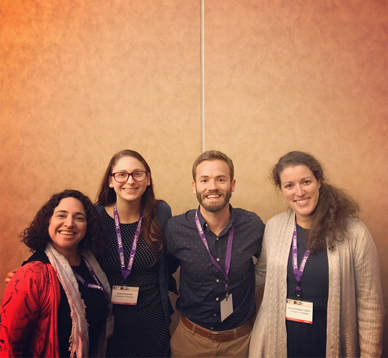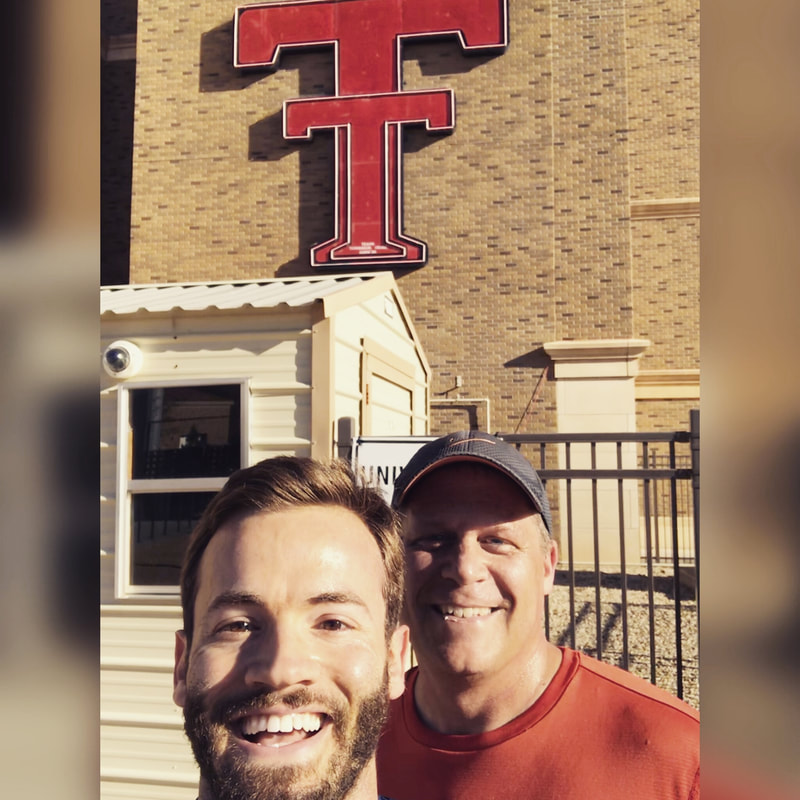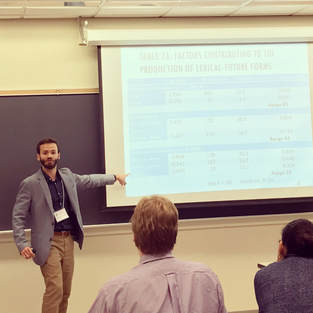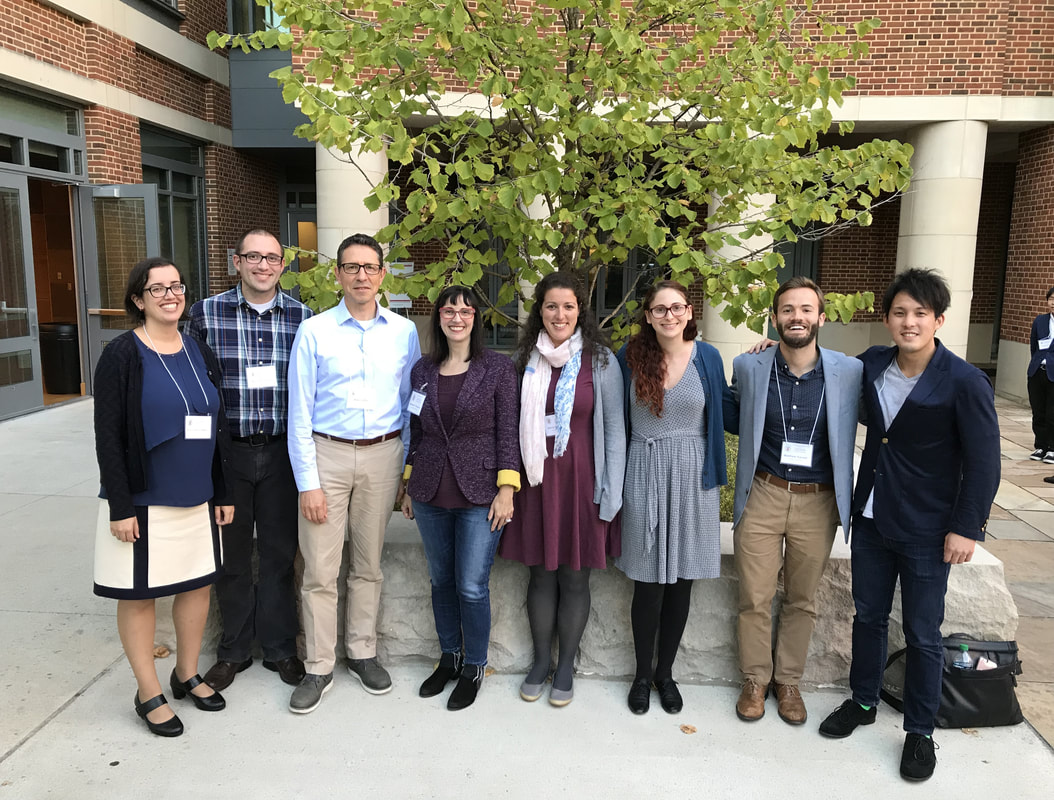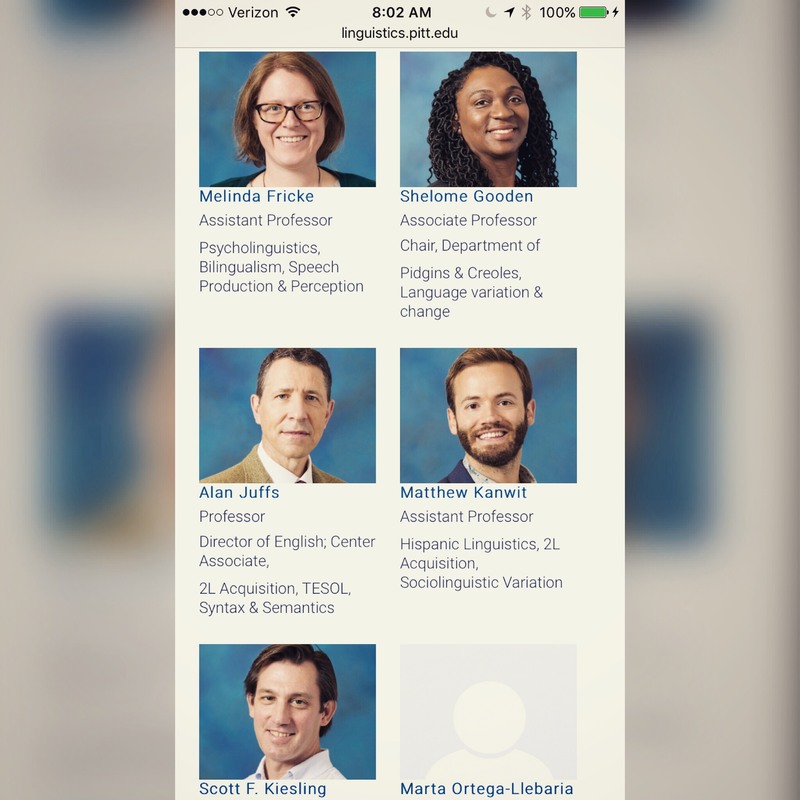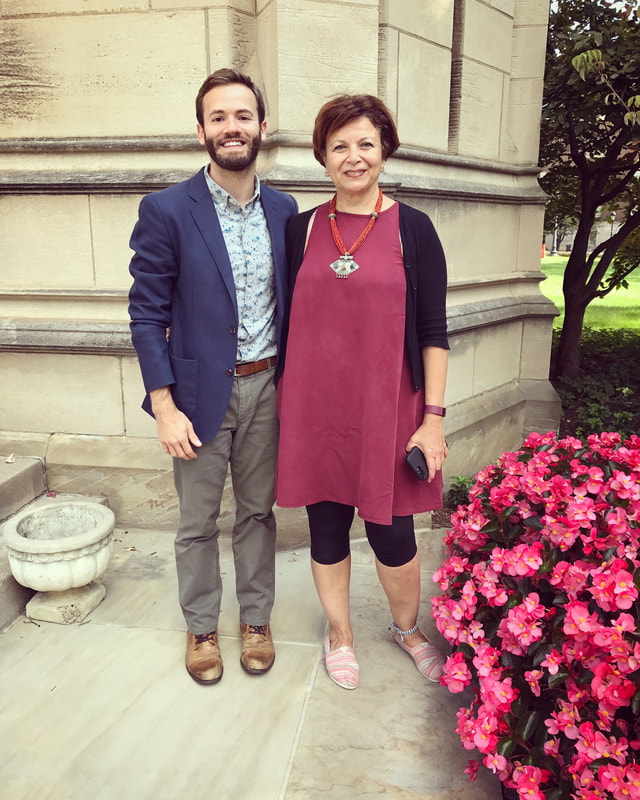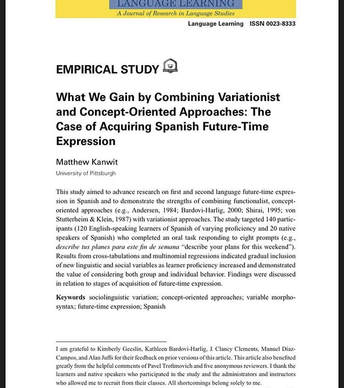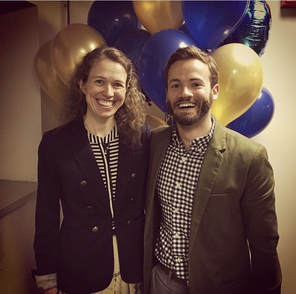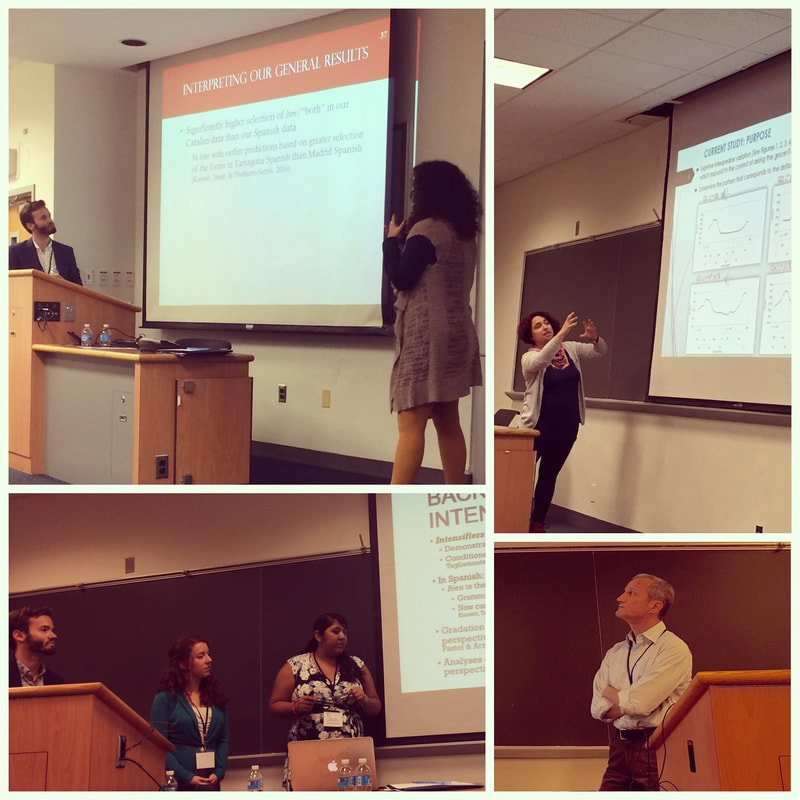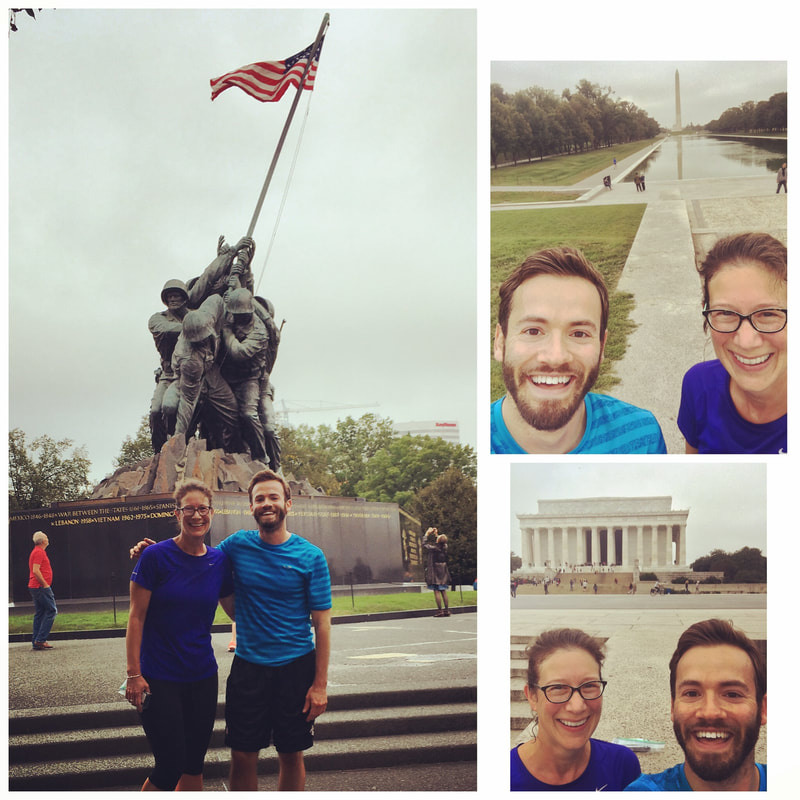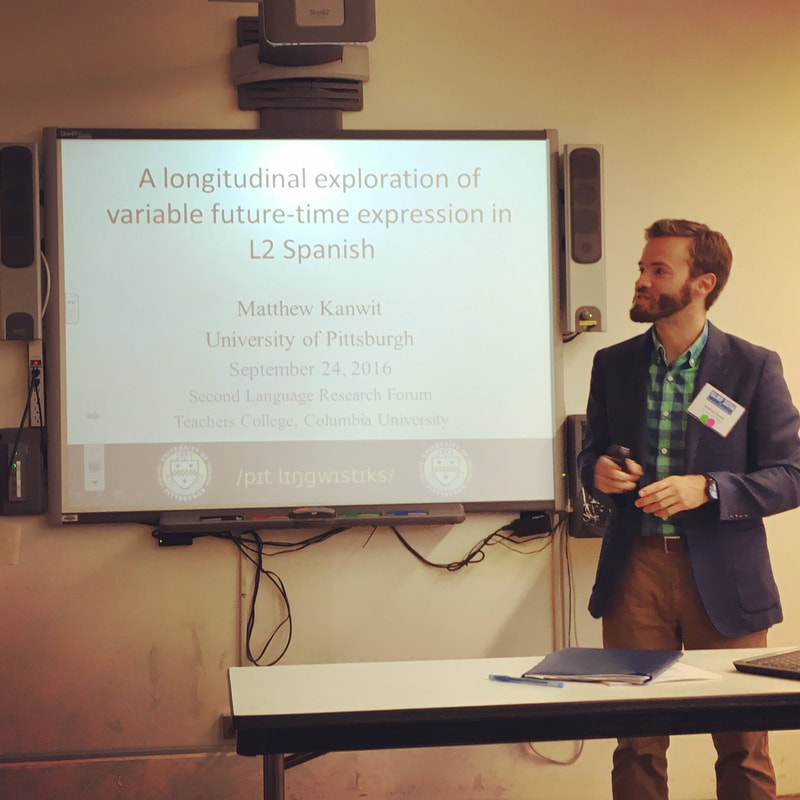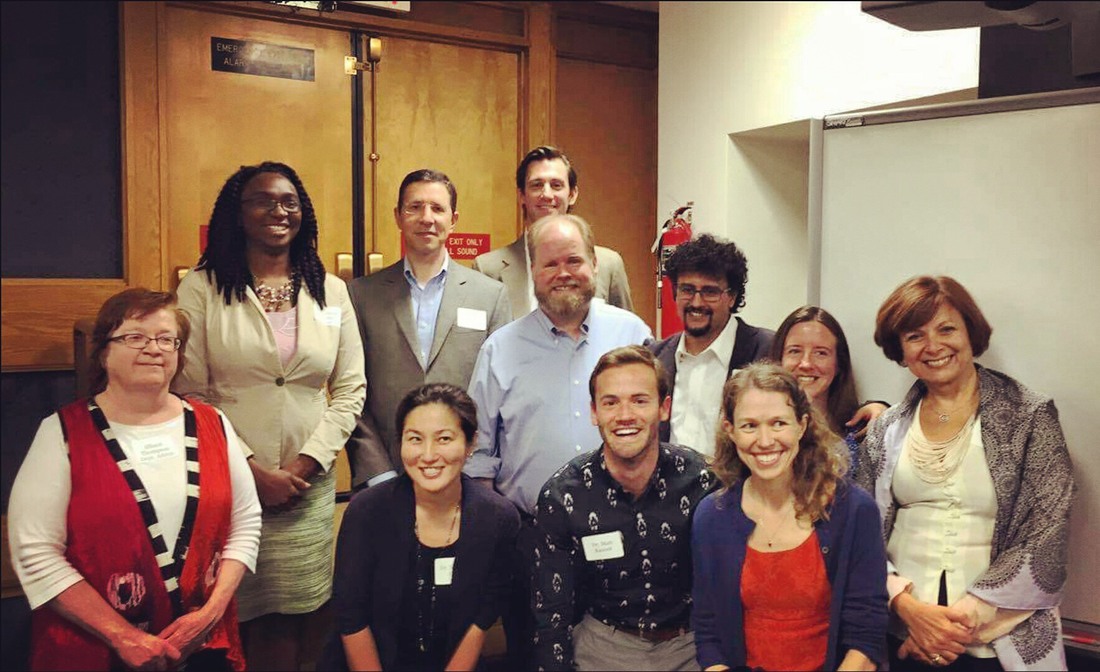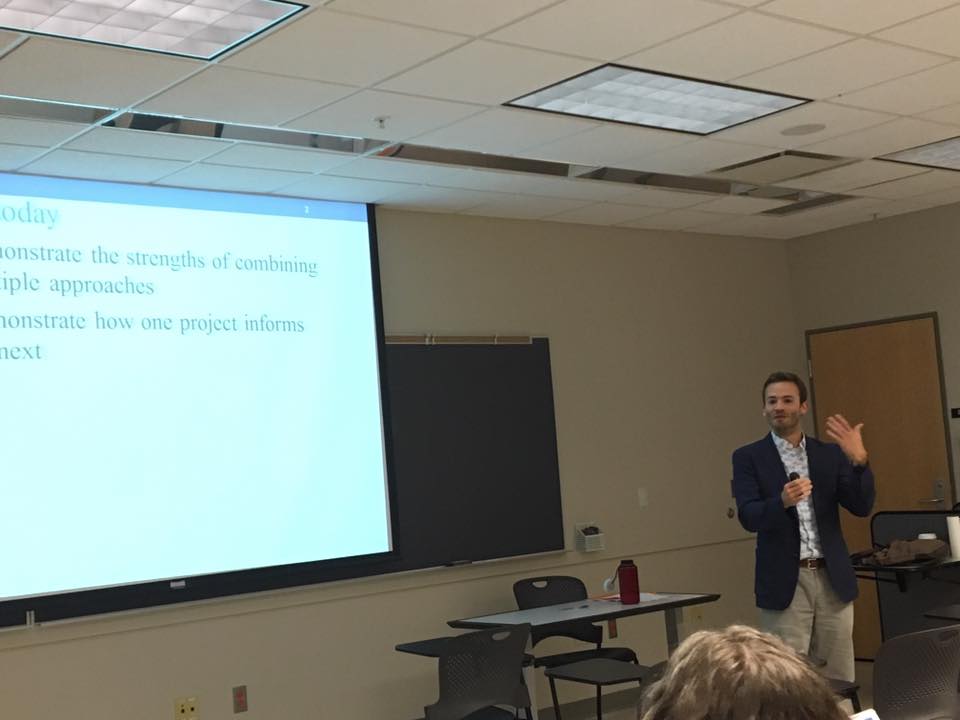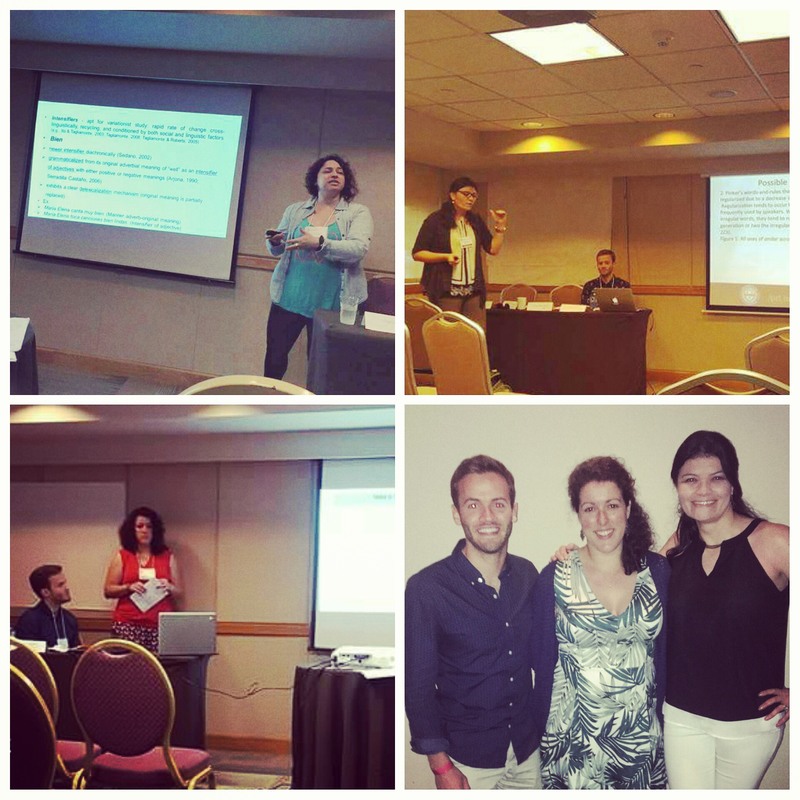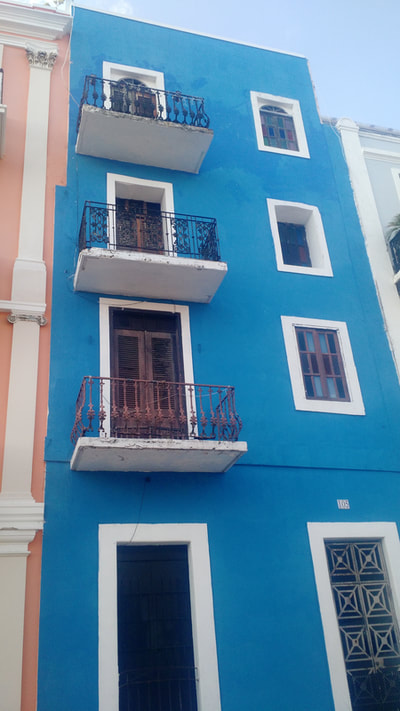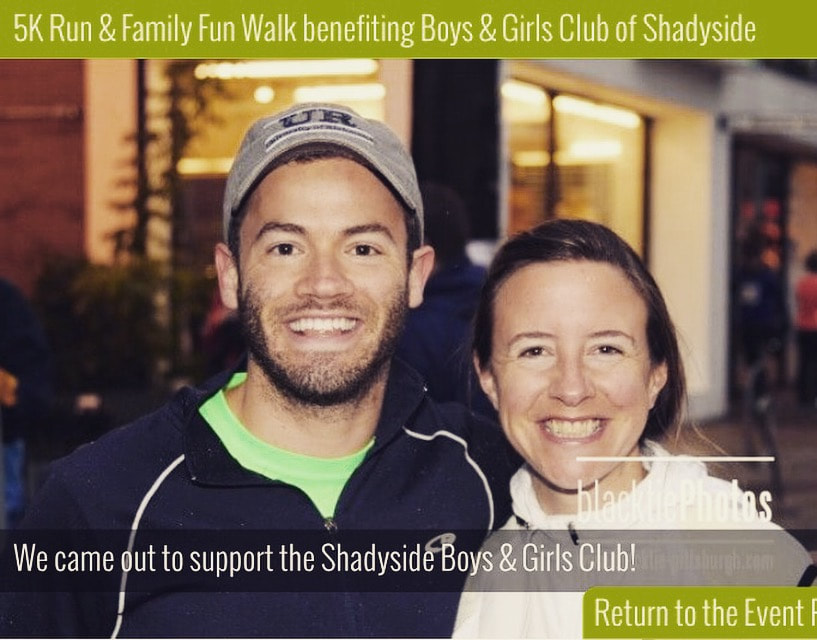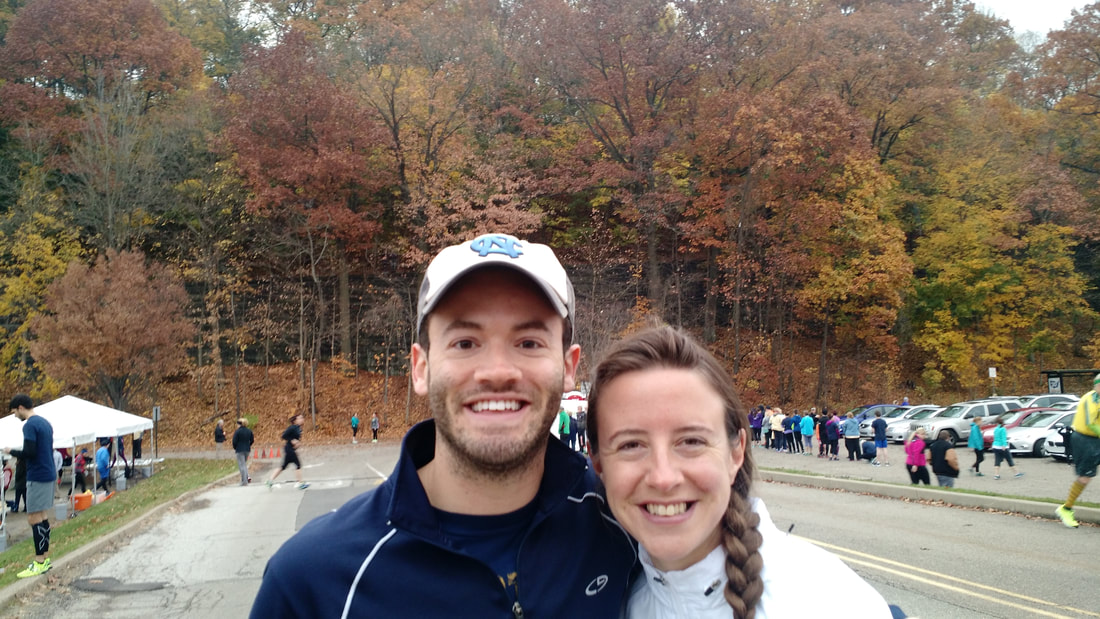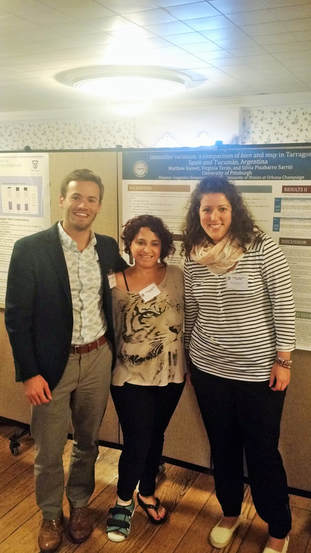Keynote at Georgetown
|
February 2024 - I was honored to give the keynote lecture at Georgetown's 16th Graduate Portuguese and Hispanic Symposium. The conference's theme was "Thresholds: Disciplinary Crossroads," and my talk centered on how the fields of sociolinguistics and second language acquisition (SLA) can mutually inform each other in beneficial ways, in addition to how two approaches within SLA (concept-oriented and variationist approaches) can contribute to a whole greater than the sum of its parts. The talk also provided an opportunity to share information about exciting projects with collaborators at Pitt and other institutions. I'm grateful to the organizers for all of their hard work in planning an excellent conference with such engaging events.
|
Guest presenters in Spanish Dialectology
|
December 2023 - This fall my Dialectology students were treated to monthly lectures and discussion with a range of talented linguists. Dr. Lamar Graham (University of North Carolina at Chapel Hill), Dr. Juan Berríos (California State University, Fresno), and Dr. Angela (Krak) Swain (Pennsylvania State University) chatted with us about their recent publications. Students greatly enjoyed getting to hear about projects from the researchers themselves, and we thank these scholars for generously giving of their time.
You can read more about the work they shared and other recent projects below: Graham, L. A. (2023). Derived verbs and future-conditional stem regularization in written Spanish in synchrony and diachrony. In S. Fernández Cuenca, T. Judy, & L. Miller (Eds.), Innovative approaches to research in Hispanic linguistics: Regional, diachronic, and learner profile variation (pp. 82-105). John Benjamins. Graham, L. A. (2021). Sociopragmatic variation in attention focus: Mira, fíjate, and oye in San Juan and Mexico City. Borealis: International Journal of Hispanic Linguistics, 10(1), 87-102. Swain, A. K., Berríos, J., & Kanwit, M. (2023). Exploring future-in-the-past variation in Seville and Caracas: ¿Cambiaría o iba a cambiar? In S. Fernández Cuenca, T. Judy, & L. Miller (Eds.), Innovative approaches to research in Hispanic linguistics: Regional, diachronic, and learner profile variation (pp. 58-80). John Benjamins. Berríos, J., Swain, A., & Fricke, M. (2023). Implementing the map task in applied linguistics research: What, how, and why. Research Methods in Applied Linguistics, 2(3), 1-13. Kanwit, M., & Berríos, J. (2021). No se sabía de que eso iba a pasar: Do lexical frequency and structural priming condition dequeísmo? In M. Díaz-Campos (Ed.), The Routledge Handbook of Variationist Approaches to Spanish (pp. 453-467). Routledge. |
Presentation at Hispanic Linguistics Symposium
|
October 2023 - This month PhD advisee Andrea Hernández Hurtado presented our project "Murcia, ¡qué bonica ereh, pijo! The influence of social networks on the use of nonstandard Spanish in the Region of Murcia" at the Hispanic Linguistics Symposium in Provo, UT.
Although I wasn't able to join her for this trip, we celebrated with a belated conference dinner back in Pittsburgh. Congrats to Andrea on her continued success with this project! |
Remembering Peter Kanwit
|
August 2023 - Peter Kanwit, my father, passed away unexpectedly this month. As he was a longtime proponent of the value of higher education, travel, language, mentoring, and residing in different regions, it feels appropriate to honor him here.
You can read more about the many ways he positively impacted others here. My eulogy for him can be found here. You can donate to a special fund in his honor at his tribute page of the Michael J. Fox Foundation for Parkinson's Research, if you're so inclined. We are grateful for the many ways you have supported our family over the past weeks and months. If you have additional memories of him to share, please do so at either of the above pages or by emailing me. |
New handbook chapter
|
August 2023 - Kudos to Manuel Díaz-Campos and Sonia Balasch for their substantial work putting together such a comprehensive volume for The Handbook of Usage-Based Linguistics. Check out my chapter with former advisee Juan Berríos: "Corpora, Cognition, and Usage-based Approaches". Congrats to the editors and to the other contributors! What an honor to keep such company!
|
Successful dissertation defense
|
June 2023 - Congratulations to advisee Juan Berríos on successfully defending his dissertation, "The L2 Acquisition of Progressive and Habitual Aspect Through the Lens of Analyticity". We’re excited for his journey ahead as (tenure-track) Assistant Professor at California State University, Fresno. Here are his other committee members from the defense (left to right): Melinda Fricke, Alan Juffs, and Rick Donato.
|
New articles in edited volumes
|
June 2023 - My work appeared in two new edited volumes this month. Megan Solon and I have published a new article in the volume Study Abroad and the Second Language Acquisition of Sociolinguistic Variation in Spanish. In the article we consider the relationship between pre-program proficiency and the development of regional patterns of future-time variation for learners studying in Spain and Mexico.
Kudos to Sara Zahler, Avizia Long, and Bret Linford on putting together an expansive volume. The other chapter is a pairing with two Pitt graduate students. It was a lot of fun to be a part of Angela Swain's first publication and to help Juan Berríos build his portfolio. Check out our new article on variation between the conditional and the periphrastic future in the imperfect to express the future from the point of view of the past in Seville and Caracas (e.g., me dijo que iba a salir / saldría 'he told me that he was going to leave / would leave’). Congrats to Sara Fernández Cuenca, Tiffany Judy, and Lauren Miller on their editorial achievement in Innovative Approaches to Research in Hispanic Linguistics and to the other authors! |
Congrats to grads and advisees
|
April and May 2023 - Congrats to our four PhD graduates this year: Sean Nonnenmacher, Juan Berríos, Shaohua Fang, and Angela (Krak) Swain (left to right in first picture).
Also, cheers to my advisees on their hard-earned accomplishments. Juan Berríos has accepted a tenure-track position as Assistant Professor in the Department of Modern and Classical Languages and Literatures at Fresno State University (i.e., California State University, Fresno). This reflects a great deal of diligent work and perseverance! Kudos to advisee Andrea Hernández Hurtado on earning an Andrew P. Mellon Predoctoral Fellowship for 2023-2024. Andrea successfully defended her two comprehensive papers this year, and the fellowship will help fund her dissertation research. Finally, congrats to Mason Wirtz on successfully defending his dissertation at the University of Salzburg. I enjoyed serving as Mason's external reviewer and congratulate him and his advising team of Andrea Ender, Irmtraud Kaiser, and Simone Pfenninger. |
Keynote at University of Richmond
Guest presenters in Language, Gender, and Sexuality class
|
April 2023 - This semester my Language, Gender, and Sexuality class was treated to monthly visits from a wonderful group of guests. The outstanding researchers joining us were Dr. Scott Kiesling (University of Pittsburgh), Dr. Sara Zahler (University at Albany, SUNY), Dr. Sean McKinnon (Arizona State University), and Dr. Matthew John Hadodo (University of Bern).
These visitors did an exemplary job of engaging with the students, who greatly enjoyed hearing from the researchers in their own words. We're grateful for their time and talent. For more on the journal articles they discussed, see the following: Kiesling, S. F. (2011). The interactional construction of desire as gender. Gender and Language, 5, 213-239. Kiesling, S. F. (2019). Interaction, identity, and performance. In S. F. Kiesling (Ed.), Language, gender, and sexuality: An introduction (pp. 84-130). Routledge. Zahler, S. L. (2021). Speech strategy sequencing in personal ads: social variation in personal ad structure in Mexico City and London. Gender and Language, 15, 503-524. McKinnon, S. (2017). “Building a thick skin for each other”: The use of ‘reading’ as an interactional practice of mock impoliteness in drag queen backstage talk. Journal of Language and Sexuality, 6, 90-127. Hadodo, M., & Kanwit, M. (2020). Menos masculino, demasiado infantil: How age and gender ideologies index sexuality in perception of diminutives in Madrid Spanish. Journal of Language and Sexuality, 9, 127-151. |
Pitt LING Well Represented at AAAL 2023
|
March 2023, Portland, OR - Pitt Linguistics was well represented at the American Association for Applied Linguistics (AAAL) 2023 conference in Portland, OR. Current faculty presenting research included Dr. Amanda Huensch, Dr. Alan Juffs, and me. Current PhD student Juan Berríos also presented his recent work.
Alums of the program presenting or attending included Dr. Paul Toth (Temple University, Pitt PhD), Dr. Silvia Pisabarro Sarrió (Lingrolearning, Pitt PhD), Dr. Ben Naismith (Duolingo, Pitt PhD), Dr. Nausica Marcos Miguel (Ghent University, Pitt PhD), Dr. Jenifer Larson-Hall (University of Kitakyushu, Pitt PhD), and Dylan Ashton (School District of Philadelphia, Pitt MA). |
New Book Released
|
March 2023 - I've published a new (2023) co-edited volume titled "Communicative Competence in a Second Language: Theory, Method, and Applications”. It appears through Routledge Press as part of the Second Language Acquisition Research Series (series editors Susan Gass & Alison Mackey).
The volume, co-edited with Megan Solon, includes 18 authors originating from or based in Australia, Germany, Japan, New Zealand, Singapore, Spain, the UK, the US, and Vietnam. In addition to overview and future directions chapters by Megan and me, it includes theoretical chapters from generative (Pitt's own Alan Juffs), sociolinguistic (Kimberly Geeslin & Stacey Hanson, Indiana University), and sociocultural (Matthew Poehner, Pennsylvania State University) perspectives; methodological chapters highlighting ethnographic (Rebecca Lurie Starr, National University of Singapore), psycholinguistic (Jill Jegerski, University of Illinois at Urbana-Champaign & Sara Fernández Cuenca, Wake Forest University), and computational/corpus methods (Stefan Gries, University of California at Santa Barbara and Justus-Liebig-Universität Giessen, Germany); and applications to pragmatics (Minh Thi Thuy Nguyen, University of Otago, New Zealand), L2 writing (Charlene Polio & Phil Montgomery, Michigan State University), computer-assisted language learning (Glenn Stockwell & Yurika Ito, Waseda University, Japan), and language assessment (Luke Harding, Lancaster University, UK; Susy Macqueen, Australian National University; & John Pill, Lancaster University, UK). Reference information for the volume is as follows: Kanwit, M., & Solon, M. (Eds.). (2023). Communicative competence in a second language: Theory, method, and applications. Routledge. https://doi.org/10.4324/9781003160779 Megan and I are grateful to Lourdes Ortega, Luke Plonsky, & Vera Regan for their kind endorsements and to the generous proposal and chapter reviewers for their helpful comments that greatly improved the volume. Faculty, students, and staff at Pitt, Indiana, and our previous home departments have also been enormously helpful in providing the professional structure to complete the project. And, of course, the volume would not be possible without Kim Geeslin's initial encouragement to submit the proposal, the chapter she contributed, and the training she provided Megan and me as her advisees. We continue to miss her every day. To donate to the fellowship fund in Kim's honor, click here. |
Remembering Kim Geeslin
|
February 2023 - Along with so many friends and colleagues in the linguistics community and beyond, I was devastated to learn of Kimberly Geeslin's unexpected passing. It was a total pleasure to know Kim for 14 years, beginning as her PhD advisee, which evolved into a series of collaborations and a close friendship for about the past 10 years. I truly can’t think of a single negative experience. Kim had an uncanny gift for making everyone feel so special and like we were her #1 priority, even though she somehow did this for so very many. She has provided the ultimate standard for how to be in life and work. While none of us can possibly approximate her, even aiming her direction makes us all better. She was truly a beacon of kindness, hard work, intelligence, and selflessness. This is an enormous loss for the world. I wish for peace for the very many who love Kim. Please keep her children in your thoughts.
For more about Kim's remarkable life, see here. If you knew Kim or her work and would like to leave a remembrance, which is being compiled into a book for her family, see here. If you were unable to catch Kim's services, they can be viewed in full online, including her eulogy at minutes 45-57 or written here. To donate to the fellowship fund in Kim's honor, click here. |
Presentation at HLS
|
November 2022 - Pitt PhD student Irene Soto Lucena and I presented research on the roles of frequency, regularity, and form avoidance in the expression of the future in L2 Spanish at the Hispanic Linguistics Symposium (HLS), hosted virtually by Arizona State University. We found that frequent, regular verbs were those most likely to be expressed in the morphological future (e.g., hablaré 'I will speak') and that learners reported avoiding expressing certain verbs in the morphological future if they were uncertain about inflecting a particular verb in that form (e.g., for less frequent or irregular verbs). Learners' ability to use other forms in those cases (e.g., periphrastic future voy a examinar 'I am going to examine' or present indicative examino luego 'I examine later') revealed aspects of their strategic competence to keep communication successfully proceeding, informing the learners' communicative competence more generally.
Since we couldn't have the typical conference banquet in Arizona due to the virtual format, we held a conference dinner of our own in Pittsburgh. |
New article in Applied Linguistics
|
September 2022 - I've published a new collaborative article with Megan Solon in the journal Applied Linguistics, currently rated #1 of 193 linguistics journals, with an impact factor of 5.741. Our article assesses communicative competence through a new task targeting Spanish intervocalic /d/ deletion. Results revealed that second-language learners’ preference for a deleted variant tended to increase as proficiency level increased, as did sensitivity to variables previously shown to constrain first-language Spanish patterns of variation, including speaker gender, surrounding phonetic context, and the grammatical category of the lexical item containing /d/.
The article is now available in the latest print issue and online. |
New handbook chapter
|
April 2022, Cathedral of Learning - I have a new chapter in The Routledge Handbook of Second Language Acquisition and Sociolinguistics (ed. Kimberly Geeslin). My chapter (3), in the "Theoretical and Conceptual Foundations in the Study of Second Language Acquisition and Sociolinguistics" section, addresses the construct of sociolinguistic competence.
Congratulations to Kim on another major editorial achievement and to the other chapter authors. |
Invited presenters in SLA course
|
April 2022 - This semester my Second Language Acquisition course generously received monthly guest lectures and discussions from a diverse range of scholars of SLA theory. Dr. Tiffany Judy (Wake Forest University) discussed generative research, Dr. Khaled Al Masaeed (Carnegie Mellon University) shared two sociocultural studies, Dr. Aarnes Gudmestad (Virginia Tech) presented her variationist research, and Dr. Noriyasu Li (Zoom, formerly of Amazon) shared concept-oriented approaches and an industry discussion. We remain grateful for the presenters' time and abundant talent.
For more information about the articles these scholars discussed, see their professional websites and the following article links: Judy, T. (2021). Effects of adjective type on position and interpretation in L1 Polish classroom learners of Spanish. Languages, 6(3), 153. Al Masaeed, K. (2016). Judicious use of L1 in L2 Arabic speaking practice sessions. Foreign Language Annals, 49(4), 716-728. Al Masaeed, K. (2022). Bidialectal practices and L2 Arabic pragmatic development in short-term study abroad. Applied Linguistics, 43, 88-114. Li, N., & Shirai, Y. (2015). The L2 acquisition of the present in the Japanese tense-aspect system: Evidence for a tripartite system? In D. Ayoun (Ed.), The acquisition of the present (pp. 215-252). John Benjamins. Gudmestad, A., & Edmonds, A. (2021). Exploring crosslinguistic influence in gender marking in Spanish. Studies in Second Language Acquisition, FirstView, 1-22. |
New article in SSLA
|
March 2022 - Whitney Chappell and I have published a new article now available in the latest issue of Studies in Second Language Acquisition. We use a matched-guise task to determine whether second-language learners of Spanish associate aspiration (i.e., production of /s/ as [h]) with regional or social characteristics. The study contributes to what we know about the development of communicative competence in its consideration of learners' ability to perceive linguistic and social meaning conveyed through sociophonetic variation. The full article is available for free via Open Access and contains Open Data.
|
Pitt presentations at AAAL
|
March 2022, Pittsburgh - Pitt Linguistics was strongly represented with numerous presenters and attendees at the American Association for Applied Linguistics (AAAL) conference. Faculty presenters included Dr. Amanda Huensch, Dr. Myriam Abdel-Malek, and me. Student presenters included Juan Berríos, Ben Naismith, and Irene Soto Lucena. Alumni returning to present included Dr. Katherine Martin (Associate Professor, Southern Illinois University), Dr. Jenifer Larson-Hall (Associate Professor, Kitakyushu University), Dr. Paul Toth (Associate Professor, Temple University), Dr. Patti Spinner (Associate Professor, Michigan State University), Dr. Nausica Marcos Miguel (Assistant Professor, Denison University).
Pictured: Above and center - Pitt faculty, graduate students, and alums in the lobby at the Omni William Penn; Below - presenting with Dr. Megan Solon on communicative competence in L2 Spanish as demonstrated across production and preference tasks. |
Contribution in new handbook
|
January 2022 - My advisee Juan Berríos and I have published a new chapter in The Routledge Handbook of Variationist Approaches to Spanish (ed. Manuel Díaz-Campos). Our study, informed by usage-based approaches to language variation and change, is the first to apply two variables known to affect other structures (i.e., lexical frequency and structural priming) to the study of dequeísmo (the innovative use of postverbal de prior to a clausal complement, as in Creo de que 'I think that...'). In addition to coding a range of linguistic and social variables, we also consider two random effects that had been absent from prior research on this topic (i.e., the verb lexeme and the individual speaker).
Congrats to Juan on the publication and to Manuel for his editorial achievement, which features authors from across the globe. |
Journal article in special usage-based issue
|
December 2021 - It's a joy to be part of Languages’ special journal issue “Revisiting Language Variation and Change: Looking at Metalinguistic Categories Through a Usage-Based Lens.” It features linguists I’ve long admired like Joan Bybee, Sandra Thompson, Rena Torres Cacoullos, Catherine Travis, Ana Maria Carvalho, Rafael Orozco, and Earl Brown. I'm also thrilled to be joined by contemporaries like Pablo Requena, Adriana Picoral, and Helen Zhao. Congratulations to Esther Brown and Javier Rivas for their editorial accomplishment and wonderful support.
My article with former advisee Virginia Terán focuses on the roles of phonology, semantics, and lexical frequency on Spanish variable noun-adjective ordering in corpus and elicitation data. All articles are available in full via Open Access. |
Guest presenters/discussants in Acquisition of Variation
|
November 2021 - This semester my Acquisition of Variation seminar was treated to a range of monthly lectures with discussion sessions. The outstanding researchers who joined us this term were Dr. Sara Zahler (University at Albany, SUNY), Dr. Pablo Requena (University of Texas at San Antonio), Dr. Avizia Long (San José State University), and Dr. Lauren Schmidt (San Diego State University).
It's invigorating to watch students interact with the authors they read, and we're very grateful to these scholars for their time, effort, and enthusiasm. For more on the journal articles they discussed with us this term, see the following: Linford, B., Zahler, S., & Whatley, M. (2018). Acquisition, study abroad and individual differences: The case of subject pronoun variation in L2 Spanish. Study Abroad Research in Second Language Acquisition and International Education, 3(2), 243-274. Requena, P.E., & Tissera, M.V. (2018). Variation in second language Spanish textbooks: A study of variable clitic placement. Hispania, 101, 55-68. Long, A.Y. (2021). Classroom learners’ acquisition of the Spanish copula with adjectives: The case of Korean learners. Studies in Second Language Acquisition, First View, 1-27. Schmidt, L.B. (2018). L2 development of perceptual categorization of dialectal sounds: A study in Spanish. Studies in Second Language Acquisition, 40, 857-882. |
Pitt presenters at Hispanic Linguistics Symposium
|
October 2021 - Pitt Linguistics was represented by four members of the department who presented at the Hispanic Linguistics Symposium, hosted virtually by Wake Forest University. PhD students Angela Krak and Juan Berríos presented research with me on future-in-the-past variation between conditional and periphrastic forms (e.g., Dijo que saldría 'She said that she would leave' versus Dijo que iba a salir 'She said that she was going to leave.') in Caracas and Sevilla. PhD student Andrea Hernández Hurtado presented her study on regularization of preterit andar (e.g., variation between regularized andé and prescriptive anduve 'I walked / went around') in Spain. I also presented a study implementing a new preference task with an aural component with Dr. Megan Solon of Indiana University.
Congrats to Angela, Juan, and Andrea on their hard work and earning coveted presentation slots in a very competitive international conference! Pictured: Top - presenting with Angela and Juan; center - presenting with Megan Solon; bottom (clockwise from top left) - Andrea, Juan, Angela, and I celebrating an unofficial conference dinner locally at The Porch following our presentations. |
Co-authored chapter in edited volume
|
April 2021 - Along with Kimberly Geeslin, Aarnes Gudmestad, Maria Hasler Barker, Avizia Long, and Megan Solon, I've co-authored the first chapter in the new volume Heritage Speakers of Spanish and Study Abroad (edited by Rebecca Pozzi, Tracy Quan, and Chelsea Escalante). In our chapter, we provide an overview of extant research on how heritage speakers of Spanish studying abroad have demonstrated sociolinguistic competence, along with illustrating critical gaps and contributions to variationist theory.
|
New chapter in edited volume
|
February 2021 - I have a new chapter "Allowable temporal distances for future-time forms: The case of highly advanced L2 Spanish learners," published in Advancedness in Second Language Spanish: Definitions, Challenges, and Possibilities (edited by Mandy Menke and Paul Malovrh). This project began as a conference at the University of Minnesota and includes a broad range of chapters on advancedness in a second language. In my chapter, I demonstrate that learners reveal more nuanced temporal restrictions according to verb form and lexical type as proficiency increases, in addition to overshooting some targets and yielding lexical effects.
|
Berríos granted Mellon Fellowship
|
February 2021 - My PhD advisee Juan Berríos has been granted an Andrew W. Mellon Predoctoral Fellowship for academic year 2021-2022. Congratulations to Juan on the hard work that led to the fellowship! And congrats to Pitt PhD students Domi Branson and Ben Naismith, who are also well-deserving recipients of the fellowship for next year.
|
New article on morphological productivity
|
January 2021 - Pitt PhD student Ben Naismith and I have published a new article in the latest issue of the Canadian Journal of Applied Linguistics. In the article, we compare the English suffixes -ness and -acy, noting that for native speakers the latter is especially frequent in academic texts, particularly within social sciences. We then offer a preliminary analysis of learner use of the suffixes, indicating a greater relative frequency for -acy as learners gain proficiency, including higher use across types and tokens. The full text of the article is available for free via Open Access.
|
Remembering Melinda Arnold
|
November 2020 - I was devastated to learn that Melinda Arnold, Pitt Class of 2018 LING graduate, passed away on Thursday at the age of 24 from chronic health issues. She had completed two years of graduate study in French Linguistics at Indiana University.
I was fortunate to have Melinda in four classes, including graduate SLA and a small undergrad special topics course, so I had the gift of knowing her quite well. I remember how easy it was to write a letter for her and how thrilled she was to receive a competitive fellowship at IU after graduating summa cum laude. I recall meeting her sweet father and stepmother at graduation in 2018 and how proud and excited they were for her upcoming MA/PhD in Bloomington. I also remember how thrilled she was to study abroad during the latter part of her time at Pitt, as she had grown up here and wanted to see more of the world. Melinda was whip smart, hard-working, warm, and very funny. I recall for a class in which the final project required a literature review and the design of an elicitation task, she not only designed the task (on the mood contrast in French adverbial clauses), but distributed it to numerous French courses, tabulated the data, and interpreted the results. And because she was so gracious, her classmates thought it was cool, rather than resenting that she’d so eclipsed the course requirements. This is a big loss. I also remember Melinda laughingly telling me not to be offended if I ever thought I saw her on campus and she didn’t say hi back, since she had an identical twin sister. In my office, I have multiple thoughtful cards from her and the blue mug she gave me when she noticed I didn’t have a Pitt one. I would use it just about every day there, and when I return to the office it will certainly take on a new meaning. Another reminder of how fragile life is, as if that weren’t evident enough this year. My condolences go to the family and friends fortunate to have known Melinda. She will be sorely missed. You can read more about the indelible mark Melinda left on those around her here. |
Alums, graduate students return to present publications
|
November 2020 - Among the most rewarding parts of my job is getting to bring back past students to present their journal articles in the courses in which they originated. It's a treat to witness former students return much stronger and to see newer students be reminded that the spark of an idea that drew them to their current project topics can have value beyond the course with continued effort.
Based on these past students' diverse interests, this semester the morphology and Spanish dialectology guest presenters discussed their publications on preterit and present perfect variation across multiple tasks in Argentina (Dr. Virginia Terán); variable intensification in Spanish (muy/bien) and Catalan (molt/ben) in Tarragona (Dr. Silvia Pisabarro Sarrió); innovative regularization of preterit andar (e.g., andé) in Bogotá (Maritza Nemogá); perceptions about speaker age, gender, and sexuality pertaining to diminutive use in Madrid (Dr. Matthew John Hadodo); and the productivity of affixes -ness and -acy in L1 and L2 English corpora (Ben Naismith). I’ve also included Farrah Neumann, who couldn’t join this time due to scheduling conflicts but otherwise would’ve presented her research on morphophonological and automatic alternations in two regions of Spain. |
New article in SSLA
|
September 2020 - I have a new first-authored article now available in the latest issue of Studies in Second Language Acquisition. The article is co-authored with Kimberly Geeslin and we analyze the interpretation of Spanish copulas by native speakers (NSs) and a range of learners. We selected nine adjectives classified as typically co-occurring with ser, estar, or both copulas, based on corpus data. In our subsequent interpretation task, adjectives that typically co-occur with the same copula(s) (i.e., members of the same adjective class) yielded similar responses for both NSs and more advanced learners, although differences were still discernible within a particular adjective class (i.e., there were lexical effects based on which adjective was used). The full text is available through Cambridge Core.
|
Visit from Dr. Megan Solon
|
September 2020 - My Spanish Dialectology class received a visit from Dr. Megan Solon (Indiana University), who presented research on lexical frequency and the use of information gleaned from corpus data. The class was then able to chat with Dr. Solon in depth about these topics during a lively question and answer session. One positive aspect of greater use of Zoom is the opportunity to bring in seven guest speakers across my two classes this semester.
|
Article in Journal of Language and Sexuality
|
September 2020 - New Pitt graduate ('20) Matthew John Hadodo and I have published an article in the Journal of Language and Sexuality. Although numerous studies have showed a link between sociophonetic variables and perceptions regarding sexuality, our study demonstrates that speakers make similar links based on morphosyntactic variables (i.e., the morphological variable of diminutive use).
|
Article in Spanish in Context
|
June 2020 - Recent Pitt graduate ('19) Silvia Pisabarro Sarrió and I published a new article in Spanish in Context comparing variable intensification in Spanish and Catalan, demonstrating important systemic differences between the languages despite surface similarities.
|
Chapter in new edited volume
|
June 2020 - New Pitt graduate ('20) Virginia Terán and I published an article in which we show how the intensifiers re, bien, and muy (each roughly meaning 'very') work together to function as a tripartite intensifier system (without any falling into disuse) in two varieties of Argentinean Spanish. The chapter appears in the new volume Current Theoretical and Applied Perspectives on Hispanic and Lusophone Linguistics, edited by Diego Pascual y Cabo and Idoia Elola.
|
New article in SHLL
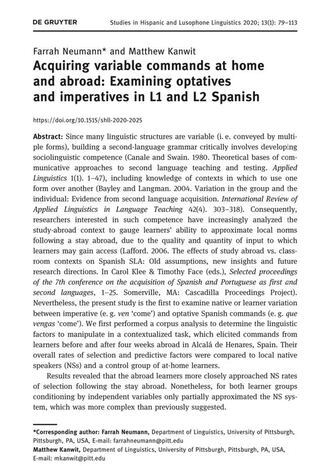
May 2020 - Pitt PhD student Farrah Neumann and I have published a new article in Studies in Hispanic and Lusophone Linguistics. We investigated variation between imperatives (e.g., come 'eat') and optatives (e.g., que comas 'eat'), comparing native speakers and learners in study abroad and at-home contexts. We include both a corpus analysis and the results of an elicitation task we designed.
Promotion and Tenure
|
April 2020, Pittsburgh, PA - I'm happy to share that I've been awarded tenure and promotion to Associate Professor in the Department of Linguistics at the University of Pittsburgh. I’m not foolish enough to think that this has come without an enormous amount of professional and personal support from so many of you in years recent and not so recent. I simply can't thank you enough.
|
Successful Defense for Dr. Terán
|
March 2020, Pittsburgh, PA (among other locales) - I'm thrilled to report that Dr. Virginia Terán successfully defended her dissertation on the acquisition of past-time expression in L2 Spanish. This was our department's first ever Zoom dissertation defense, and Virginia performed very admirably! I was happy to co-direct Virginia's dissertation with Dr. Yasuhiro Shirai of Case Western Reserve University. Dr. Alan Juffs and Dr. Shelome Gooden also helpfully served on Virginia's committee. ¡Felicidades, Dra. Terán!
|
Keynote Address
|
Feb. 2020, Athens, GA - I gave the keynote address at the University of Georgia's Crossroads Graduate Conference on February 15, 2020. The lecture was entitled "¿Será muy interesante o va a ser bien interesante? Combining approaches to analyze learner and native-speaker morphosyntactic variation" and demonstrated the value of combining strengths from multiple approaches to study under-reported forms found in both learner and native speech. The talk also offered practical advice for graduate students in building a body of ongoing, connected projects.
|
HLS at UTEP
Oct. 2019, El Paso, TX - I joined my PhD advisee Juan Berríos at the Hispanic Linguistics Symposium at the University of Texas at El Paso to present on variable noun-adjective ordering in Venezuelan Spanish, as we considered the roles of phonology (i.e., syllable length), semantics (i.e., semantic class of the ADJ), and lexical frequency in constraining this form of syntactic variation. Pitt PhD grad Dr. Margarita Jara Yupanqui (Associate Professor, University of Nevada at Las Vegas) also presented recent research on diminutivization.
Pictured: Juan, Margarita, and I at the conference reception following our presentations.
Pictured: Juan, Margarita, and I at the conference reception following our presentations.
Pitt Linguists at SLRF at MSU
Sept. 2019, E. Lansing, MI - Pitt Linguistics past and present was highly represented at the Second Language Research Forum at Michigan State University. Presenters/attendees included current graduate students Irene Soto Lucena, Ben Naismith, and Virginia Terán, along with Pitt PhD graduates Dr. Silvia Pisabarro Sarrió (University of Rhode Island), Dr. Nausica Marcos Miguel (Denison University), and Dr. Katherine Martin (Southern Illinois University), and Pitt BA graduate Wendy Guo (PhD student at University of Michigan).
My presentation was invited for a colloquium on the acquisition of variation, along with Dr. Xiaoshi Li, Dr. Suzanne Evans Wagner, and Dr. Irina Zaykovskaya of Michigan State University and Dr. Kimberly Geeslin of Indiana University. I presented on how combining variationist and concept-oriented approaches enabled an analysis to tease apart critical differences between lexical futures and the present indicative, revealing learner development while also being informed by the historical development (i.e., grammaticalization) of relevant forms.
Pictured: (left) catching up with Virginia Terán and Ben Naismith at the end of a conference day; (right) with Kim Geeslin, midway through a running tour of the MSU campus to decompress following our presentations.
My presentation was invited for a colloquium on the acquisition of variation, along with Dr. Xiaoshi Li, Dr. Suzanne Evans Wagner, and Dr. Irina Zaykovskaya of Michigan State University and Dr. Kimberly Geeslin of Indiana University. I presented on how combining variationist and concept-oriented approaches enabled an analysis to tease apart critical differences between lexical futures and the present indicative, revealing learner development while also being informed by the historical development (i.e., grammaticalization) of relevant forms.
Pictured: (left) catching up with Virginia Terán and Ben Naismith at the end of a conference day; (right) with Kim Geeslin, midway through a running tour of the MSU campus to decompress following our presentations.
First Two Advisees Begin Full-time Positions
August 2019 - I'm proud to report that my first two advisees begin their full-time academic positions this month. Silvia Pisabarro Sarrió joins the University of Rhode Island in the Dept. of Modern and Classical Languages and Literatures as Full-time Lecturer of Spanish and Coordinator of the Basic Language Program. Virginia Terán begins her stint as Full-time Lecturer of Spanish at Georgia College and State University in the Dept. of World Languages and Cultures.
Please join me in congratulating Silvia and Virginia on emerging from a very competitive job market with roles they're thrilled to begin.
Pictured (left to right): Silvia at her new institution's sign and Virginia's new departmental photo.
Please join me in congratulating Silvia and Virginia on emerging from a very competitive job market with roles they're thrilled to begin.
Pictured (left to right): Silvia at her new institution's sign and Virginia's new departmental photo.
Article in MLJ
|
May 2019 - I have a new article now available online and in print in the latest issue of The Modern Language Journal (MLJ). In this paper, I show that lexical futures, although they are formally similar to the present indicative (PI), can be differentiated from the PI as predicted by independent linguistic variables, that they reveal learner development, and that they are also important to study based on the form's propensity to grammaticalize into a morphological future cross-linguistically.
|
Article in Sociolinguistic Studies
|
May 2019 - My co-authored publication with Pitt graduate student Maritza Nemogá has now been published in Sociolinguistic Studies, slightly backdated to December 2018. In the article, we were able to elicit regularized tokens of andar 'to walk' in the preterit, in addition to the prescriptive, irregular form. We were the first to show that this form of variation can be predicted by independent linguistic and social factors.
|
Pitt 2019 Graduation
Pisabarro Sarrió Dissertation Defense
|
April 2019, Cathedral of Learning - My advisee Silvia Pisabarro Sarrió successfully defended her doctoral dissertation, Developing sociolinguistic competence through explicit instruction: the case of future-time expression in L2 Spanish. Congratulations on this great accomplishment, doctor!
Pictured: Dr. Adam van Compernolle (Carnegie Mellon University), me, Dr.(!) Silvia Pisabarro Sarrió, Dr. Alan Juffs (Pitt LING), and Dr. Richard Donato (Dept. of Instruction & Learning). |
AAAL Conference in Atlanta
|
March 2019, Atlanta - Pitt LING past and present was highly represented at the recent American Association for Applied Linguistics conference. I presented research with PhD student Matthew Hadodo on the extent to which use of the Spanish diminutive contributes to perceptions about gender, age, and sexuality.
Current faculty members Dr. Alan Juffs and Dr. Na-Rae Han also had presentations. Pitt PhD alums Dr. Paul Toth (Assoc. Prof., Temple Univ.) and Dr. Jenifer Larson-Hall (Assoc. Prof., Kitakyushu Univ.) played important roles in organizing a panel on SLA from multiple perspectives in the same L2 classroom and a workshop on graphical representation of data, respectively. Pitt PhD alum Dr. Katherine Martin (Assist. Prof., Southern Illinois Univ.) and Pitt LING BA alum Wendy Guo (Univ. of Michigan, PhD student in psycholinguistics) also presented their latest research findings at the conference. Pictured, top: Matthew Hadodo & I after presenting. Center: some quack. Bottom: Wendy Guo, Katherine Martin, Alan Juffs, & I. |
Article on Present Perfect / Preterit Variation
|
January 2019 - An article with my advisee, Virginia Terán, appeared in the December 2018 issue of Revista Española de Lingüística Aplicada / Spanish Journal of Applied Linguistics. We investigated how speakers in Tucumán, Argentina express the perfective past in oral interviews and a written preference task and report very high use of the present perfect in oral speech that was less robust in written preference data. Congratulations to Virginia on a first-authored publication!
|
Article on Electronic Chats
|
December 2018 - My article on Google Talk electronic chats between learners and native speakers of Spanish has now been published in the International Journal of the Linguistic Association of the Southwest (IJLASSO, formerly The Southwest Journal of Linguistics). Although the article appeared in print in December 2018, it has been back-dated to 2014 as the journal catches up on past issues.
|
HLS at UT Austin
|
October 2018, University of Texas (Austin) - Pitt Hispanic Linguistics was well-represented at the Hispanic Linguistics Symposium. Current students Virginia Terán and Farrah Neumann presented research, as did I. Pitt Hispanic Linguistics graduates Dr. Sarah Blackwell (Full Professor, University of Georgia) and Dr. Margarita Jara Yupanqui (Associate Professor, Univ. of Nevada at Las Vegas) also presented research.
Pictured: Virginia Terán and I (and a photo bomb from the Cathedral of Learning), with our presentation about variable noun-adjective ordering in Argentinean Spanish, as affected by lexical frequency, semantic class, and phonological factors. |
Article in SSLA
|
September 2018 - My new collaborative article with Kim Geeslin "Exploring Lexical Effects in Second Language Interpretation: The Case of Mood in Spanish Adverbial Clauses" has now been published in Studies in Second Language Acquisition. In the adverbial clause context, we show that individual lexical items play a role in morphosyntactic variation and that nuanced differences in interpretation exist for native speakers and highly advanced learners, even on items that prescriptively co-occur with only one form.
|
Article in IRAL
|
September 2018 - I coauthored an article with Margaret Quesada of the University of Georgia on the extent to which learners and native speakers (NSs) report difficulty understanding or finding acceptable sentences that contain Type I variation (i.e., variation between nativelike and non-nativelike structures) for verbs like gustar "to like." Whereas my research usually focuses on Type II variation (i.e., between native-like forms), this paper reveals that learners and NSs differentially attend to disparate forms of Type 1 variation, which is further exemplified by reading times across items. Results reveal that what NSs find most problematic is not what tends to be emphasized in learner classrooms.
|
Contribution to Cambridge Handbook of Spanish Linguistics
|
August 2018 - I authored a chapter in the new Cambridge Handbook of Spanish Linguistics. The chapter includes an overview of early work on second language (L2) variation and relevant constructs and issues in the field. It then details common methods used by L2 variationists and presents a review of L2 variationist research on Spanish structures. Finally, it turns to the acquisition of variation in study-abroad contexts and presents future directions and remaining questions for the field. The handbook is now available in Europe and will be released in the US in October.
|
Article in Foreign Language Annals
|
June 2018 - My collaborative first-authored article with Vanessa Elias and Rebecca Clay appeared in Foreign Language Annals. We investigate to what extent learners approximate native-like systems for selection for the intensifiers muy and bien in Spain and Mexico. Bien is more popular in Mexico than Spain and our results indicate that the learners follow the native-speaker lead in this regard, although independent linguistic variables play a less straightforward role.
|
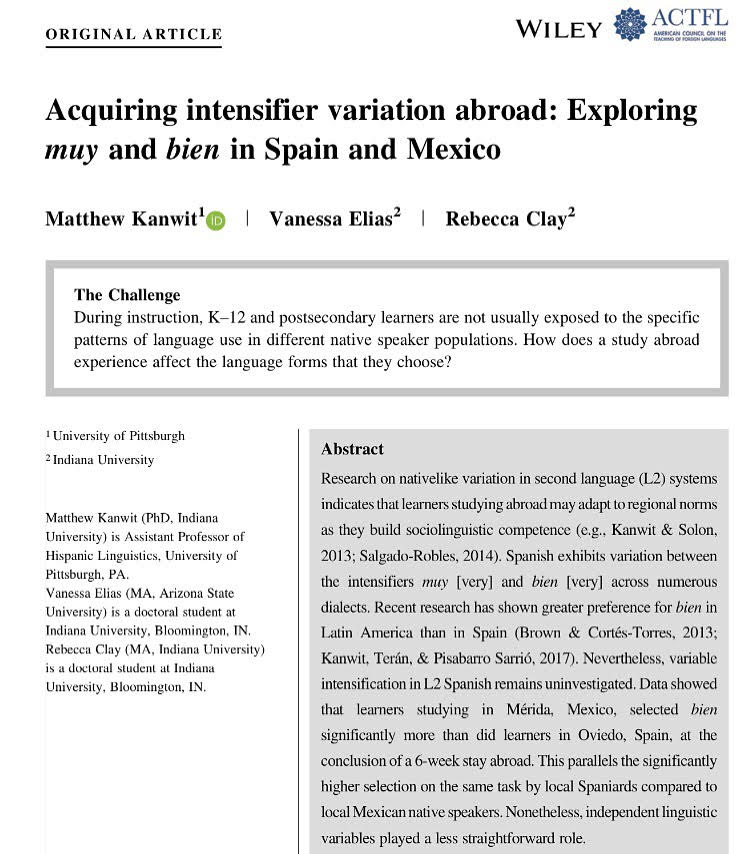
|
New Article in SLA Book
|
April 2018 - A collaborative article on acquiring sociolinguistic competence in a second language written with colleagues from across the country has just appeared in the edited volume Speaking in a Second Language.
More information can be found here: https://benjamins.com/catalog/aals.17.01gee |
Saluting 2018 Grads
|
April 2018, Cathedral of Learning - We held our annual reception to honor our graduates completing BA, MA, and PhD degrees in linguistics. It's always a highlight to meet the families of those who have worked so hard to complete their programs, to chat with students about what's next for post-graduation plans, and to see what colleagues have on tap for the summer.
Above: catching up with Melinda Fricke and meeting future linguist Malcolm. Below: staking claim to some infused water with Karen Park. |
WSS 2018 at Queens College (NYC)
|
April 2018, Queens College (NYC) - Five current and former members of Pitt Hispanic Linguistics presented at the 9th International Workshop on Spanish Sociolinguistics.
Above: Doctoral student Silvia Pisabarro Sarrió and I presented research on an instructional intervention to accelerate target-like acquisition of future-time expression. Below: Left to right - Pitt PhD graduates Dr. Susana de los Heros (Full Professor, University of Rhode Island), Dr. Laura Lenardón (Lecturer of Spanish / Coordinator of Spanish Language Program, University of Rhode Island), and Dr. Margarita Jara Yupanqui (Associate Professor, University of Nevada at Las Vegas) also presented their latest research. |
Cross-Disciplinary Conference at Pitt
|
March 2018, University of Pittsburgh - Pitt hosted a cross-disciplinary conference bringing together linguists and medical professionals, among other specialists, to discuss how greater awareness of linguistic diversity and language attitudes can enable healthcare professionals to provide excellent treatment to all patients, not just those who speak standard varieties. The Department of Linguistics was heavily involved in planning the conference, including Abdesalam Soudi, Shelome Gooden, Scott Kiesling, LaShanda Lemmon, and Allison Thompson.
Above: Shelome and Soudi offer a greeting to conference attendees. Below: I was apparently elated to encounter the lunch buffet. |
Evolving Perspectives on Advancedness
|
February 2018, University of Minnesota - Three members of Pitt's Hispanic Linguistics contingent presented at Evolving Perspectives on Advancedness, a symposium that featured international experts on second language acquisition. Doctoral student Virginia Terán (center) presented research on how learners resolve differing predictions from the discourse hypothesis and aspect hypothesis as they narrate events in the past. Dr. Nausica Marcos Miguel (left), Pitt PhD graduate and current Assistant Professor at Denison University, presented research on the correlation between learner performance on standardized testing and faculty impressions of performance. I presented research on how learners develop sensitivity to the temporal distances at which four forms of future-time expression are preferred. The former university presidents pictured behind us seem excited we're there?
|
New Acquisition of Variation Course
|
November 2017, Cathedral of Learning - Wrapping up the first offering of the undergraduate Acquisition of Variation course (LING 1650). Students wrote abstracts, designed tasks to elicit variable structures, and presented and wrote final projects implementing the tasks they designed. The course offered a good feel of what graduate school is like, but tailored to undergraduates. And we tried to fit in some laughter each day.
|
HLS 2017 at Texas Tech
|
October 2017, Texas Tech University - The research of five current members of the Pitt Linguistics community was presented at the Hispanic Linguistics Symposium. Silvia Pisabarro Sarrió (right) presented work on the expression of the future in both the Spanish and Catalan of bilingual speakers in Tarragona, Spain. Dr. Melinda Fricke and Farrah Neumann (second from left) considered the effects of study abroad on L1 and L2 perception of voice onset time. Farrah and I compared the acquisition of two types of command forms (imperatives and optatives) by learners studying abroad and learners studying in a traditional L2 classroom. Finally, Virginia Terán (left) and I presented variable morphosyntactic intensification among a tripartite intensifier system (muy, bien, and re) in Argentinean Spanish.
And there was some time to fit in a run in the warm Texas temps with Scott Schwenter to de-stress before our talks. |
SLRF 2017 at Ohio State
|
October 2017, The Ohio State University - Pitt was highly represented at the Second Language Research Forum. Above: I presented longitudinal research on the acquisition of lexical future forms.
Below from left to right: Nausica Marcos Miguel (PhD 2013, Assistant Professor at Dennison University), Mike Olsen (PhD 2013, Assistant Professor at University of Wisconsin Stevens Point), Alan Juffs, (Professor, Pitt), Natasha Tokowicz (Associate Professor, Pitt); Pitt graduate students Silvia Pisabarro and Farrah Neumann; some degenerate; and Noriyasu Li, post-doctoral researcher, Pitt. Not pictured: Patti Spinner (PhD 2007, Associate Professor, Michigan State University). |
All New Pitt Website
|
September 2017 - Pitt Linguistics has an all-new website, thanks to Na-Rae Han, Allison Thompson, Shelome Gooden, and LaShanda Lemmon. Below you can see that Amani Attia and I dutifully followed our website photo day instructions.
|
Article in Language Learning
|
June 2017 - My new article "What We Gain by Combining Variationist and Concept-Oriented Approaches: The Case of Acquiring Spanish Future-Time Expression" is available in the latest issue of Language Learning, published in June 2017. The paper uncovers the complexity of what has been referred to as the morphological stage of acquisition, showing that learners integrate new forms following the successive addition of new predictive factors. The use of a concept-oriented exploration to track emergence and changes in form–function relationships partnered with a variationist model revealed how such space was carved out developmentally.
|
Pitt LING Celebrates Grads
|
April 2017, Henderson Language Media Center - We held our annual celebration of graduate and undergraduate students completing linguistics degrees at Pitt. Students finishing doctoral degrees included Laura Lenardón, Noriyasu Li, Héctor Ramírez-Cruz, Holman Tse, and Zhaohong Wu. Here Karen Park and I captured a twinning moment.
|
HLS 2016 at Georgetown
|
October 2016, Georgetown University - Eight current and former members of the Pitt Hispanic Linguistics community presented research at the Hispanic Linguistics Symposium. Above, current department members Virginia Terán (top right) and Dr. Marta Ortega-Llebaria presented on the intonation of neutral interrogatives in the Spanish of Tucumán, Argentina; and Silvia Pisabarro Sarrió (top center) and I presented on variable morphosyntactic intensification in the Catalan and Spanish of Tarragona, Spain. I also presented on the L2 acquisition of variable intensification by study abroad learners in Spain and Mexico (with collaborators from Indiana University). Recent department graduates Dr. Carrie Bonilla (George Mason University), Dr. Nausica Marcos Miguel (Denison University), Dr. Michael Olsen (University of Wisconsin-Stevens Point), and Dr. Paul Toth (Temple University, bottom right) also presented original research projects.
Below, Kim Geeslin and I snuck in a run around the DC monuments for some low-oxygen cultural tourism before our talks. |
SLRF 2016 at Columbia
Saluting Our 2016 Graduates
|
April 2016, Henderson Language Media Center - Pitt Linguistics faculty held a reception to celebrate commencement for our undergraduate and graduate students. Clockwise from left: Allison Thompson, Shelome Gooden, Alan Juffs, Scott Kiesling, Claude Mauk, Abdesalam Soudi, Carrie Ankerstein, Amani Attia, Karen Park, me, Na-Rae Han.
May 2016, Outside Cathedral of Learning - Karen Park, Carrie Ankerstein, and I took a grading break at the Faculty and Staff Appreciation Picnic to rub elbows (paws?) with the Pitt Panther. |
Invited Colloquium Lecture at OSU
|
April 2016, The Ohio State University - I had a lot of fun giving an invited lecture in the Hispanic Linguistics Colloquium Series at OSU. My talk was entitled "There’s a future in this: Learner and native-speaker variable expression of futurity." If you don't like the picture, blame Scott Schwenter's camera skills. (Or my wayward hand.)
|
WSS 2016 in Puerto Rico
|
April 2016, University of Puerto Rico, Río Piedras - Pitt Hispanic Linguistics was well-represented at the 8th International Workshop on Spanish Sociolinguistics. Above, Maritza Nemogá (top center and bottom right), Silvia Pisabarro Sarrió (bottom center and bottom left), Virginia Terán (top left), and I presented a total of four individual and collaborative morphosyntactic research projects on variable intensification, the use of non-standard verbal forms, variable forms of address, and variation in past-perfective expression.
Below, having a conference in PR means being able to enjoy architecture and a manchego and chorizo sandwich in front of the Caribbean once it's all said and done. Click to zoom in. |
Linguist Runs
HLS 2015 at Illinois
|
September 2015, University of Illinois at Urbana-Champaign - Graduate students Virginia Terán (center) and Silvia Pisabarro Sarrió (right) and I presented original research entitled "Intensifier variation: a comparison of bien and muy in Tarragona, Spain and Tucumán, Argentina" at the Hispanic Linguistics Symposium. Virginia showed emotional fortitude in presenting while her foot was in a boot.
|
